Laird Connectivity 4X90200 RF Transceiver Module User Manual 4490 manual
AeroComm Corporation RF Transceiver Module 4490 manual
Contents
- 1. Users Manual 1
- 2. Users Manual 2
Users Manual 1
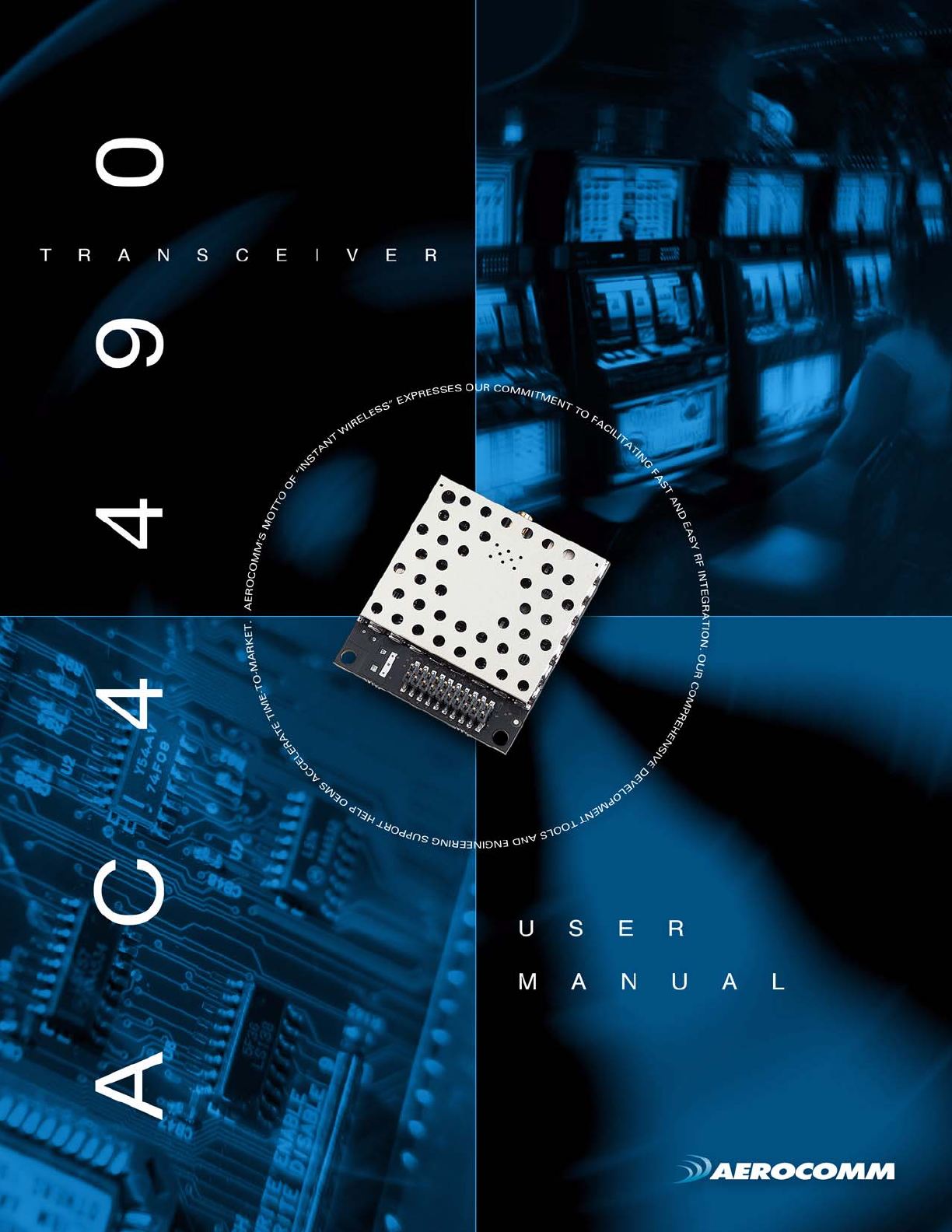
VERSION 3.1

Contents
AC4490 TRANSCEIVER MODULE 1
AC4490 features 1
Overview 1
SPECIFICATIONS 3
Pin Definitions 4
Electrical Specifications 6
THEORY OF OPERATION 7
RF Architecture 7
Modes of Operation 7
Transmit Mode 7
Receive Mode 7
Command Mode 8
API CONTROL 8
Receive API Packet 9
API Transmit Packet 9
API Send Data Complete 9
API Receive Packet 9
Protocol Status/Receive Acknowledgement 10
Protocol Status 10
Receive Acknowledgement 10
Long Range Mode 10
SERIAL INTERFACE 12
Serial Communications 12
Asynchronous Operation 12
Parity 12
OEM Host Data Rate 13
Serial Interface Baud Rate 13
Interface Timeout / RF Packet Size 14
Flow Control 15
Half Duplex / Full Duplex 15
System Timing & Latency 15
System Throughput 16
SOFTWARE INTERFACE 17
Networking 17
One Beacon Mode / Range Refresh 18
Auto Config Parameters 18
Interface Options 19
Modem Mode 19
RS485 Modem Mode 20
Max Power 20
TIMING DIAGRAMS 21
AC4490 Timing Diagrams 21
HARDWARE INTERFACE 23
Pin Definitions 23
Generic I/O 23
TXD & RXD 23
Hop Frame 23
CTS 23
GND 23
RTS 23
Test / 9600 Baud 24
RSSI 24
UP_Reset 25
Command/Data 25
AD In 25
CONFIGURING THE AC4490 26
AT Commands 27
On-the-Fly Control Commands 27
Command Descriptions 30
EEPROM PARAMETERS 36
DIMENSIONS 40
Mechanical Drawings 40
ORDERING INFORMATION 44
Product Part Number Tree 44
Developer Kit Part Numbers 44
COMPLIANCY INFORMATION 45
AC4490-1x1 45
Agency Identification Numbers 45
Approved Antenna List 45
FCC / IC Requirements for Modular Approval 46
OEM Equipment Labeling Requirements 46
Antenna Requirements 47
Warnings required in OEM Manuals 47
Channel Warning 47
APPENDIX I - SAMPLE POWER SUPPLY 48
Bill of Materials 48
Schematic 49
PCB Layout 49
APPENDIX II - 5V TO 3.3V LEVELS 51
Voltage Level Conversion IC’s 51
Passive Resistor Voltage Divider 51
APPENDIX III - API 52
Polling Network 52
Addressed Transmit API 53
Broadcast Transmit API 53
Receive API 54

DOCUMENT INFORMATION
Copyright © 2007 AeroComm, Inc. All rights reserved.
The information contained in this manual and the accompanying software programs are copyrighted and all rights are
reserved by AeroComm, Inc. AeroComm, Inc. reserves the right to make periodic modifications of this product without
obligation to notify any person or entity of such revision. Copying, duplicating, selling, or otherwise distributing any
part of this product or accompanying documentation/software without the prior consent of an authorized
representative of AeroComm, Inc. is strictly prohibited.
All brands and product names in this publication are registered trademarks or trademarks of their respective holders.
This material is preliminary
Information furnished by AeroComm in this specification is believed to be accurate. Devices sold by AeroComm are
covered by the warranty and patent indemnification provisions appearing in its Terms of Sale only. AeroComm makes
no warranty, express, statutory, and implied or by description, regarding the information set forth herein. AeroComm
reserves the right to change specifications at any time and without notice.
AeroComm’s products are intended for use in normal commercial and industrial applications. Applications requiring
unusual environmental requirements such as military, medical life-support or life-sustaining equipment are specifically
not recommended without additional testing for such application.
Limited Warranty, Disclaimer, Limitation of Liability
For a period of one (1) year from the date of purchase by the OEM customer, AeroComm warrants the OEM
transceiver against defects in materials and workmanship. AeroComm will not honor this warranty (and this warranty
will be automatically void) if there has been any (1) tampering, signs of tampering; 2) repair or attempt to repair by
anyone other than an AeroComm authorized technician.
This warranty does not cover and AeroComm will not be liable for, any damage or failure caused by misuse, abuse,
acts of God, accidents, electrical irregularity, or other causes beyond AeroComm’s control, or claim by other than the
original purchaser.
In no event shall AeroComm be responsible or liable for any damages arising: From the use of product; From the loss
of use, revenue or profit of the product; or As a result of any event, circumstance, action, or abuse beyond the control
of AeroComm, whether such damages be direct, indirect, consequential, special or otherwise and whether such
damages are incurred by the person to whom this warranty extends or third party.
If, after inspection, AeroComm determines that there is a defect, AeroComm will repair or replace the OEM transceiver
at their discretion. If the product is replaced, it may be a new or refurbished product.

DOCUMENT INFORMATION
Revision Description
Version 1.0 3/15/02 - Initial Release Version
Version 1.1 12/18/02 - Preliminary Release
Version 1.2 12/20/02 - Preliminary Release. Changed location of new interface pins for higher
compatibility with AC4424 family.
Version 1.3 1/29/03 - Updated interface baud rate formula/table. Updated current consumption
table. Corrected RSSI plot. Updated interface timeout information. Renamed
product family to AC4490. Multiple EEPROM read/write now allowed.
Version 1.4 2/18/03 - Added Max Power Byte. Removed Write Enable references. Fixed Power
Down/Up command response. Removed peer-to-peer bit. Added Auto Destination.
Added unicast only bit. Added 500 mW product. Revised part numbers. Updated
channel number settings.
Version 1.5 Not released.
Version 1.6 11/07/03 - Added One beacon and modem modes. Included AC4486 product line.
Added 500 mW specifications. Updated part numbers. Added AT Commands.
Eliminated Commercial designation; All transceivers are now Industrial qualified.
Version 1.7 7/9/04 - Changed Range Refresh so 0x00 is an invalid setting. Updated AC4490-500
output power. Added warranty information. Updated part numbers. Removed
support of One Beacon mode. Added DES.
Version 1.8 1/03/04 - Changed minimum timeout at 19,200 to 3. Added support for One Beacon
mode. Changed voltage requirements for -200. Added on the fly read temperature
and EEPROM read/write commands. Removed AC4486 product information. Added
Auto Channel.
Version 1.9 7/29/05 - Removed documentation for static commands. Added Australian channels.
Added CC 26 command. Updated mechanical drawing for MMXC version. Included
new RSSI table. Added 1x1 documentation. Added Protocol Status, Received
Acknowledgement, and Receive API modes.
Version 2.0 9/06/05 - Added Appendix 1 - Sample Power Supply
Version 2.1 10/06/05 - Added CC 27 command. Added Long Range mode. Added EEPROM
write warning.
Version 2.2 11/08/05 - Removed CC 27 command. Removed Long Range mode. Corrected RS-
485 DE Control.
Version 2.3 12/20/05 - Removed stream mode documentation. Added Enhanced API commands.
Updated Australian channels.
Version 2.4 Not released.
Version 2.5 7/03/06 - Removed sub hop adjust documentation. Removed Configuration Mode
documentation. Added Probe command. Added Max Power Backup byte (address
0x8E). Added Product ID bytes (addresses 0x90 - 0x9F). Changed default Enhanced
API value to 0xF8. Added Serial Communications documentation. Added 4490LR-
200 documentation. Updated ording information and product tree. Added Appendix
II - 5V to 3.3V levels. Added Appendix III - API. Added Appendix IV - Sync to Channel.

DOCUMENT INFORMATION
Version 2.6 7/13/06 - Added AC4490LR-1000 documentation. Added Long Range documentation
and EEPROM parameters. Removed Read/Write API Control Commands. Updated
ordering information and product tree.
Version 2.7 8/3/06 - Added Table of Contents.
Version 2.8 10/16/06 - Updated Approved Antenna List.
Version 2.9 1/9/07 - Updated Approved Antenna List. Updated Agency Identification numbers.
Version 3.0 2/1/07 - Added CMD/Data RX disable and RS485 Modem Modes. Added Industrial
Temperature enhancement information and commands. Changed range refresh
defintion for servers with sync-to-channel enabled and updated sync-to-channel
information.
Version 3.1 7/8/07 - Updated Approved Antenna List. Updated Agency Identification numbers.
Revision Description

www.aerocomm.com
AC4490 TRANSCEIVER MODULE
1
The compact AC4490 900MHz transceiver can replace miles of cable in harsh industrial environments. Using field-proven
FHSS technology which needs no additional FCC licensing in the Americas, OEMs can easily make existing systems wireless
with little or no RF expertise.
AC4490 FEATURES
NETWORKING AND SECURITY
• Drop-in replacement for AC4424 2.4 GHz product family
• Generic I/O digital lines and integrated DAC/ADC functions
• Retries and Acknowledgements
• API Commands to control packet routing and acknowledgement on a packet-by-packet basis
• Frequency Hopping Spread Spectrum for security and interference rejection
• Customizable RF Channel number and system ID
• Dynamic link analysis, remote radio discovery
• Low latency and high throughput
• Hardware Protocol Status monitoring
EASY TO USE
• Continuous 76.8 kbps RF data stream
• Software selectable interface baud rates from 1200 bps to 115.2 kbps
• Low cost, low power and small size ideal for high volume, portable and battery powered
applications
• All modules are qualified for Industrial temperatures (-40°C to 80°C)
• Advanced configuration available using AT commands
OVERVIEW
The AC4490 is a member of AeroComm’s ConnexRF OEM transceiver family. The AC4490 is a cost effective, high
performance, frequency hopping spread spectrum transceiver; designed for integration into OEM systems operating
under FCC part 15.247 regulations for the 900 MHz ISM band.
AC4490 transceivers provide an asynchronous TTL/RS-485 level serial interface for OEM Host communications.
Communications include both system and configuration data. The Host supplies system data for transmission to
other Host(s). Configuration data is stored in the on-board EEPROM. All frequency hopping, synchronization, and RF
system data transmission/reception is performed by the transceiver.
To boost data integrity and security, the AC4490 uses AeroComm’s field-proven FHSS technology featuring optional
Data-Encryption Standards (DES). Fully transparent, these transceivers operate seamlessly in serial cable
replacement applications.
AC4490 transceivers can operate in a Point-to-Point, Point-to-Multipoint, Client-Server, or Peer-to-Peer architecture.
One transceiver is configured as a Server and there can be one or many Clients. To establish synchronization
between transceivers, the Server emits a beacon. Upon detecting a beacon, the Client transceiver informs its Host
and an RF link is established.

AC4490 TRANSCEIVER MODULE
2
This document contains information about the hardware and software interface between an AeroComm AC4490
transceiver and an OEM Host. Information includes the theory of operation, specifications, interface definition,
configuration information and mechanical drawings. The OEM is responsible for ensuring the final product meets all
appropriate regulatory agency requirements listed herein before selling any product.
Note: Unless mentioned specifically by name, the AC4490 modules will be referred to as the “radio” or “transceiver”.
Individual naming is used to differentiate product specific features. The host (PC/Microcontroller/Any device to which
the AC4490 module is connected) will be referred to as “OEM Host”.
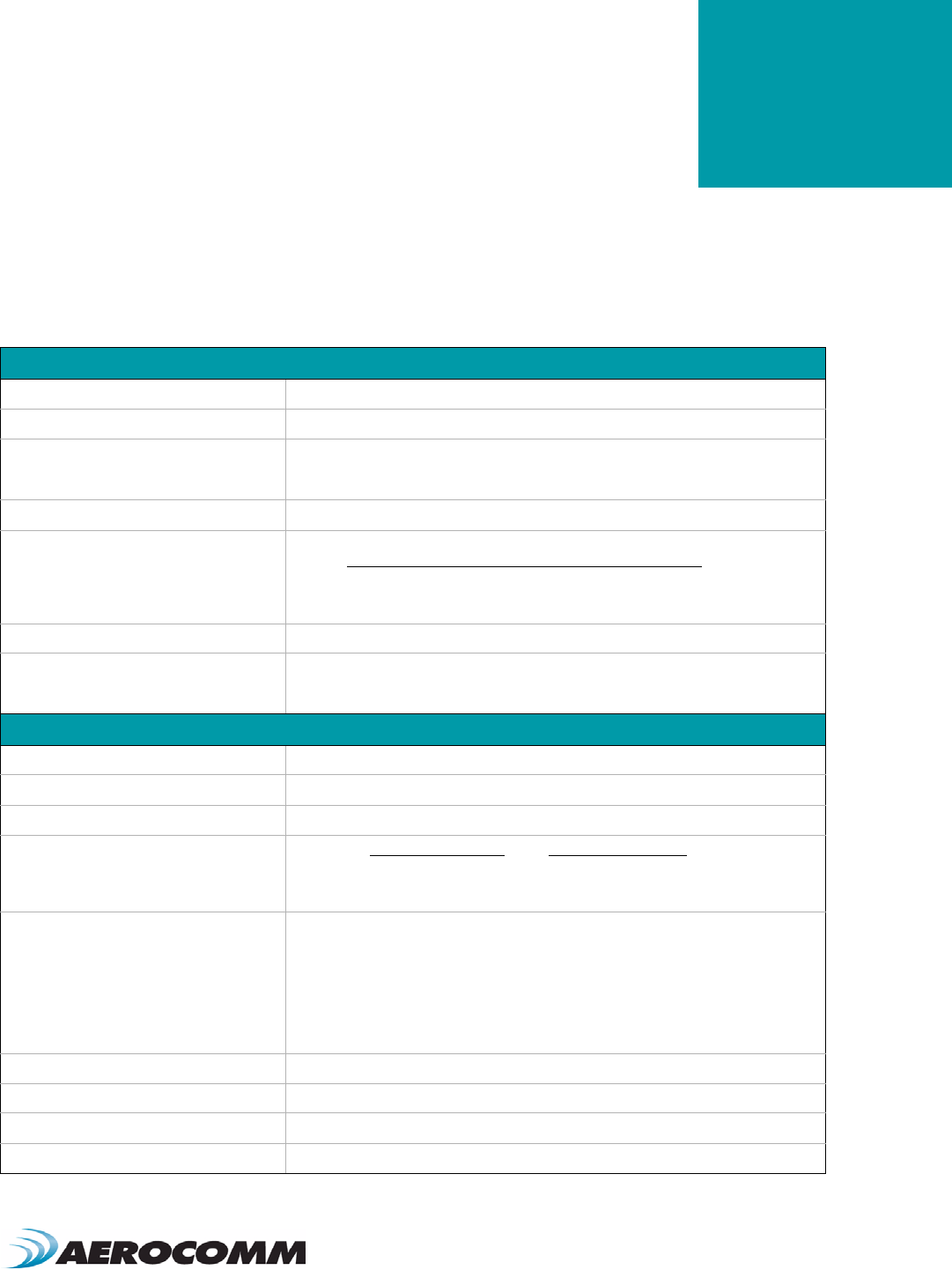
www.aerocomm.com
SPECIFICATIONS
2
Table 1: AC4490 Specifications
General
20 Pin Interface Connector Molex 87759-0030, mates with Samtec SMM-110-02-S-D
RF Connector Johnson Components 135-3711-822
Antenna AC4490-1x1: Customer must provide
AC4490-200: MMCX Connector or integral antenna
AC4490-1000: MMCX Connector
Serial Interface Data Rate Baud rates from 1200 bps to 115,200 bps
Power Consumption (typical) Duty Cycle (TX=Transmit; RX=Receive)
10%TX 50%TX 100%TX 100%RX Pwr-Down Deep Sleep
1x1: 33mA 54mA 80mA 28mA 15mA 3mA
200: 38mA 68mA 106mA 30mA 19mA 6mA
1000: 130mA 650mA 1300mA 30mA 19mA 6mA
Channels 3 Channel Sets comprising 56 total channels
Security One byte System ID. 56-bit DES encryption key.
Interface Buffer Size Input/Output:256 bytes each
Transceiver
Frequency Band 902 – 928 MHz
RF Data Rate 76.8 kbps fixed
RF Technology Frequency Hopping Spread Spectrum
Output Power Conducted (no antenna) EIRP (3dBi gain antenna)
AC4490-1x1: 10mW typical 20mW typical
AC4490-200: 100mW typical 200mW typical
AC4490-1000: 743mW typical 1486mW typical
Supply Voltage AC4490-1x1: 3.3V, ±50mV ripple
AC4490-200: 3.3 – 5.5V, ±50mV ripple
AC4490-1000*: Pin 10: 3.3 – 5.5V ±50mV ripple
Pin 11: 3.3 ±3%, ±100mV ripple
* Pins 10 and 11 may be tied together, provided the supply voltage never falls below 3.3 V and
is capable of supplying 1.5 A of current. Pins 10 & 11 are internally connected on the AC4490-
200 only.
Sensitivity -100dBm typical @ 76.8kbps RF Data Rate
-110dBm typical @ 76.8kbps RF Data Rate (AC4490LR-200/-1000)
EEPROM write cycles 20000
Hop period 20 ms
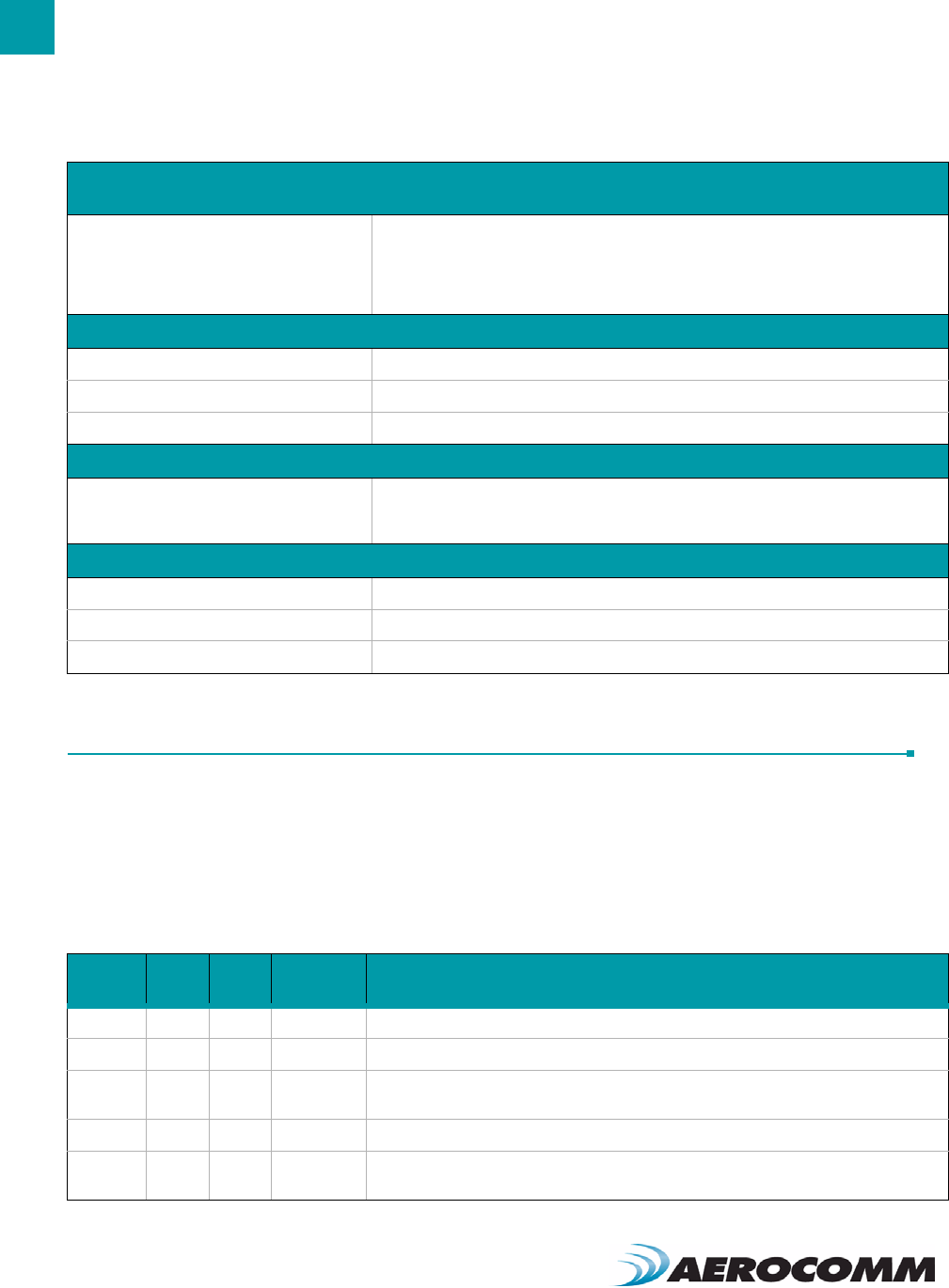
SPECIFICATIONS
4
PIN DEFINITIONS
The AC4490 has a simple interface that allows OEM Host communications with the transceiver. The table below
shows the connector pin numbers and associated functions. The I/O direction is with respect to the transceiver. All
outputs are 3.3VDC levels and inputs are 5VDC TTL (with the exception of AC4490-1x1 and AC4490-1000 transceivers
which have 3.3V inputs). All inputs are weakly pulled High and may be left floating during normal operation (with the
exceptions listed for the AC4490-1x1).
Transceiver (Cont’d)
Range, Line of Site (based on 3dBi gain
antenna)
AC4490-1x1: Up to 1 mile
AC4490-200: Up to 4 miles
AC4490LR-200: Up to 8 miles
AC4490-1000: Up to 20 miles
AC4490LR-1000: Up to 40 miles
Environmental
Temperature (Operating) -40°C to 80°C
Temperature (Storage) -50°C to +85°C
Humidity (non-condensing) 10% to 90%
Physical
Dimensions Transceiver with MMCX Connector: 1.65” x 1.9” x 0.20”
Transceiver with Integral Antenna: 1.65” x 2.65” x 0.20”
AC4490-1x1: 1.00” x 1.00” x 0.162”
Certifications
AC4490-200A AC4490-200/AC4490LR-200 AC4490-1000
FCC Part 15.247 KQLAC4490-100 KQL-4x90200 KQLAC4490
Industry Canada (IC) 2268C-AC4490 2268C-4x90200 2268C-AC44901000
Table 2: AC4490 Pin Definitions
Module
Pin
1x1
Pin Type Signal
Name Function
1 4 O GO0 Generic Output pin
2 6 O TXD Transmitted data out of the transceiver
I/O RS485 A
(True)1
Non-inverted RS-485 representation of serial data
3 7 I RXD Data input to the transceiver
I/O RS485 B
(Invert) 1
Mirror image of RS-485 A
Table 1: AC4490 Specifications
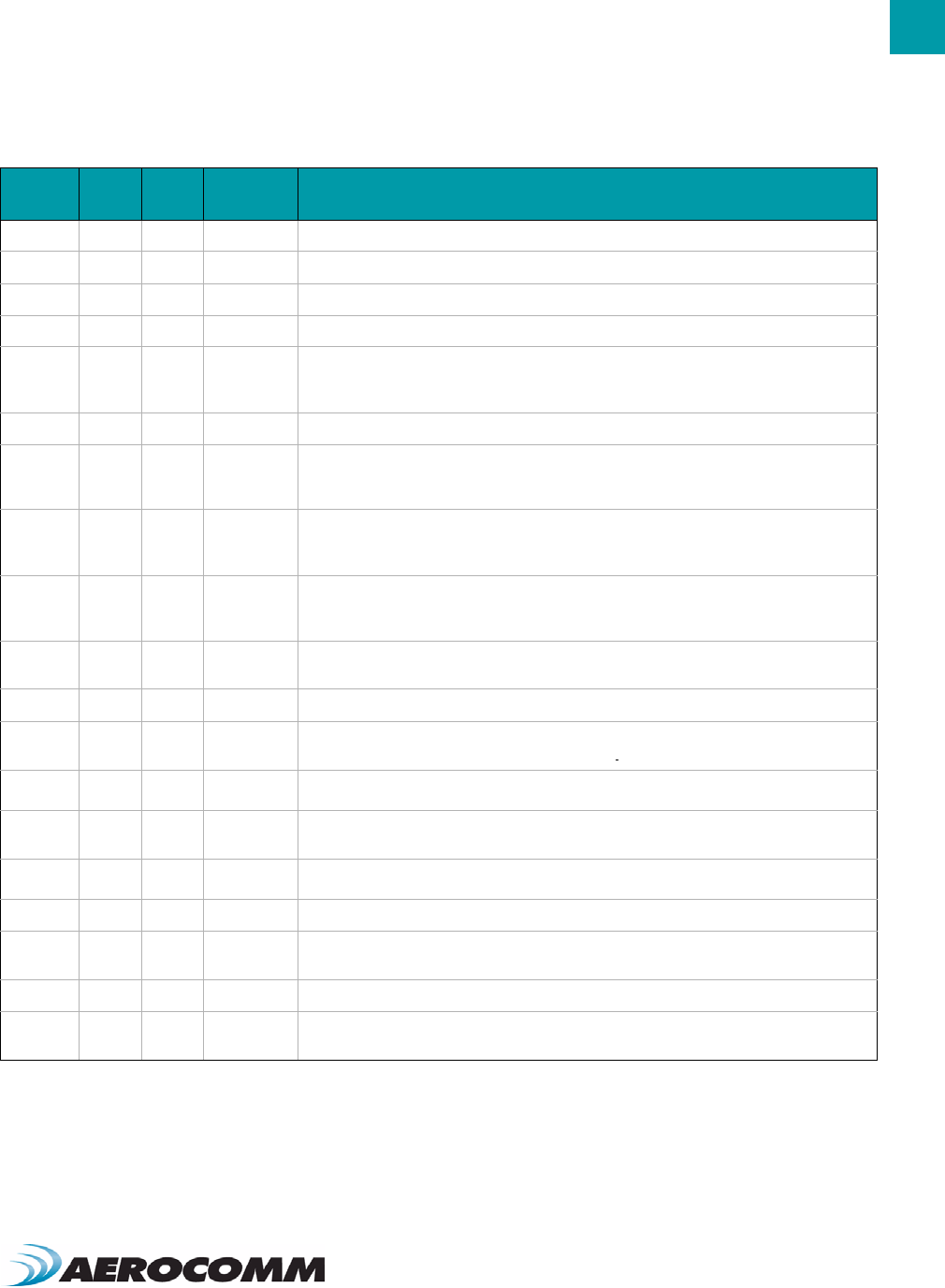
5
SPECIFICATIONS
www.aerocomm.com
4 52GI0 Generic Input pin
5 3 GND GND Signal Ground
6 O Hop Frame Pulses low when the transceiver is hopping frequencies.
7 9 O CTS Clear to Send – Active Low when the transceiver is ready to accept data for transmission.
8102IRTS Request to Send – When enabled in EEPROM, the OEM Host can take this High when it is not
ready to accept data from the transceiver. NOTE: Keeping RTS High for too long can cause
data loss.
919 OGO1 Generic Output pin
10 2PWR VCC1 AC4490-1x1: 3.3V, ±50mV ripple
AC4490-200: 3.3 – 5.5V, ±50mV ripple (Pin 10 is internally connected to Pin 11)
AC4490-1000: 3.3 – 5.5V, ±50mV ripple
11 11 PWR VCC2 AC4490-1x1: 3.3V, ±50mV ripple
AC4490-200: 3.3 – 5.5V, ±50mV ripple (Pin 11 is internally connected to Pin 10)
AC4490-1000: 3.3V ±3%, ±100mV ripple
12 23 ITest Test Mode – When pulled logic Low and then applying power or resetting, the transceiver’s
serial interface is forced to a 9600, 8-N-1 rate. To exit, the transceiver must be reset or power-
cycled with Test Mode logic High.
13 12 ORSSI Received Signal Strength - An analog output giving an instantaneous indication of received
signal strength. Only valid while in Receive Mode.
14 212IGI1 Generic Input pin
15 16 IUP_RESET RESET – Controlled by the AC4490 for power-on reset if left unconnected. After a stable power-
on reset, a logic High pulse will reset the transceiver.
16 13 GND GND Signal Ground
17 17 ICMD/Data When logic Low, the transceiver interprets OEM Host data as command data. When logic High,
the transceiver interprets OEM Host data as transmit data.
18 153IAD In 10 bit Analog Data Input
19 204ODA_Out 10 bit Analog Data Output
20 18 OIn_Range When logic Low, a Client is in range of a Server on same Channel and System ID. Always low on
a Server radio.
N/A 14 RF RF Port RF Interface
N/A 22 IReset Active Low version of UP_RESET. If RESET is used, UP_RESET should be left floating and if
UP_RESET is used, RESET should be left floating.
1. When ordered with a RS-485 interface (not available on the AC4490-1x1).
2. Must be tied to VCC or GND if not used. Should never be permitted to float.
3. If used, requires a shunt 0.1μF capacitor at pin 15 followed by a series 1k resistor.
4. If used, requires a series 1k resistor at pin 20 followed by a shunt 0.1μF capacitor.
Table 2: AC4490 Pin Definitions
Module
Pin
1x1
Pin Type Signal
Name Function

SPECIFICATIONS
6
ELECTRICAL SPECIFICATIONS
Table 3: Input Voltage Characteristics
AC44901x1 / AC4490-1000M AC4490-200X
Signal Name High
Min.
High
Max.
Low
Min.
Low
Max.
High
Min.
High
Max.
Low
Min.
Low
Max. Unit
RS485A/B N/A 12 -7 N/A N/A 12 -7 N/A V
RXD 2.31 3.3 00.99 25.5 00.8 V
GI0 2.31 3.3 00.99 25.5 00.8 V
RTS 2.31 3.3 00.99 25.5 00.8 V
Test 2.31 3.3 00.99 25.5 00.8 V
GI1 2.31 3.3 00.99 25.5 00.8 V
UP_RESET 0.8 3.3 00.6 0.8 5 0 0.6 V
Command/Data 2.31 3.3 00.99 25.5 00.8 V
AD In N/A 3.3 0N/A N/A 3.3 0N/A V
Table 4: Output Voltage Characteristics
Signal Name Module
Pin
1x1
Pin Type High
Min.
Low
Max. Unit
GO0 119 O2.5 @ 8mA 0.4 @ 8mA V
TXD 2 6 O 2.5 @ 2mA 0.4 @ 2mA V
RS485A/B 2,3 N/A I/O 3.3 @ 1/8 Unit Load N/A V
Hop Frame 6 1 O 2.5 @ 2mA 0.4 @ 2mA V
CTS 7 9 O 2.5 @ 2mA 0.4 @ 2mA V
GO1 919 O2.5 @ 2mA 0.4 @ 2mA V
RSSI 13 12 OSee Figure 1 See Figure 1 V
DA_Out 19 20 ON/A N/A V1
1. DA_Out is an unbuffered, high impedance output and must be buffered by the OEM Host when used.
In Range 20 18 O2.5 @ 2mA 0.4 @ 2mA V

www.aerocomm.com
THEORY OF OPERATION
3
RF ARCHITECTURE
The AC4490 utilizes a Server-Client network where all Clients synchronize their hopping to the Server. The Server
transmits a beacon during the first 1 ms of every hop (20 ms). The Client transceivers listen for this beacon and upon
hearing it assert their In_Range Low and synchronize their hopping with the Server.
Each network should consist of only one Server and there should never be two servers on the same RF Channel
number in the same coverage area as the interference between the two servers will severely hinder RF
communications. For those applications requiring collocated servers, Aerocomm recommends using the Sync-to-
Channel feature which is further explained in the Sync-to-Channel Appendix.
MODES OF OPERATION
The AC4490 has three different operating modes; Receive, Transmit, & Command Mode. If the transceiver is not
communicating with another radio, it will be in Receive Mode actively listening for a beacon from the Server. If the
Client determines that the beacon is from a server operating on the same RF Channel and System ID, it will respond
by asserting In_Range Low. A transceiver will enter Transmit or Command mode when the OEM Host sends data over
the serial interface. The state of the Command/Data pin (Pin 17) or the data contents determine which of the two
modes will be entered.
Transmit Mode
All packets sent over the RF are either Addressed or Broadcast packets. Broadcast and Addressed delivery can be
controlled dynamically with the API Control byte and corresponding on-the-fly commands. To prohibit transceivers
from receiving broadcast packets, Unicast only can be enabled.
ADDRESSED PACKETS
When sending an addressed packet, the RF packet is sent only to the receiver specified in destination address. To
increase the odds of successful delivery, Transmit retries are utilized. transparent to the OEM Host; the sending radio
will send the RF packet to the intended receiver. If the receiver receives the packet free of errors, it will return an RF
acknowledge within the same 20 ms hop. If a receive acknowledgement is not received, the radio will use a transmit
retry to resend the packet. The radio will continue sending the packet until either (1) an acknowledgement is received
or (2) all transmit retries have been used. The received packet will only be sent to the OEM Host if and when it is
received free of errors.
BROADCAST PACKETS
When sending a broadcast packet, the RF packet is sent out to every eligible transceiver on the network. To increase
the odds of successful delivery, Broadcast attempts are utilized. Transparent to the OEM Host, the sending radio will
send the RF packet to the intended receiver(s). Unlike transmit retries, all broadcast attempts are used; regardless of
when the RF packet is actually received and without RF acknowledgements. If the packet is received on the first
attempt, the receiver will ignore the remaining broadcast attempts. The received packet will only be sent to the OEM
Host if and when it is received free of errors.
Receive Mode
When a transceiver is not in Transmit or Command mode, it will be in Receive Mode listening for data. While in
Receive Mode, subsequent data of up to 80 bytes can be received every hop (20 ms).
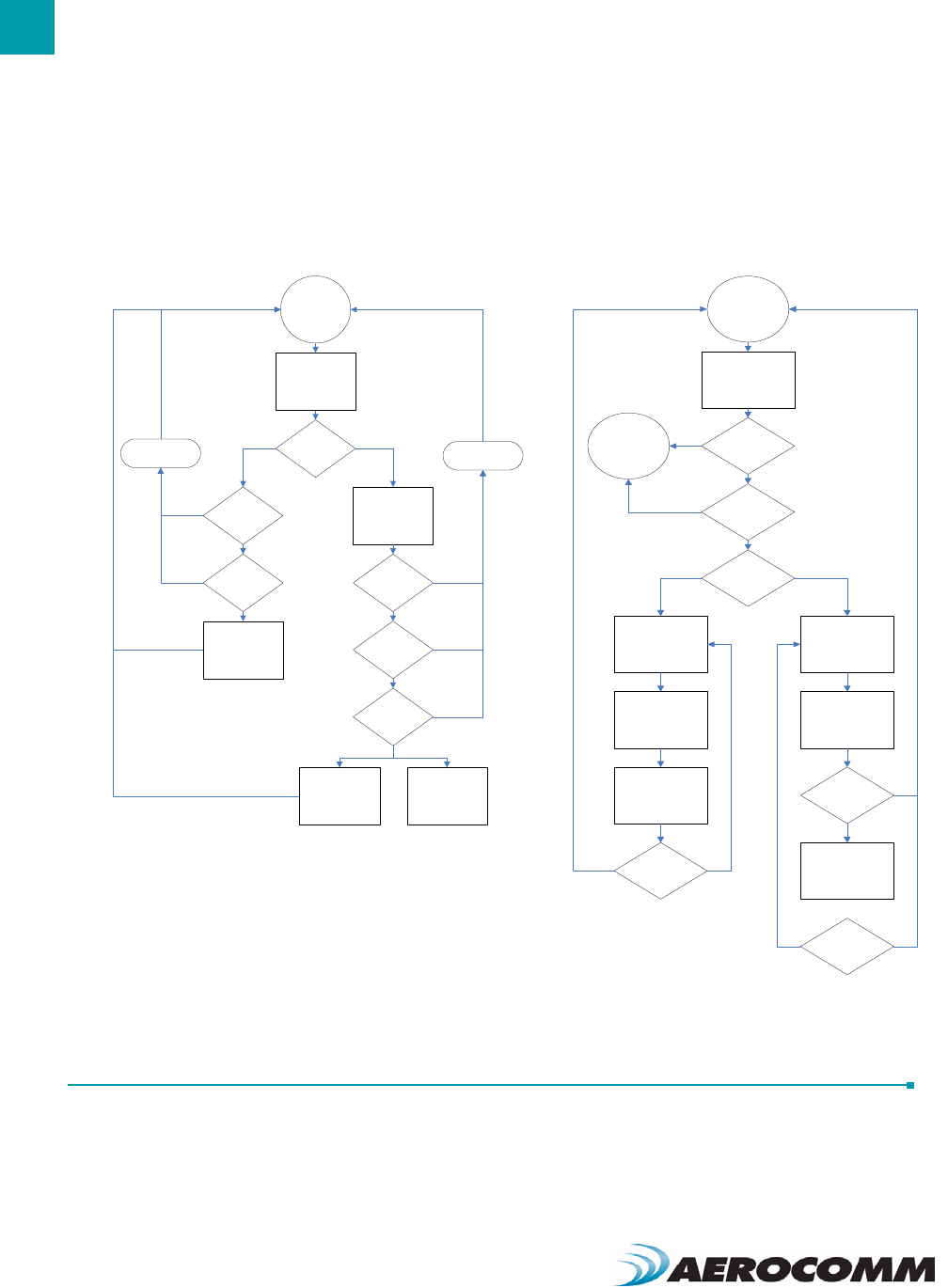
THEORY OF OPERATION
8
Command Mode
A radio will enter Command Mode when data is received over the serial interface from the OEM Host and either the
Command/Data pin (pin 17) is logic Low or the received data contains the “AT+++” (Enter AT Command Mode)
command. Once in Command Mode, all data received by the radio is interpreted as command data. Command Data
can be either EEPROM Configuration or On-The-Fly commands.
Figure 1: Pending RF and Data in Buffer Flow
API CONTROL
API Control is a powerful feature that the AC4490 offers. When enabled, the API Receive Packet, API Transmit Packet,
API Send Data Complete and Enhanced API Receive Packet features provide dynamic packet routing and packet
accounting ability to the OEM Host, thereby eliminating the need for extensive programming on the OEM Host side.
This ability of the protocol makes it ideal for any legacy system. API operation utilizes specific packet formats;
Receive Mode
Broadcast
Packet
Receive full
packet and
check CRC Addressed Packet
Matching
Destination
MAC
Validate CRC
Duplicate
Packet
Send RF
Acknowledge
Send Packet over
RF
Duplicate
Packet
Discard Packet
Discard Packet
Send Packet over
RF
Pending RF
Received
Yes
Yes
Yes
Yes
Yes
Yes
Receive Mode
Pin 17 Low
Data in Buffer
AT+++
RF Data
Broadcast Packet
Addressed Packet
Transmit Packet
Transmit Packet
Decrement
Broadcast
Attem pts
Broadcast
Attempts = 0
Receive ACK
Decrement
Transmit Attempts
Transmit
Attempts = 0
Command/Data
Mode
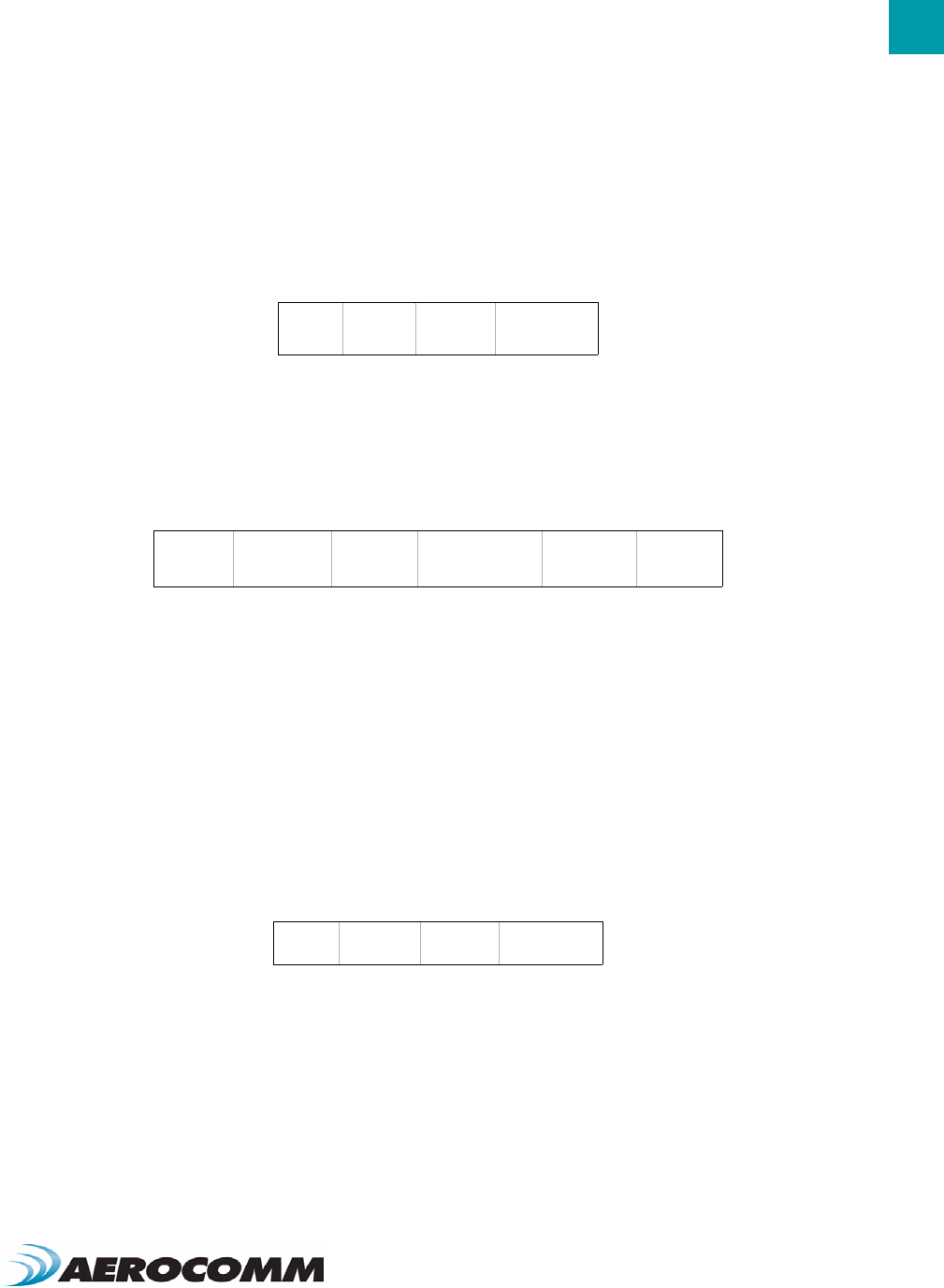
9
THEORY OF OPERATION
www.aerocomm.com
specifying various vital parameters used to control radio settings and packet routing on a packet-by-packet basis.
The API features can be used in any combination that suits the OEM’s specific needs.
Receive API Packet
Implemented in v6.3 of the firmware and later. Receive API Packet can be enabled to determine the sender of a
message. This causes the radio to append a header to the received packet detailing the length of the data packet and
the sender’s MAC address. The Receive API Packet will follow the following format.
API Transmit Packet
Implemented in v6.7 of the firmware and later. API Transmit Packet is a powerful command that allows the OEM Host
to send data to a single or multiple (broadcast) transceivers on a packet-by-packet basis. This can be useful for many
applications; including polling and/or mesh networks. Refer to the API Appendix for further details.
API Transmit Packet is enabled when bit-1 of the Enhanced API Control byte is enabled. The OEM Host should use
the following format to transmit a packet over the RF.
1If the OEM Host does not encode the header correctly, the transceiver will send the entire string (up
to 80 bytes) and will look for the header in the next data.
2Although the 7 bytes of overhead are not sent over the RF, they are kept in the buffer until the packet
is sent. Keep this in mind so as not to overrun the 256-byte buffer.
3Setting the MAC to 0xFF 0xFF 0xFF will broadcast the packet to all available transceivers.
API Send Data Complete
Implemented in v6.7 of the firmware and later. API Send Data complete can be used as a software acknowledgement
indicator. When a radio sends an addressed packet, it will look for a received acknowledgement (transparent to OEM
Host). If an acknowledgement is not received, the packet will be retransmitted until one is received or all retries have
been used.
API Send Data Complete is enabled when bit-2 of the Enhanced API Control byte is enabled. The transceiver sends
the OEM Host the following data upon receiving an RF acknowledge or exhausting all attempts.
1RSSI* is how strong the local transceiver heard the remote transceiver.
2Successful RF Acknowledge updates the Success/Failure bit.
3A success will always be displayed when sending broadcast packets after all broadcast attempts
have been exhausted.
API Receive Packet
Implemented in v6.7 of the firmware and later. By default, the source MAC is not included in the received data string
sent to the OEM Host. For applications where multiple radios are sending data, it may be necessary to determine the
origin of a specific data packet. When API Receive Packet is enabled, all packets received by the transceiver will
0x83
Payload
Data
Length
Sender’s
MAC Payload Data
0x81
Payload Data
Length
(0x01 - 0x80)
Aerocomm
Use
Transmit
Retries/Broadcast
Attempts
Destination
MAC (2,1,0)
Payload
Data
0x82 Aerocomm
Use RSSI* 0x00: Failure
0x01: Success
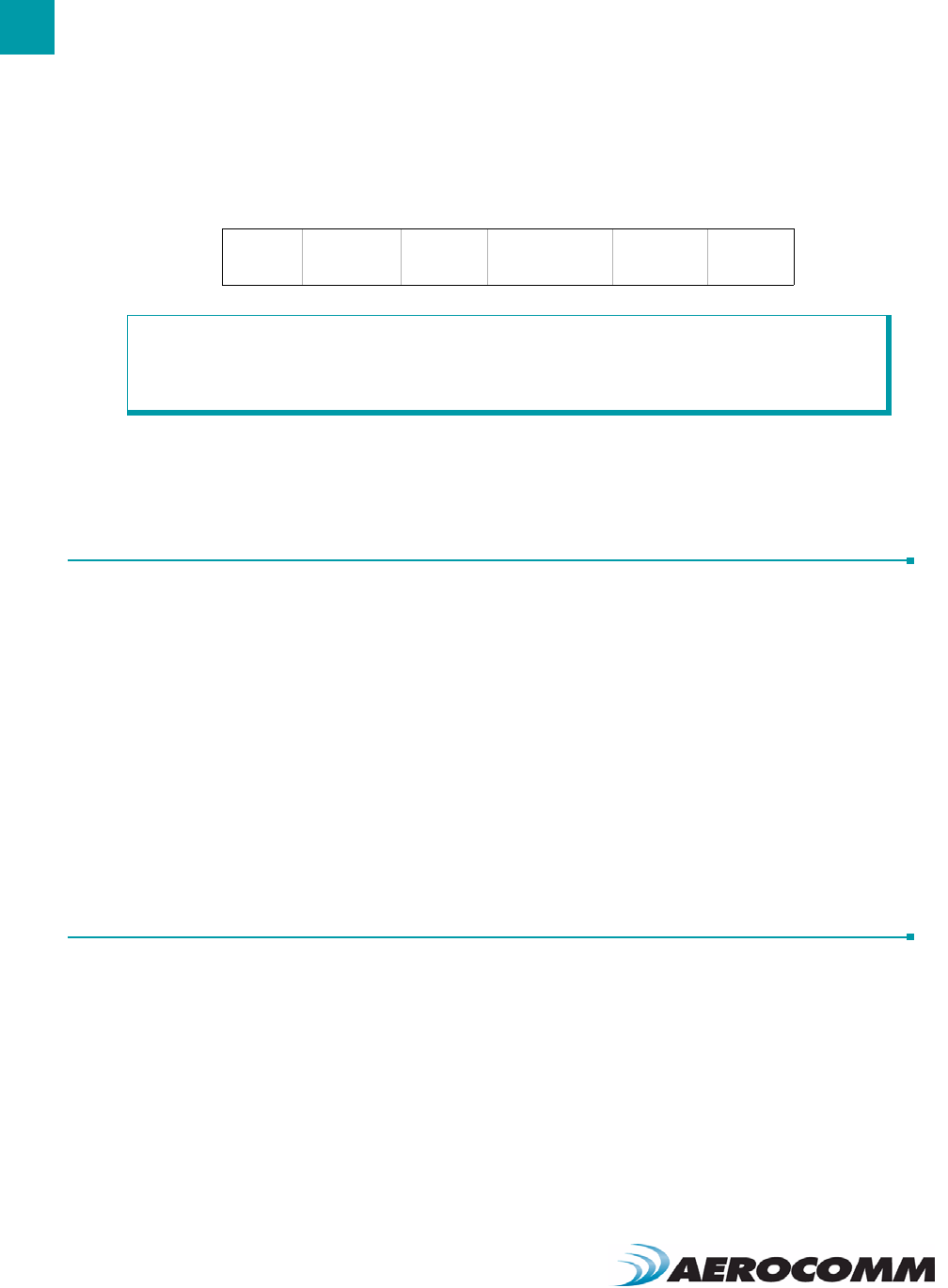
THEORY OF OPERATION
10
include the MAC address of the source radio as well as an RSSI indicator which can be used to determine the link
quality between the two.
API Receive Packet is enabled when bit-0 of the Enhanced API Control byte is enabled. Upon receiving a packet the
radio sends its OEM Host the packet in the following format:
Note: If Enhanced Receive API is enabled, the Receive API feature should be disabled by setting EEPROM byte 0xC1
to 0xFF.
PROTOCOL STATUS/RECEIVE ACKNOWLEDGEMENT
Implemented in v6.3 of the firmware and later. When enabled in EEPROM, GO0 and GO1 will perform the functions of
Protocol Status and Receive Acknowledgement.
Protocol Status
Every time the radio hops to hop bin 0, the radios will assert GO0 Low for the entire hop bin. GO0 will go Low at the
falling edge of the Hop Frame at the start of bin 0 and will go High with the rising edge of Hop Frame at the end of bin
0. During all other hops, GO0 will be high. This mode is incompatible with modem mode.
Receive Acknowledgement
The radio uses GO1 to signal that a valid RF acknowledgement has been received from the remote radio. GO1 is
normally Low and will go High within approximately 75 us of receivinng a valid RF acknowledgement. It will remain
High until the end (rising edge) of the next hop. This mode is incompatible with Modem mode.
LONG RANGE MODE
Specific to the AC4490LR-200 and AC4490LR-1000 transceivers, Long Range mode increases the receiver sensitivity
and range of the radio when enabled in EEPROM. Under some circumstances, such as in areas with extrememly high
interference levels, Long Range Mode may provide unsatisfactory results. In such cases, normal radio operation can
be achieved by disabling Long Range Mode; either temporarily using CC Commands or permanently by writing to the
EEPROM.
0x81
Payload Data
Length
(0x01 - 0x80)
Aerocomm
Use RSSI* Source MAC
(2,1,0)
Payload
Data
ENGINEER’S TIP
When both API Send Data Complete and API Receive Packet are enabled, the Send Data
Complete will be received before the transceiver sees the Receive API Packet. This order may
get reversed when the API Send Data Complete is missed and is being resent after the API
Receive Packet is received.
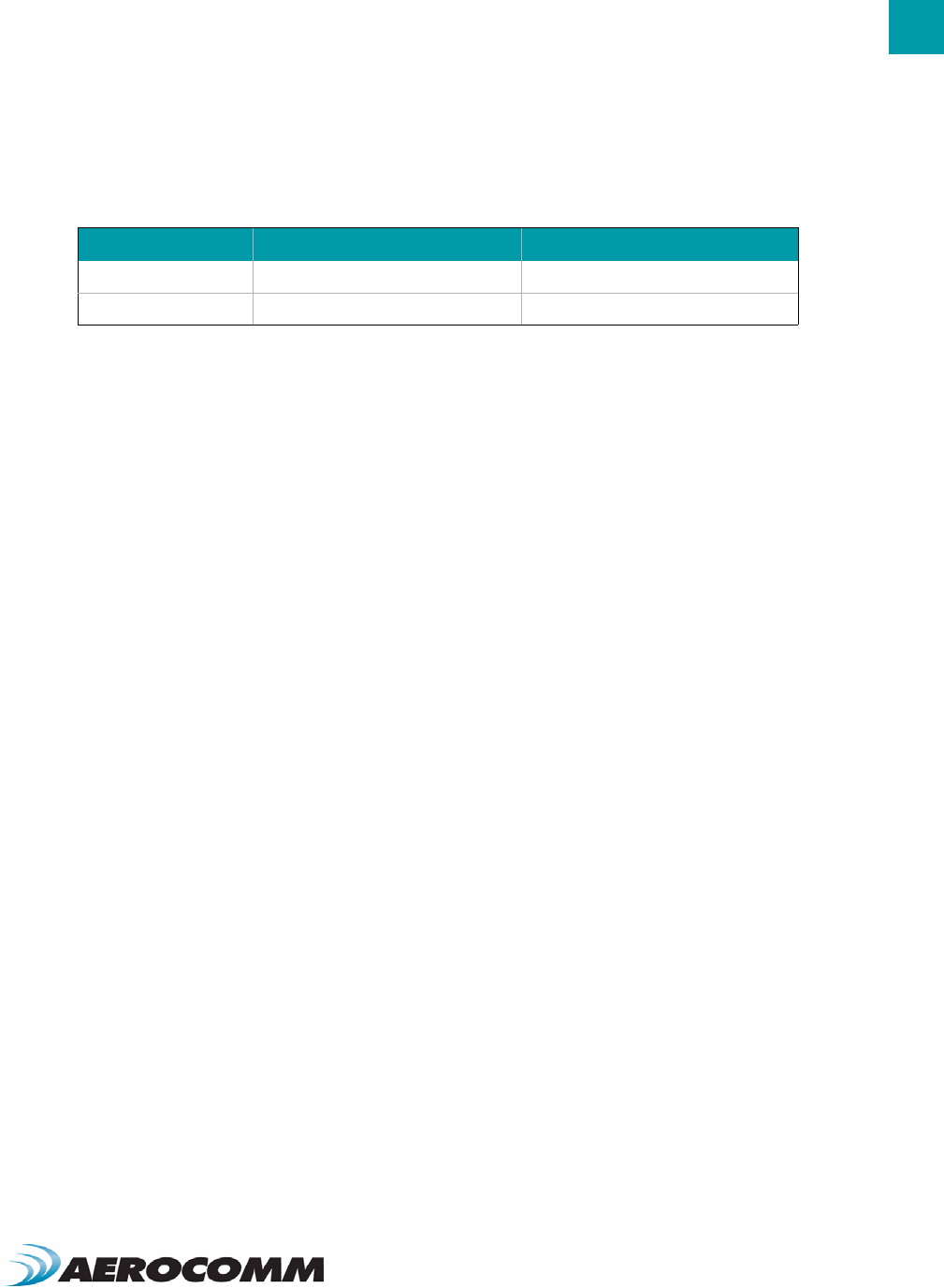
11
THEORY OF OPERATION
www.aerocomm.com
Note: Long Range Mode is only available on the AC4490LR-200 and AC4490LR-1000 transceivers with the following
board revisions and firmware v6.7+.
Table 5: Long Range Requirements
Module Board Number Board Revision
AC4490LR-200 0050-00100 Rev. 1 and higher
AC4490LR-1000 0050-00102 Rev. 1 and higher
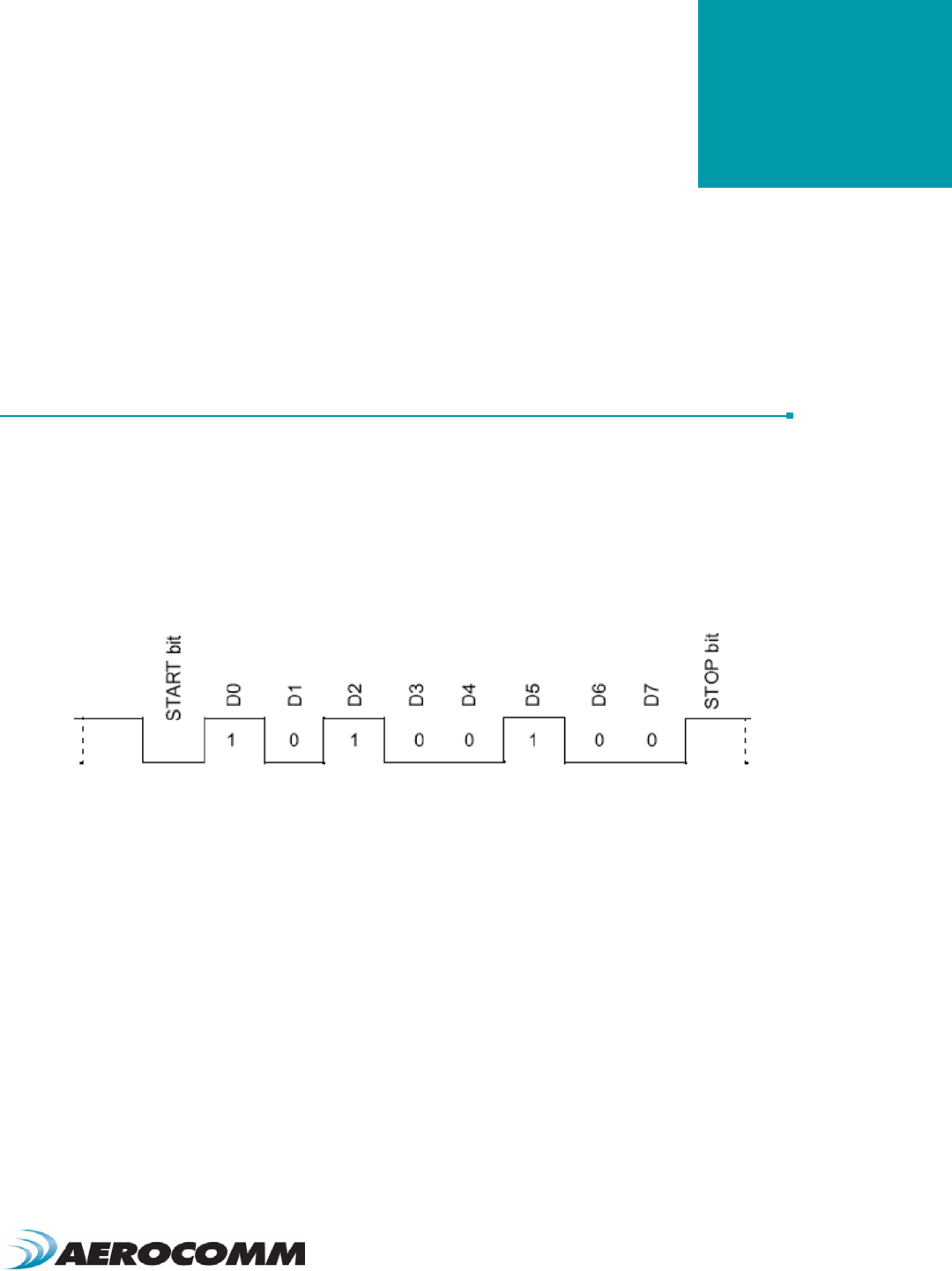
www.aerocomm.com
SERIAL INTERFACE
4
In order for the OEM Host and a transceiver to communicate over the serial interface they need to have the same
serial data rate. Refer to the following sections to ensure that the OEM Host data rate matches the serial interface
baud rate.
SERIAL COMMUNICATIONS
The AC4490 is a TTL device which can be interfaced to a compatible UART (microcontroller) or level translator to allow
connection to serial devices. UART stands for Universal Asynchronous Receiver Transmitter and its main function is
to transmit or receive serial data.
Asynchronous Operation
Since there is no seperate clock in asynchronous operation, the receiver needs a method of synchronizing with the
transmitter. This is achieved by having a fixed baud rate and by using START and STOP bits. A typical asynchronous
mode signal is shown below.
Figure 2: Asynchronous Mode Signal
The UART outputs and inputs logic level signals on the TX and RX pins. The signal is high when no data is being
transmitted and goes low when transmission begins.
The signal stays low for the duration of the START bit and is followed by the data bits; LSB first. The STOP bit follows
the last data bit and is always high. After the STOP bit has completed, the START bit of the next transmission can
occur.
Parity
A parity bit is used to provide error checking for a single bit error. When a single bit is used, parity can be either even
or odd. Even parity means that the number of ones in the data and parity sum to an even number and vice-versa. The
ninth data bit can be used as a parity bit if the data format requires eight data bits and a parity bit as shown below.
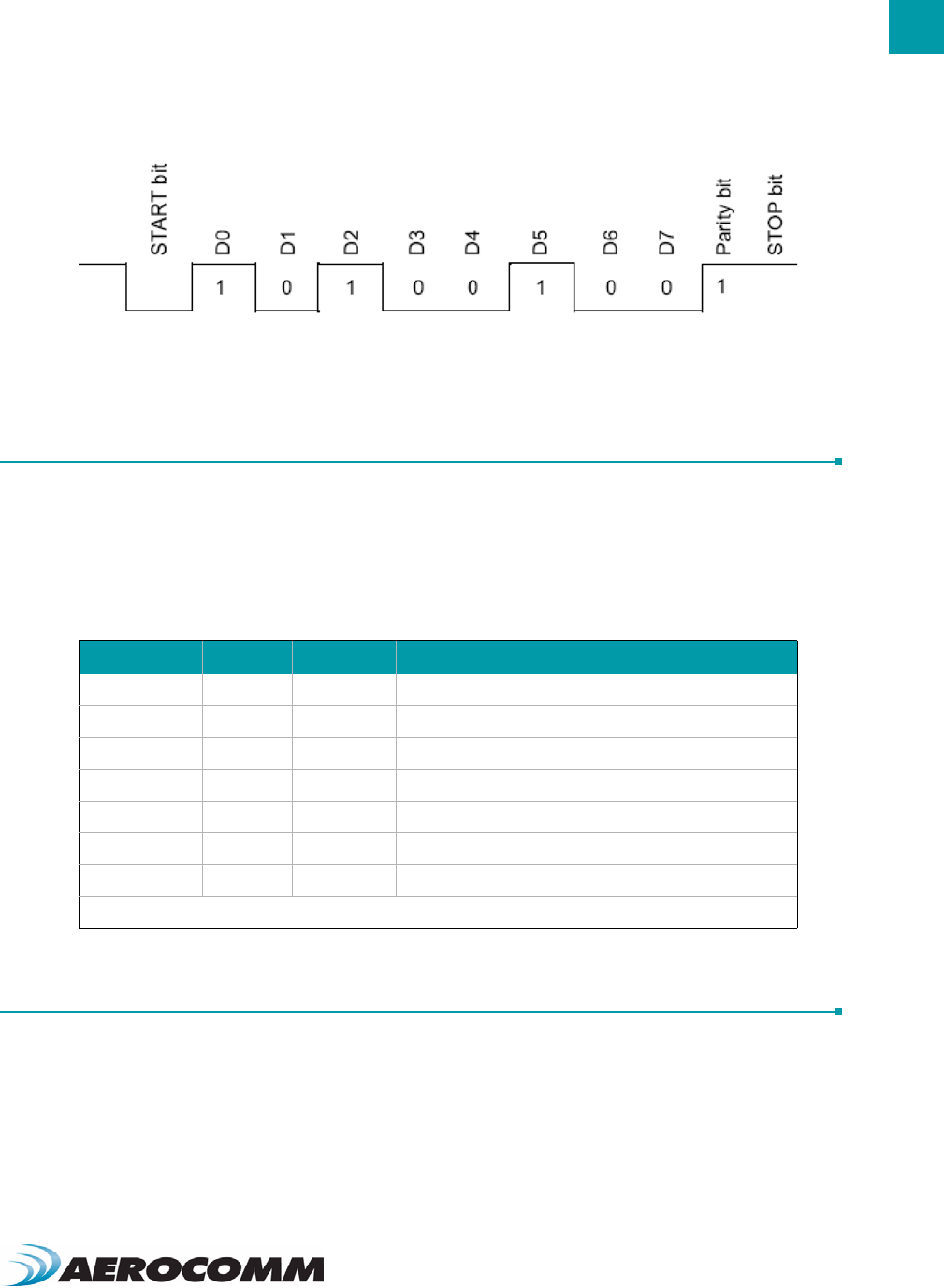
13
SERIAL INTERFACE
www.aerocomm.com
Figure 3: Even Parity Bit
Note: Enabling parity cuts throughput and the interface buffer in half.
OEM HOST DATA RATE
The OEM Host Data Rate is the rate with which the OEM Host and transceiver communicate over the serial interface.
This rate is independent of the RF baud rate, which is fixed at 76.8 kbps. Possible values range from 1200 bps to
115,200 bps. Note: Enabling Parity cuts throughput in half and the Interface Buffer size in half. The following
asynchronous serial data formats are supported:
SERIAL INTERFACE BAUD RATE
This two-byte value determines the baud rate used for communicating over the serial interface to a transceiver. The
Table below lists values for some common baud rates. Baud rates below 1200 baud are not supported. For a baud
rate to be valid, the calculated baud rate must be within ±3% of the OEM Host baud rate. If the Test pin (Pin 12) is
pulled logic Low at reset, the baud rate will be forced to 9,600. The RF baud rate is fixed at 76.8 Kbps and is
independent of the interface baud rate. For Baud Rate values other than those shown below, the following equations
can be used:
Table 6: Supported Serial Formats
Data Bits Parity Stop Bits Transceiver Programming Requirements
8 N 1 Parity Disabled
7 N 2 Parity Disabled
7E, O, M, S 1Parity Disabled
9 N 1 Parity Enabled
8 N 2 Parity Enabled
8E, O, M, S 1Parity Enabled
7E, O, M, S 2Parity Enabled
Mark (M) corresponds to 1 & Space (S) corresponds to 0
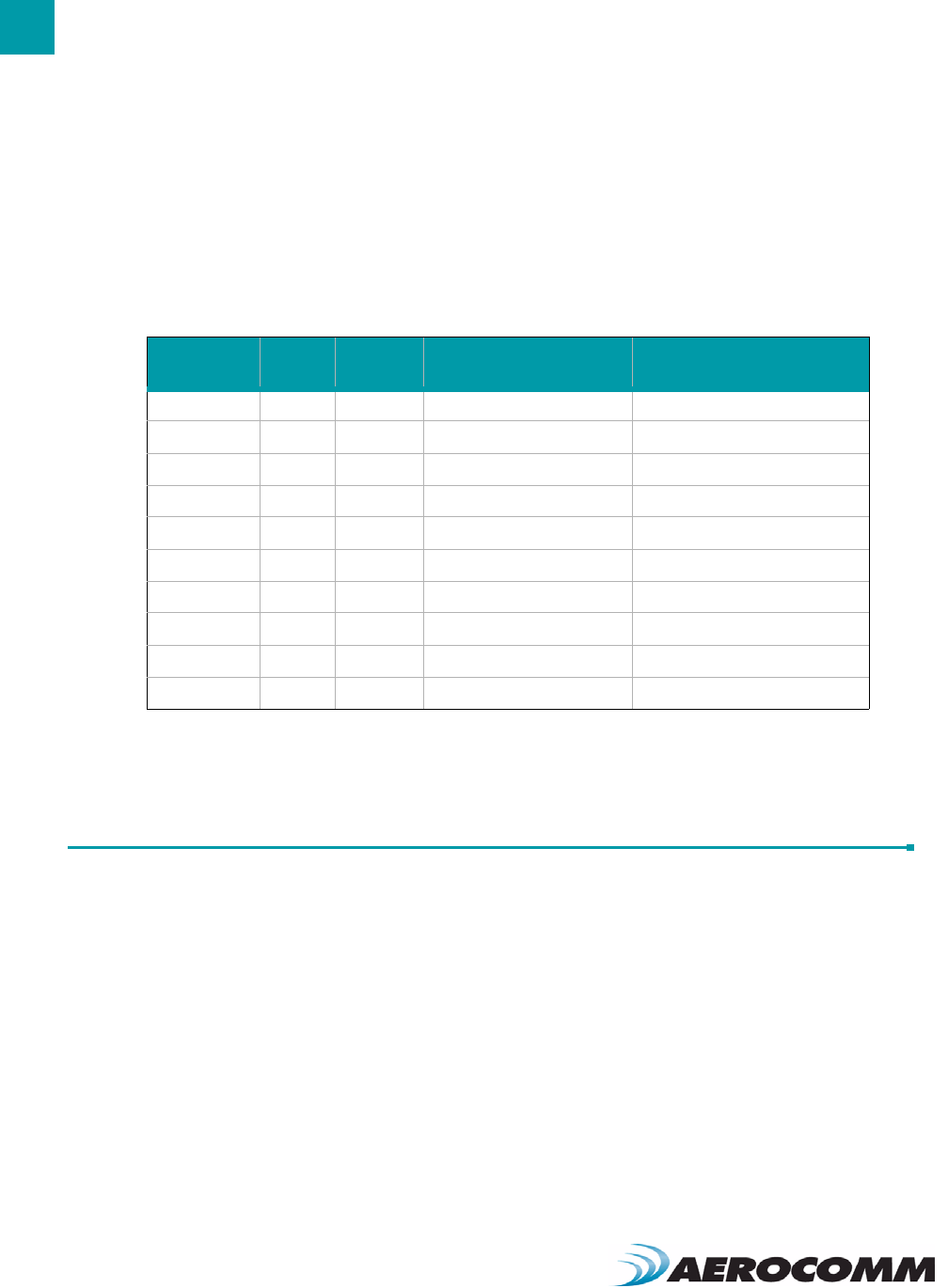
SERIAL INTERFACE
14
INTERFACE TIMEOUT / RF PACKET SIZE
Interface Timeout (EEPROM address 0x58), in conjunction with RF Packet Size (EEPROM address 0x5B), determines
when a buffer of data will be sent out over the RF as a complete RF packet, based on whichever condition occurs first.
Interface Timeout – Interface Timeout specifies a maximum byte gap between consecutive bytes. When that byte gap
is exceeded, the bytes in the transmit buffer are sent out over the RF as a complete packet. Interface Timeout is
adjustable in 0.5ms increments and has a tolerance of ±0.5ms. Therefore, the Interface Timeout should be set to a
minimum of 2. The default value for Interface Timeout is 0x04 (2ms) and should be adjusted accordingly when
changing the transceiver baud rate.
RF Packet Size – When the number of bytes in the transceiver transmit buffer equals RF Packet Size, those bytes are
sent out as a complete RF packet. It is much more efficient to send a few large packets rather than several short
packets as every packet the transceiver sends over the RF contains extra header bytes which are not included in the
RF Packet Size. RF packet size can be set to a maximum of 0x50 (80 bytes) and must be set to a minimum of 0x06 in
order to send the Enter AT Command mode command. To change the RF packet size from the default value, Auto
Config must be disabled and the appropriate Auto Config parameters must be changed.
Table 7: Baud Rate / Interface Timeout
Baud Rate BaudL
(0x42)
BaudH
(0x43)
Minium Interface
Timeout (0x58) Stop Bit Delay (0x3F)
115,200 0xFE 0x00 0x02 0xFF
57,6001
1. 57,600 is the default baud rate
0xFC 0x00 0x02 0x03
38,400 0xFA 0x00 0x02 0x08
28,800 0xF8 0x00 0x02 0x0E
19,200 0xF4 0x00 0x03 0x19
14,400 0xF0 0x00 0x04 0x23
9,600 0xE8 0x00 0x05 0x39
4800 0xD0 0x00 0x09 0x7A
2400 0xA0 0x00 0x11 0xFC
1200 0x40 0x00 0x21 0x002
2. 0x00 will yield a stop bit of 421 uS. The stop bit at 1200 baud should actually be 833 uS.
BAUD 14.7456 6
×10
64 DesiredBaud×
-----------------------------------------------
=
BaudH Always 0=
BaudL Low 8 bits of BAUD (base 16)=

15
SERIAL INTERFACE
www.aerocomm.com
FLOW CONTROL
Flow control refers to the control of data flow between transceivers. It is the method used to handle data in the
transmit/receive buffer and determines how data flow between the transceivers is started and stopped. Often, one
transceiver is capable of sending data much faster than the other can receive and flow control allows the slower
device to tell the faster device when to pause and resume data transmission.
When a transceiver has data to send, it sends a Ready To Send signal and waits for a Clear To Send response from
the receiving unit. If the receiving radio is ready to accept data it will assert its CTS low. CTS will be reasserted when
the buffer contains the number of bytes specified by CTS_OFF (EEPROM address 0x5D). These signals are sent
apart from the data itself on separate wires.
HALF DUPLEX / FULL DUPLEX
When Half Duplex communication is chosen, the AC4490 will send a packet out over the RF whenever it can. This can
cause packets sent by multiple transceivers at the same time to collide with each other over the RF. To prevent this,
Full Duplex communication can be chosen. Full Duplex shares the bandwidth intelligently to enable two-way
collision-free communication without any collision. This is done by calculating the amount of time until the next hop to
ensure that it has time to send the packet; if there is enough time, it will send the packet and if not, it will wait until its
next appropriate hop. The Server transmits during the even hops while the Client(s) will transmit during the odd hops.
Although the RF hardware is still technically half duplex, the bandwidth sharing it makes the transceiver seem full
duplex. Enabling Full Duplex can cause overall throughputs to be cut in half.
SYSTEM TIMING & LATENCY
Care should be taken when selecting transceiver architecture, as it can have serious effects on data rates, latency,
and overall system throughput. The importance of these three characteristics will vary from system to system and
ENGINEER’S TIP
Can I implement a design using just Txd, Rxd and Gnd (Three-wire Interface)?
Yes. However, it is strongly recommended that your hardware monitor the CTS pin of the
radio. CTS is taken High by the radio when its interface buffer is getting full. Your hardware
should stop sending at this point to avoid a buffer overrun (and subsequent loss of data).
You can perform a successful design without monitoring CTS. However, you need to take into
account the amount of latency the radio adds to the system, any additional latency caused by
Transmit Retries or Broadcast Attempts, how often you send data, non-delivery network
timeouts and interface data rate. Polled type networks, where the Server host requests data
from the Client host and the Client host responds, are good candidates for avoiding the use of
CTS. This is because no one transceiver can monopolize the RF link. Asynchronous type
networks, where any radio can send to another radio at any point in time, are much more
difficult to implement without the use of CTS.
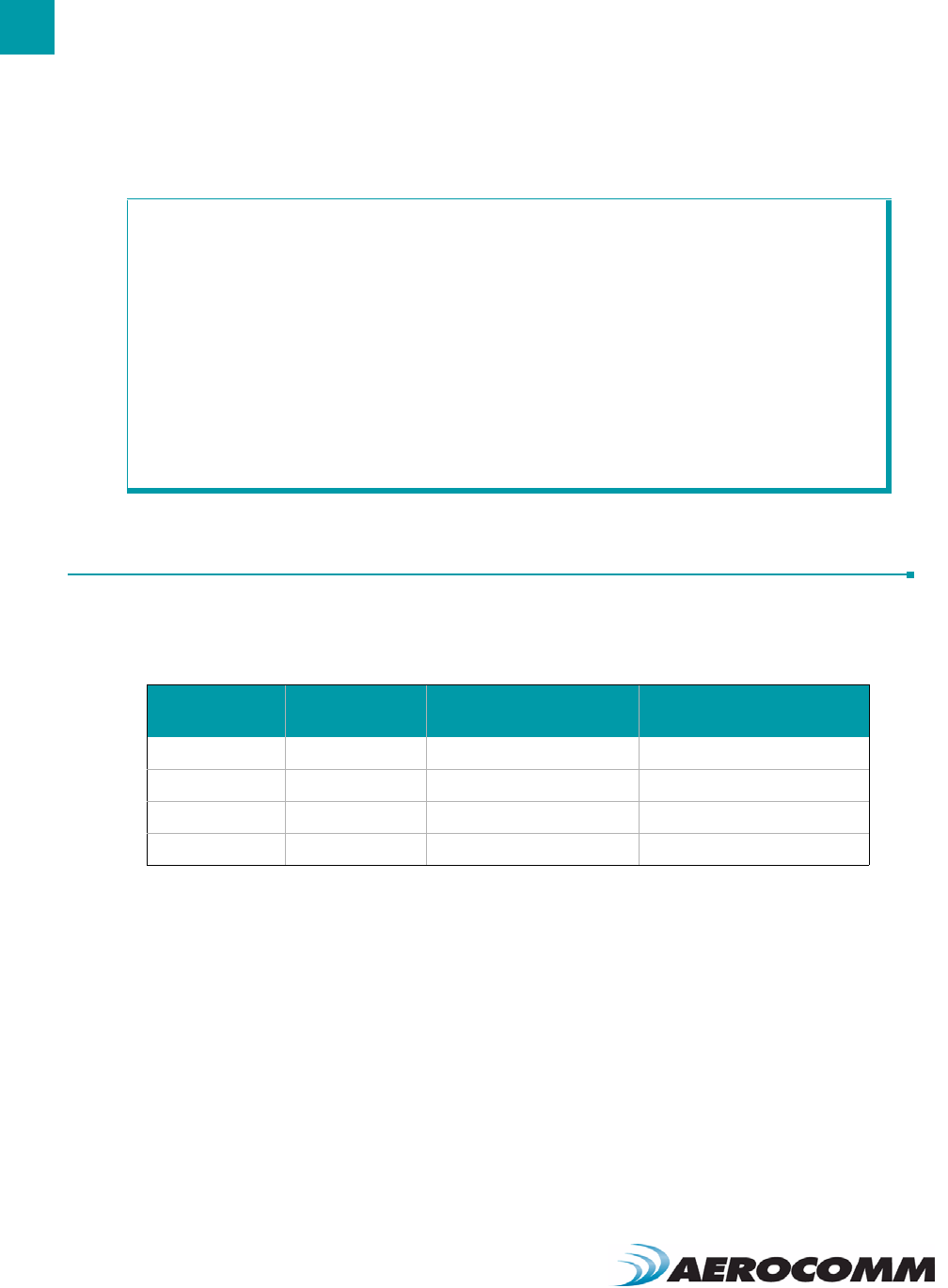
SERIAL INTERFACE
16
should be a strong consideration when designing the system.
SYSTEM THROUGHPUT
When operating as shown below, an AC4490 transceiver is capable of achieving the listed throughput. However, in
the presence of interference or at longer ranges, the transceiver may be unable to meet the specified throughput.
ENGINEER’S TIP
In High-density applications, what amount of latency should be expected?
It is not easy to predict the exact amount of latency in high-density applications. There are
many variables that affect system latency. The three variables that most affect the latency are
the network load, the distance between transceivers, and whether the transceivers are
operating in a broadcast or addressed mode. There is no fixed answer as to how much latency
will be introduced in the system when considering high-density applications. In these cases
we can just offer qualitative analysis of the latency in high-density applications. As the network
load increases, then the number of collisions that will occur increases. As the number of
collisions increase, then the system latency increases. As the distance between the
transceivers increases, so to does the system latency. Finally, when transceivers operate in
addressed mode they will retry sending a packet up to the number of time specified in the
transmit retry parameter specified in the EEPROM. As the number of retries increases, the
system latency will increase also.
Table 8: Maximum System Throughput
One Beacon
Mode Parity Mode Half Duplex Throughput
(bps)
Full Duplex Throughput
(bps) each way
Disabled Disabled 38k 19k
Enabled Disabled 48k 24k
Disabled Enabled 19k 9.5k
Enabled Enabled 24k 12k

www.aerocomm.com
SOFTWARE INTERFACE
5
NETWORKING
System ID - System ID (EEPROM address 0x76) is similar to a password character or network number and makes
network eavesdropping more difficult. A transceiver will not establish a Session or communicate with a transceiver
operating on a different System ID or Channel Number.
RF Channel Number - Channels 0x00 - 0x0F and 0x30 - 0x37 hop on 26 different frequencies. Channels 0x10 - 0x2F
use 50 different frequencies.
Auto Channel - To allow for more flexible network configurations, Auto Channel can be enabled on Client transceivers
to allow them to automatically synchronize with the first Server they hear a beacon from, regardless of the Server’s
Channel Number or signal strength. Note: A Client with Auto Channel enabled will only synchronize with a Server
operating in the same Channel set and with the same System ID.
DES (Data Encryption Standard) - DES (Data Encryption Standard) – Encryption is the process of encoding an
information bit stream to secure the data content. The DES algorithm is a common, simple and well-established
encryption routine. An encryption key of 56 bits is used to encrypt the packet. The receiver must use the exact same
key to decrypt the packet; otherwise garbled data will be produced.
To enable DES, EEPROM Byte 0x45, bit 6 must be set to a value of 1. To disable DES, set bit 6 to a value of 0. The 7
byte (56 bits) Encryption/Decryption Key is located in EEPROM Bytes 0xD0 – 0xD6. It is highly recommended that this
Key be changed from the default.
Sync to Channel - The AC4490 is a frequency hopping transceiver with a fixed hopping sequence. Without
synchronizing their frequency hopping, collocated systems on different channels can interfere with each other. To
avoid this, sync-to-channel can be used to synchronize the collocated Servers. A Server transceiver with sync-to-
channel enabled must have its Sync Channel set to another Server’s RF Channel number. It is required that a Server
with sync-to-channel enabled have its sync channel set to a value less than its RF Channel number. Collocated
networks using sync-to-channel must use the same channel set.
Note: If Server A (with sync-to-channel enabled) cannot synchronize to Server B (on the sync channel), Server A will
not be able to communicate with its Clients and must wait until it synchronizes with Server B (at which point In_Range
Table 9: RF Channel Number Settings
Channel Set1
1. All Channels in a Channel Set use the same frequencies in a different order.
RF Channel Number
Range (0x40)
Frequency Details &
Regulatory requirements Countries
0 (AC4490 - 1x1
AC4490 - 200)
0x00 - 0x0F 902 - 928 MHz (26 hop bins) US / Canada
1 (AC4490 - 1x1
AC4490 - 1000)
0x10 - 0x2F 902 - 928 MHz (50 hop bins) US / Canada
2 (AC4490 - 1x1
AC4490 - 200
AC4490 - 1000)
0x30 - 0x37 915 - 928 MHz (26 hop bins) US / Canada (-1x1 / -200)
Australia(-1x1/-200/-1000)
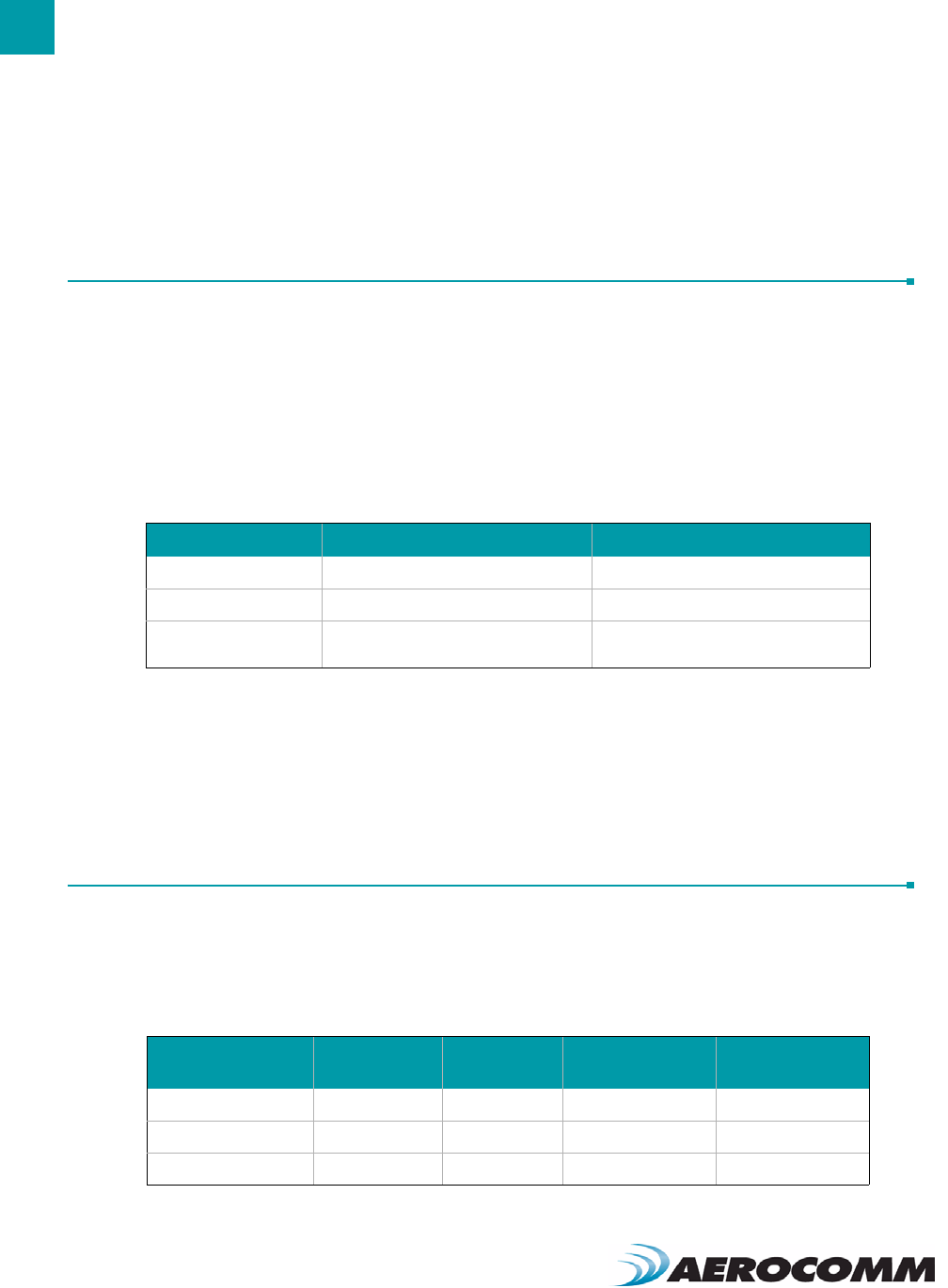
SOFTWARE INTERFACE
18
will be asserted), before establishing communications. Server B will not be affected and can communicate with its
Clients.
Refer to the Sync-to-Channel Appendix for further details and sample configuration.
ONE BEACON MODE / RANGE REFRESH
One Beacon - The 4490 maintains synchronization by using the timing information in the Server’s beacon. This
beacon lasts approximately 1 ms and by default is sent by the Server at the beginning of every hop to the particular
frequency that the Server is hopping on. If One Beacon mode is enabled, the 1 ms synchronization pulse is sent only
once per complete hop cycle. For example, a Server operating in Channel Set 1 (channels 0x10 - 0x2F) hops on 50
frequencies at 20 ms per frequency. Assuming that the Client hears the beacon on the first attempt, it can take up to
1 second (50 hops x 20 ms per hop) for a Client to hear the beacon and report In_Range.
Using One Beacon mode can make initial synchronization take longer and can make communications more difficult if
operating on the fringe but can increase net throughput.
Range Refresh - Range Refresh specifies the maximum amount of time a Client reports in range without having heard
a beacon from the Server. Each time the Client hears a beacon, it resets its Range Refresh timer. If the timer reaches
zero, the Client will go out of range, take its In_Range pin High and enter aquisition mode attempting to find the Server
once again. The range refresh is equal to the hop period (20 ms) x Range refresh value.
Note: Range Refresh should not be set to 0x00.
AUTO CONFIG PARAMETERS
The AC4490 has several variables that vary by RF mode and architecture. By default, Auto Config is enabled and
bypasses the values stored in EEPROM and uses predetermined values for the given operating mode. Below is a list
of the variables controlled by Auto Config and their respective predetermined values. If Auto Config is disabled, these
values must be programmed in the transceiver EEPROM for the corresponding mode of operation.
Table 10: One Beacon Mode Settings
EEPROM Address One Beacon Mode Enabled One Beacon Mode Disabled
0x45 Set bit 7 Clear bit 7
0x3C 0x18 0x28
0x3D Channels 0x10 - 0x2F: 0xC8
All other Channels: 0x68
0x18
Table 11: Auto Config Parameters
Parameter EEPROM
Address Default One Beacon
Mode Disabled
One Beacon
Mode Enabled
0x36 0x66 0xA0 0xA0
0x47 0x0E 0x0E 0x0E
0x48 0x90 0x90 0x90
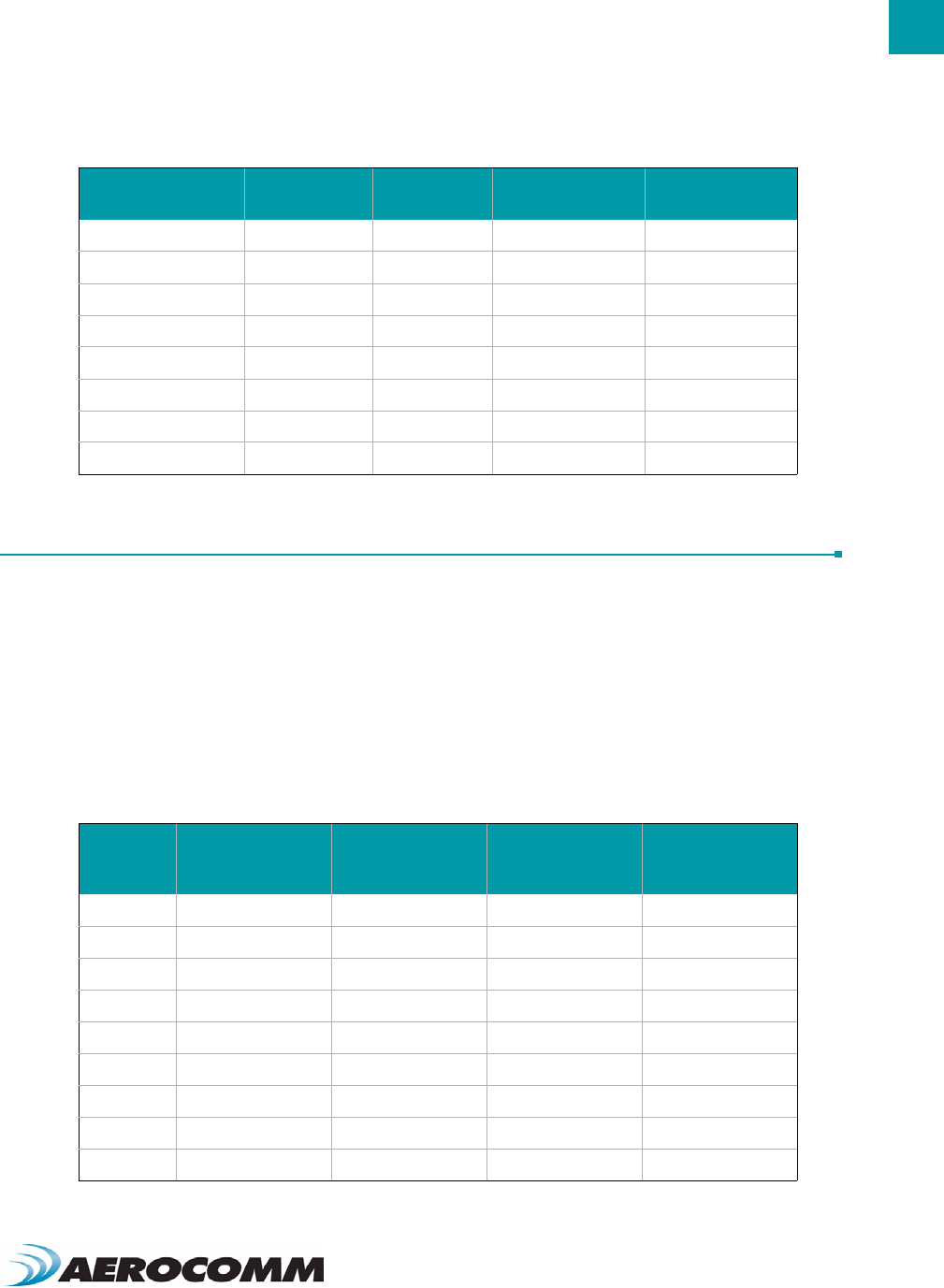
19
SOFTWARE INTERFACE
www.aerocomm.com
INTERFACE OPTIONS
Modem Mode
Full modem handshaking is supported by the AC4490 when enabled in EEPROM. Modem mode is incompatible with
RS-485 DE. The line states are updated a maximum of once per 20 ms and only change when toggled by the
appropriate line on the remote radio. Because Command/Data performs an alternate function when modem mode is
enabled, on-the-fly CC Commands cannot be used and Configuration Mode is entered by forcing 9600 baud through
the 9600_Baud pin (pin 12). Therefore, modem mode is disabled when the radio is forced to 9600 baud. Both
modem interfaces are shown in the tables below.
0x4E 0x09 0x09 0x09
0x53 0x80 0x80 0x80
0x54 0x07 0x07 0x07
RF Packet Size 0x5B 0x46 0x50 0x68
CTS On 0x5C 0xD2 0xDC 0xDC
CTS Off 0x5D 0xAC 0xB0 0xB0
0x5E 0x23 0x23 0x23
0x5F 0x08 0x08 0x08
Table 12: Transceiver Interface to DCE (Server)
DCE Pin
Number DCE Pin Name
Direction with
respect to
transceiver
AC4490 Pin Name AC4490 Pin
Number
1DCD In GI1 14
2RXD In RXD 3
3TXD Out TXD 2
4DTR Out GO0 1
5GND -GND 5
6DSR In Command/Data 17
7RTS Out CTS 7
8CTS In RTS 8
9RI In GI0 4
Table 11: Auto Config Parameters
Parameter EEPROM
Address Default One Beacon
Mode Disabled
One Beacon
Mode Enabled
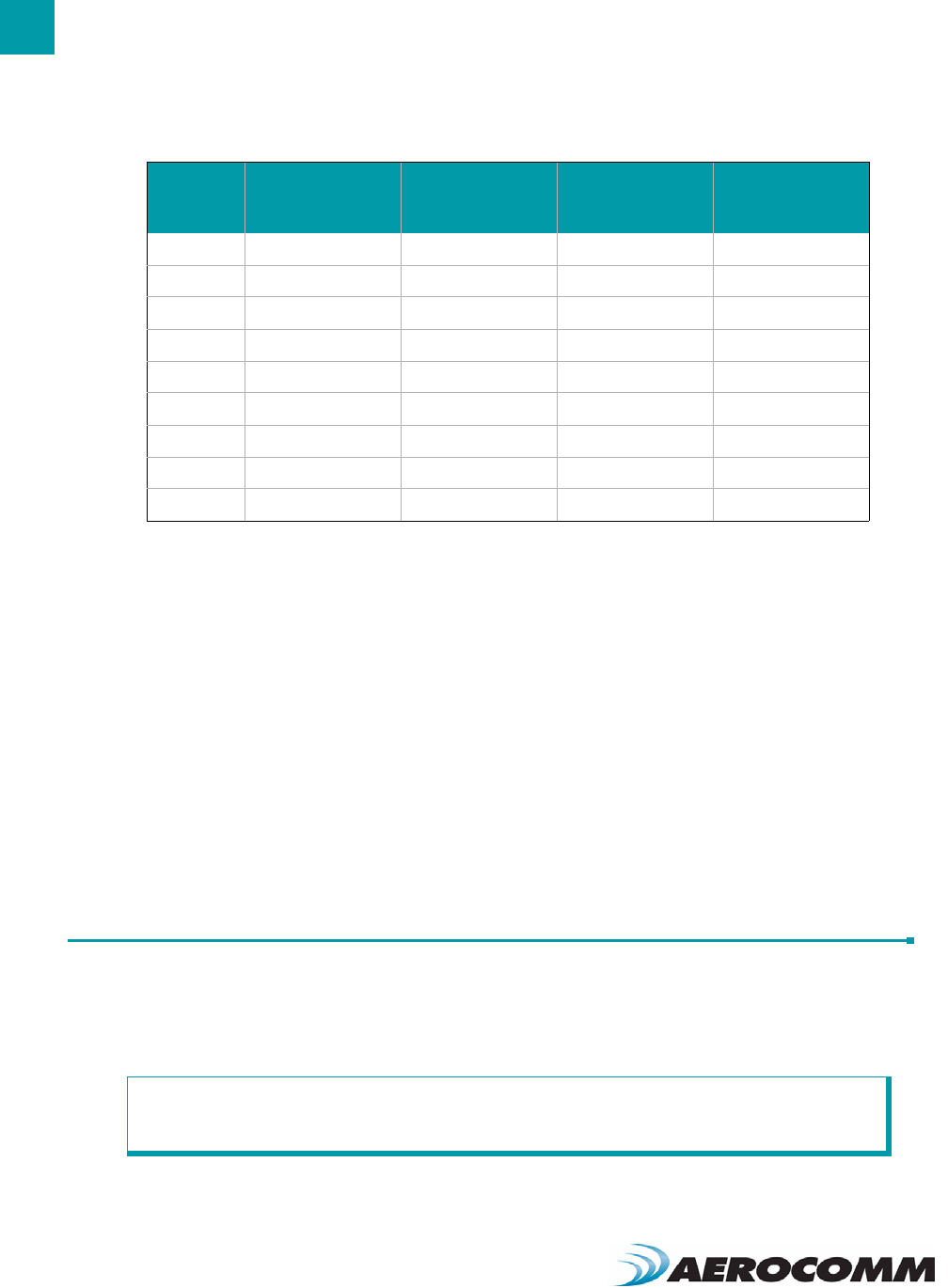
SOFTWARE INTERFACE
20
RS-485 DE Control - When enabled in EEPROM, the transceiver will use the GO0 pin to control the DE pin on external
RS-485 circuitry. If enabled, when the transceiver has data to send to the host, it will assert GO0 High, send the data
to the Host and then take GO0 Low.
RS485 Modem Mode
This mode is only useful for customers that wish to use RS485 DE in conjunction with standard Modem Mode. When
enabled in EEPROM in conjunction with Modem Mode, allows modem control lines over the RF. This mode should
only be used when RS485 DE is also being used. For all other applications, standard Modem Mode is preferred.
Available Modem control lines when RS485 Modem Mode is enabled:
• Command/Data on Server controls Hop Frame on Client
• GI1 on Server controls GO1 on Client
MAX POWER
Max Power provides a means for controlling the RF output power of the AC4790. Output power and current
consumption can vary by as much as ±10% per transceiver for a particular Max Power setting. Contact AeroComm
for assistance in adjusting Max Power.
Table 13: Transceiver Interface to DTE (Client)
DTE Pin
Number DTE Pin Name
Direction with
respect to
transceiver
AC4490 Pin Name AC4490 Pin
Number
1DCD Out GO0 1
2RXD Out TXD 2
3TXD In RXD 3
4DTR In GI0 4
5GND -GND 5
6DSR Out Hop Frame 6
7RTS In RTS 7
8CTS Out CTS 8
9RI Out G01 9
ENGINEER’S TIP
The max power is set during Production and may vary slightly from one transceiver to another.
The max power can be set as low as desired but should not be set higher than the original
factory setting. A backup of the original power setting is stored in EEPROM address 0x8E.
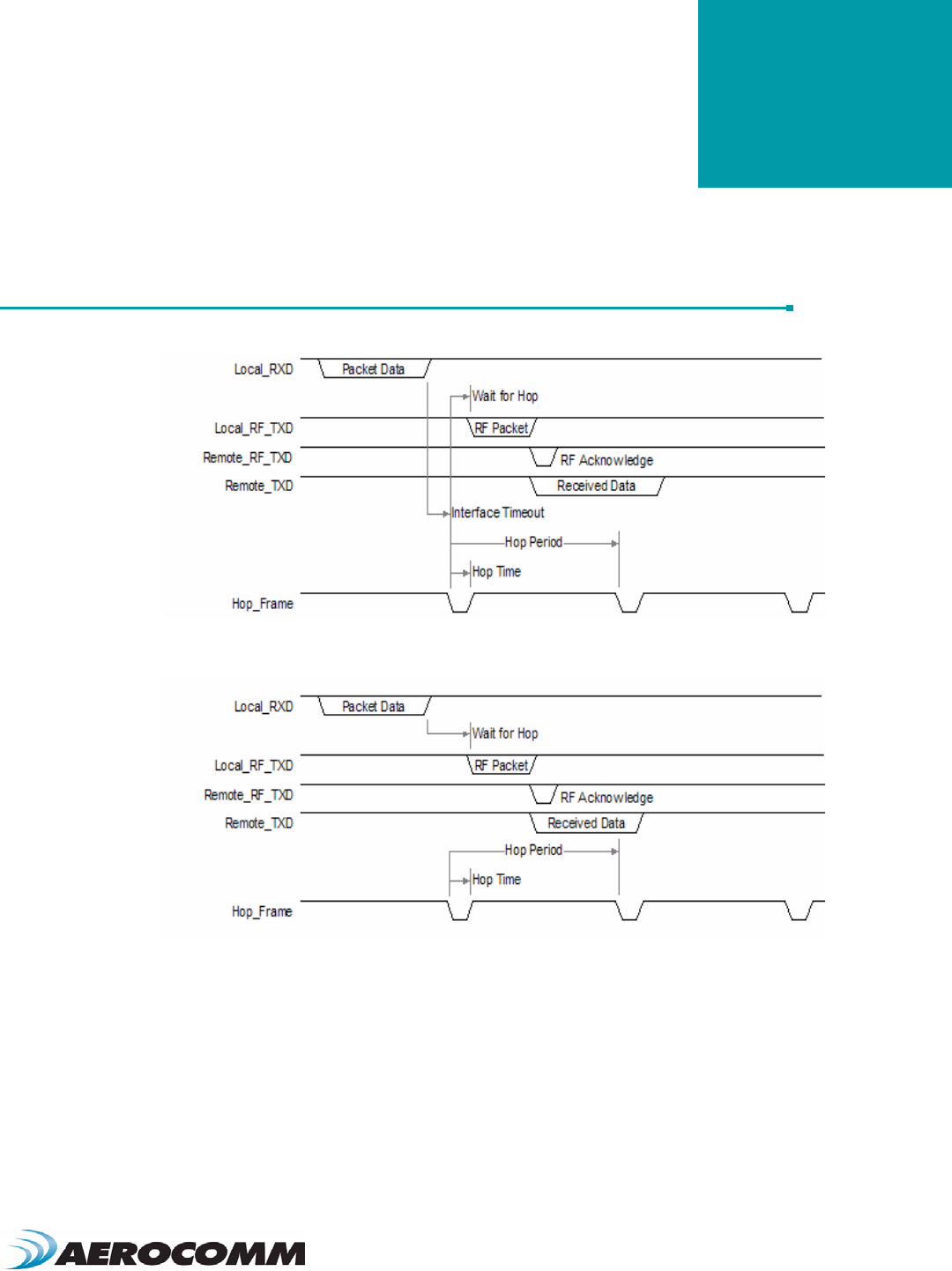
www.aerocomm.com
TIMING DIAGRAMS
6
AC4490 TIMING DIAGRAMS
Figure 4: Addressed Mode with Timeout
Figure 5: Addressed Mode with Fixed Packet Length

TIMING DIAGRAMS
22
Figure 6: Broadcast Mode with Timeout
Figure 7: Broadcast Mode with Fixed Packet Length

www.aerocomm.com
HARDWARE INTERFACE
7
Below is a description of all hardware pins used to control the AC4490.
PIN DEFINITIONS
Generic I/O
Both GIn pins serve as generic input pins and both GOn pins server as generic output pins. Reading and writing of
these pins can be performed using CC Commands. These pins alternatively serve as control pins when modem
mode is enabled.
TXD & RXD
SERIAL TTL
The AC4490-200 accepts 3.3 or 5VDC TTL level asynchronous serial data on the RXD pin and interprets that data as
either Command Data or Transmit Data. Data is sent from the transceiver, at 3.3V levels, to the OEM Host via the TXD
pin. Note: The AC4490-1000 & AC4490-1x1 transceivers ONLY accept 3.3V level signals.
RS-485
When equipped with an onboard RS-485 interface chip, TXD and RXD become the half duplex RS-485 pins. The
transceiver interface will be in Receive Mode except when it has data to send to the OEM Host. TXD is the non-
inverted representation of the data (RS485A) and RXD is a mirror image of TXD (RS485B). The transceiver will still use
RTS (if enabled).
Hop Frame
Transitions logic Low at the start of a hop and transitions logic High at the completion of a hop. The OEM Host is not
required to monitor Hop Frame.
CTS
The AC4490 has an interface buffer size of 256 bytes. If the buffer fills up and more bytes are sent to the transceiver
before the buffer can be emptied, data loss will occur. The transceiver prevents this loss by asserting CTS High as the
buffer fills up and taking CTS Low as the buffer is emptied. CTS On and CTS Off control the operation of CTS. CTS On
specifies the amount of bytes that must be in the buffer for CTS to be disabled (logic High). Even while CTS is
disabled, the OEM Host can still send data to the transceiver, but it should do so carefully.
Note: The CTS On/Off bytes of the EEPROM can be set to 1, in which case CTS will go high as data is sent in and low
when buffer is empty.
GND
Signal Ground. Pins are internally connected.
RTS
With RTS disabled, the transceiver will send any received data to the OEM Host as soon as it is received. However,
some OEM Hosts are not able to accept data from the transceiver all of the time. With RTS enabled, the OEM Host can

HARDWARE INTERFACE
24
prevent the transceiver from sending it data by disabling RTS (logic High). Once RTS is enabled (logic Low), the
transceiver can send packets to the OEM Host as they are received.
Note: Leaving RTS disabled for too long can cause data loss once the transceiver’s 256 byte receive buffer fills up.
Test / 9600 Baud
When pulled logic Low before applying power or resetting, the transceiver’s serial interface is forced to a 9600, 8-N-1
(8 data bits, No parity, 1 stop bit). To exit, the transceiver must be reset or power-cycled with Test pin logic High. This
pin is used to recover transceivers from unknown baud rates only. It should not be used in normal operation. Instead
the transceiver Interface Baud Rate should be programmed to 9600 baud if that rate is desired for normal operation.
RSSI
INSTANTANEOUS RSSI
Received Signal Strength Indicator is used by the OEM Host as an indication of instantaneous signal strength at the
receiver. The OEM Host must calibrate RSSI without an RF signal being presented to the receiver. Calibration is
accomplished by following the steps listed below.
1) Power up only one transceiver in the coverage area.
2) Measure the RSSI signal to obtain the minimum value with no other signal present.
3) Power up another transceiver and begin sending data from that transceiver to the transceiver being measured.
Make sure the two transceivers are separated by approximately ten feet.
4) Measure the peak RSSI, while the transceiver is in Session, to obtain a maximum value at full signal strength.
VALIDATED RSSI
As RSSI is only valid when the local transceiver is receiving an RF packet from a remote transceiver, instantaneous
RSSI can be very tricky to use. Therefore, the transceiver stores the most recent valid RSSI value. The OEM Host
issues the Report Last Good RSSI command to request that value. Additionally, validated RSSI can be obtained from
Receive Packet and Send Data Complete API commands and from the Probe command. Validated RSSI is not
available at the RSSI pin. The following equation approximates the RSSI curve:
ENGINEER’S TIP
Aerocomm does not recommend permantly grounding the Forced_9600 pin. This mode was
intended for recovering transceivers from unknown settings and was not intended to be used
in real-time communications. The following modes are affected:
Modem mode = disabled
Parity mode = disabled
Interface Timeout = 0x40
It is also possible that future modes not yet implemented will be disabled by grounding
Forced_9600.
Signal Strength (dBm) = (-46.9 VRSSI)× 53.9–
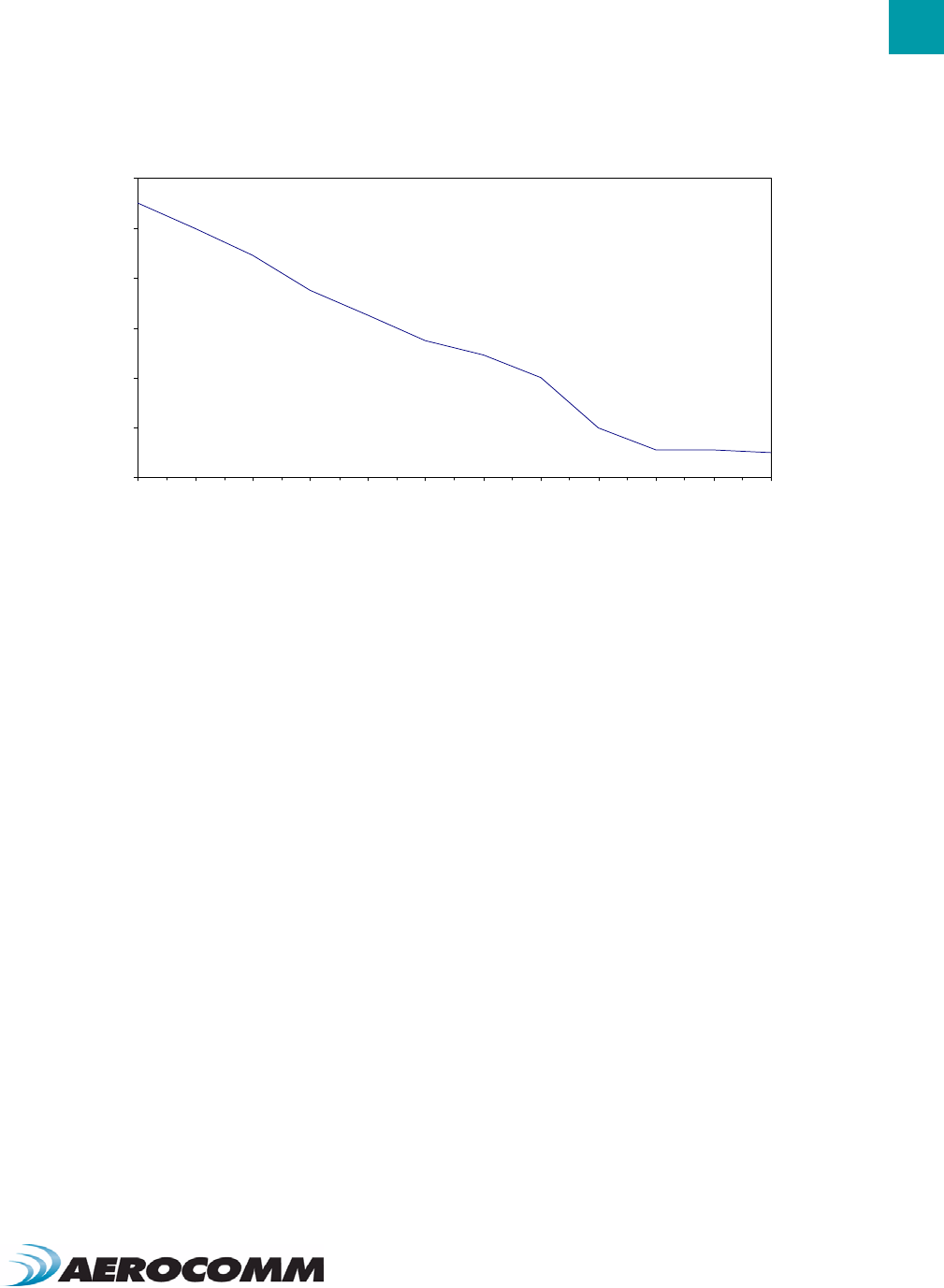
25
HARDWARE INTERFACE
www.aerocomm.com
Figure 8: RSSI Voltage vs. Received Signal Strength
UP_Reset
UP_Reset provides a direct connection to the reset pin on the AC4490 microprocessor and is used to force a soft
reset.
Command/Data
When logic High, the transceiver interprets incoming OEM Host data as transmit data to be sent to other transceivers
and their OEM Hosts. When logic Low, the transceiver interprets OEM Host data as command data.
AD In
AD In can be used as a cost savings to replace Analog-to-Digital converter hardware. Reading of this pin can be
performed locally using the Read ADC command found in the On-the-Fly Control Command Reference.
In Range
Reports logic Low when a Client transceiver is in range of a Server radio operating on the same RF Channel and
system ID. If a Client cannot hear a Server for the amount of time defined by Range Refresh, it will drive In_Range
High and enter search mode looking for a Server. When a server is detected, In_Range will be asserted Low.
In_Range will always report Low on Server transceivers.
0
0.2
0.4
0.6
0.8
1
1.2
-105 -100 -95 -90 -85 -80 -75 -70 -65 -60 -55 -50
Signal at Receiver (dBm)
Voltage (VDC)

www.aerocomm.com
CONFIGURING THE AC4490
8
The AC4490 can be configured using the CC Configuration Commands. The CC Commands can be issued using
either Hardware or Software Configuration. To use Hardware Configuration, pin 17 of a transceiver must be asserted
Low. Software Configuration can be used by entering AT Command Mode before issuing the CC Commands.
Figure 9: AC4490 Configuration Flow
Use AT
Commands
Receive Mode
Take Pin 17 Low
(Hardware
Configuration)
AT+++
(Software
Configuration)
Send CC
Commands Exit Command
Mode
In AT
Command
Mode
Send CC
Command
Send Another
CC Command
Send Exit AT
Command Mode
Command Take Pin 17 High
No
No
No No
No

27
CONFIGURING THE AC4490
www.aerocomm.com
AT COMMANDS
The AT Command mode implemented in the AC4490 creates a virtual version of the Command/Data pin. The “Enter
AT Command Mode” Command asserts this virtual pin Low (to signify Command Mode) and the “Exit AT Command
Mode” Command asserts this virtual pin High (to signify Data). Once this pin has been asserted Low, all On-the-Fly
CC Commands documented in the manual are supported.
On-the-Fly Control Commands
The AC4490 transceiver contains static memory that holds many of the parameters that control the transceiver
operation. Using the “CC” command set allows many of these parameters to be changed during system operation.
Because the memory these commands affect is static, when the transceiver is reset, these parameters will revert back
to the settings stored in the EEPROM. While in CC Command mode using pin 17 (Command/Data), the RF interface
of the transceiver is still active. Therefore, it can receive packets from remote transceivers while in CC Command
mode and forward these to the OEM Host.
COMMAND/DATA RX DISABLE
The Command/Data RX Disable feature can be enabled in firmware versions 8.6+. When enabled in EEPROM, the
radio disables the RF receiver while pin 17 (Command/Data) is Low. To ensure that the radio is not in the middle of
transmitting data to the OEM Host, the host should be prepeared to receive data for up to 20 ms after taking pin 17
Low.
AT COMMAND MODE
While in CC Command mode using AT Commands, the RF interface of the transceiver is active, but packets sent from
other transceivers will not be received. The transceiver uses Interface Timeout/RF Packet Size to determine when a
CC Command is complete. Therefore, there should be no delay between each character as it is sent from the OEM
Host to the transceiver or the transceiver will not recognize the command. If the OEM Host has sent a CC Command
to the transceiver and an RF packet is received by the transceiver, the transceiver will send the CC Command
response to the OEM Host before sending the packet. However, if an RF packet is received before the Interface
Timeout expires on a CC Command, the transceiver will send the packet to the OEM Host before sending the CC
Command response.
When an invalid command is sent, the radio scans the command to see if it has a valid command followed by bytes
not associated with the command, in which case the radio discards the invalid bytes and accepts the command. In all
other cases, the radio returns the first byte of the invalid command back to the user and discards the rest.
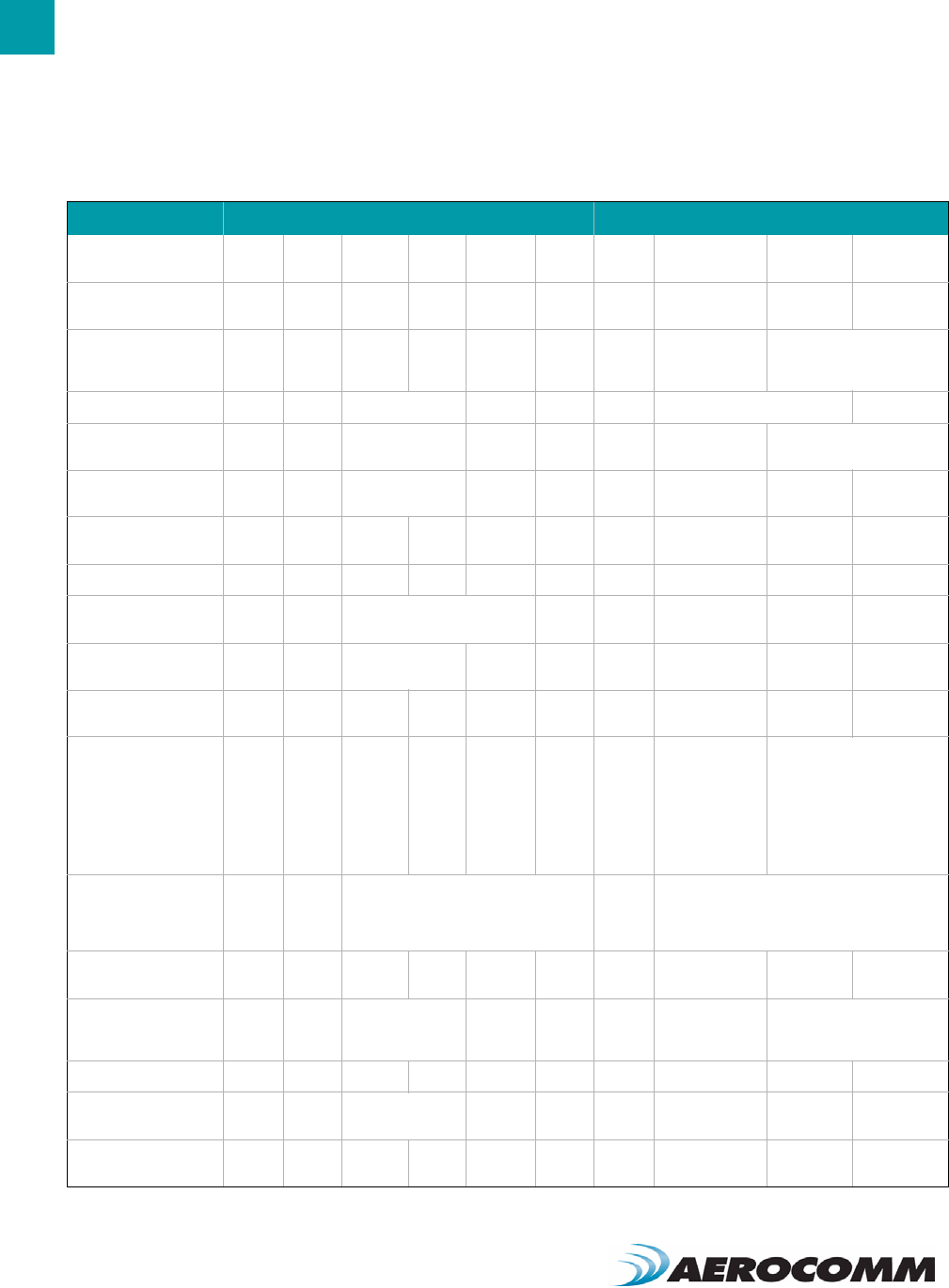
CONFIGURING THE AC4490
28
Table 14: Command Quick Reference
Command Name Command (All Bytes in Hex) Return (All Bytes in Hex)
AT Enter
CommandMode
0x41 0x54 0x2B 0x2B 0x2B 0x0D 0xCC 0x43 0x4F 0x4D
Exit AT Command-
Mode
0xCC 0x41 0x54 0x4F 0x0D -0xCC 0x44 0x41 0x54
Status Request 0xCC 0x00 0x00 - - - 0xCC Firmware
Version
0x00: Server
0x01: Client in range
0x03: Client out of range
Change Channel 0xCC 0x02 New Channel - - 0xCC New Channel -
Change Server/Client 0xCC 0x03 0x00: Server
0x03: Client
- - 0xCC Firmware
Version
0x00: Server
0x03: Client
Change Sync
Channel
0xCC 0x05 New Sync
Channel
- - 0xCC New Sync
Channel
- -
Sleep Walk Power
Down
0xCC 0x06 - - - - 0xCC Channel - -
Sleep Walk Wake Up 0xCC 0x07 - - - - 0xCC Channel -
Broadcast
Packets
0xCC 0x08 0x00: Broadcast
0x01: Addressed
-0xCC 0x00 or 0x01 - -
Write Destination
Address
0xCC 0x10 Byte 4 of
Dest. MAC
Byte 5 Byte
6
0xCC Byte 4 of Dest.
MAC
Byte 5 Byte 6
Read Destination
Address
0xCC 0x11 - - - - 0xCC Byte 4 of Dest.
MAC
Byte 5 Byte 6
Forced Calibration 0xCC 0x12 0x00 0x00 - - 0xCC Firmware
Version
0x00: Server in Normal
Operation
0x01: Client in Normal
Operation
0x02: Server in Acquisition
Sync
0x03: Client in Acquisition
Sync
Auto Destination 0xCC 0x15 bit-0: Auto Destination
bit-1: Auto Channel
bit-4: Enable Auto Destination
bit-5: Enable Auto Channel
0xCC bit-0: Auto Destination
bit1: Auto Channel
bits-2-7: 0
Read Digital Inputs 0xCC 0x20 - - - - 0xCC bit-0: GI0
bit-1: GI1
- -
Read ADC 0xCC 0x21 0x01: AD In
0x02: Temp
0x03: RSSI
- - 0xCC MSB of 10 bit
ADC
LSB of 10 bit ADC
Report Last Valid RSSI 0xCC 0x22 - - - - 0xCC RSSI - -
Write Digital
Outputs
0xCC 0x23 bit-0: GO0
bit-1: GO1
- - 0xCC bit-0: GO0
bit-1: GO1
- -
Write DAC 0xCC 0x24 Update
Period
Duty
Cycle
- - 0xCC Update Period Duty
Cycle
-
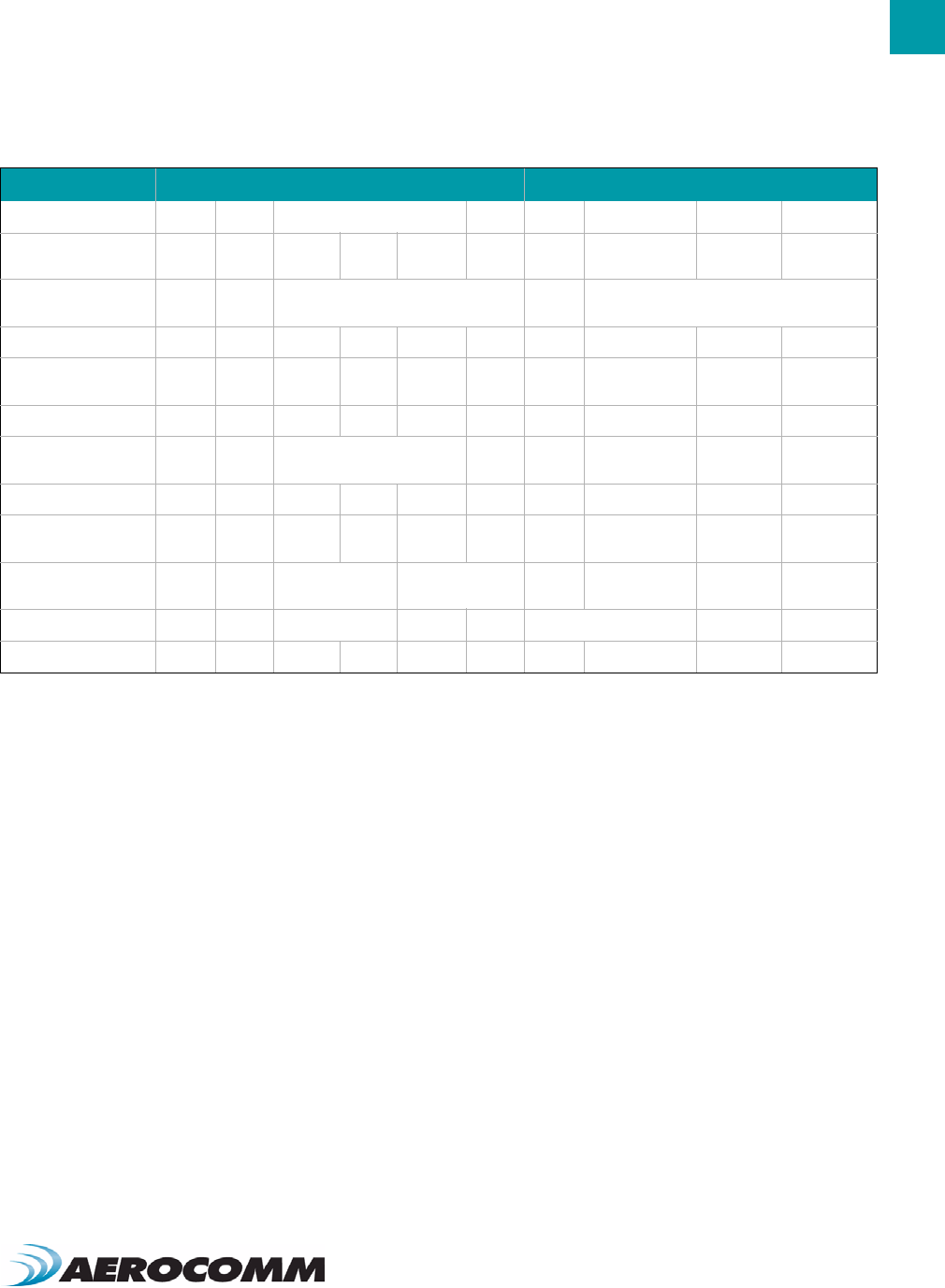
29
CONFIGURING THE AC4490
www.aerocomm.com
Set Max Power 0xCC 0x25 New Max Power -0xCC Max Power - -
Report Last Packet
RSSI
0xCC 0x26 - - - - 0xCC RSSI - -
Long Range Mode10xCC 0x27 0x00: Normal Mode (Disabled)
0x01: Long Range Mode (Enabled)
0xCC 0x00: Normal Mode (Disabled)
0x01: Long Range Mode (Enabled)
Transmit Buffer Empty 0xCC 0x30 - - - - 0xCC 0x00 - -
Disable Sync to
Channel
0xCC 0x85 - - - - 0xCC Channel - -
Deep Sleep Mode 0xCC 0x86 - - - - 0xCC Channel - -
Enter Probe 0xCC 0x8E 0x00: Enter Probe
0x01: Exit Probe
-0xCC 0x00 or 0x01 - -
Read Temperature 0xCC 0xA4 - - - - 0xCC Temp (C) - -
Read Temperature at
last calibration
0xCC 0xA5 - - - - 0xCC Temp (C)
EEPROM Byte Read 0xCC 0xC0 Start Address Length 0xCC Starting
Address
Length Data
EEPROM Byte Write 0xCC 0xC1 Start Address Length Data Starting Address Length Data written
Soft Reset 0xCC 0xFF - - - - - - - -
1. Available only on AC4490LR-200 and AC4490LR-1000 transceivers.
Table 14: Command Quick Reference
Command Name Command (All Bytes in Hex) Return (All Bytes in Hex)

CONFIGURING THE AC4490
30
COMMAND DESCRIPTIONS
Enter AT Command Mode
Prior to sending this command, the OEM Host must ensure that the
transceiver’s RF transmit buffer is empty. If the buffer is not empty, the
radio will interpret the command as data and it will be sent over the RF.
This can be accomplished by waiting up to one second between the
last packet and the AT command.
Command: 0x41 0x54 0x2B 0x2B 0x2B 0x0D
Number of Bytes Returned: 4
Response: 0xCC 0x43 0x4F 0x4D
Exit AT Command Mode
The OEM Host should send this command to exit AT Command mode
and resume normal operation.
Command: 0xCC 0x41 0x54 0x4F 0x0D
Number of Bytes Returned: 4
Response: 0xCC 0x44 0x41 0x54
Status Request
The OEM Host issues this command to request the status of the
transceiver.
Command: 0xCC 0x00 0x00
Number of Bytes Returned: 3
Response: 0xCC <Version> <Radio State>
Parameter Range: Radio State = 0x00 for Server, 0x01 for
Client in Range, 0x03 for Client out of Range
Change Channel
The OEM Host issues this command to change the channel of the
transceiver.
Command: 0xCC 0x02 <Channel>
Number of Bytes Returned: 2
Response: 0xCC <Channel>
Change Server/Client
The OEM Host issues this command to change the mode of the
transceiver from Server to Client and vice versa.
Command: 0xCC 0x03 Data1
Number of Bytes Returned: 3
Response: 0xCC <Version> <Mode>
Parameter Range: Mode = 0x00 for Server, 0x03 for Client
Change Sync Channel
The OEM Host issues this command to change the sync channel byte
and enable sync to channel.
Command: 0xCC 0x05 <Channel>
Number of Bytes Returned: 3
Response: 0xCC 0x05 <Channel>
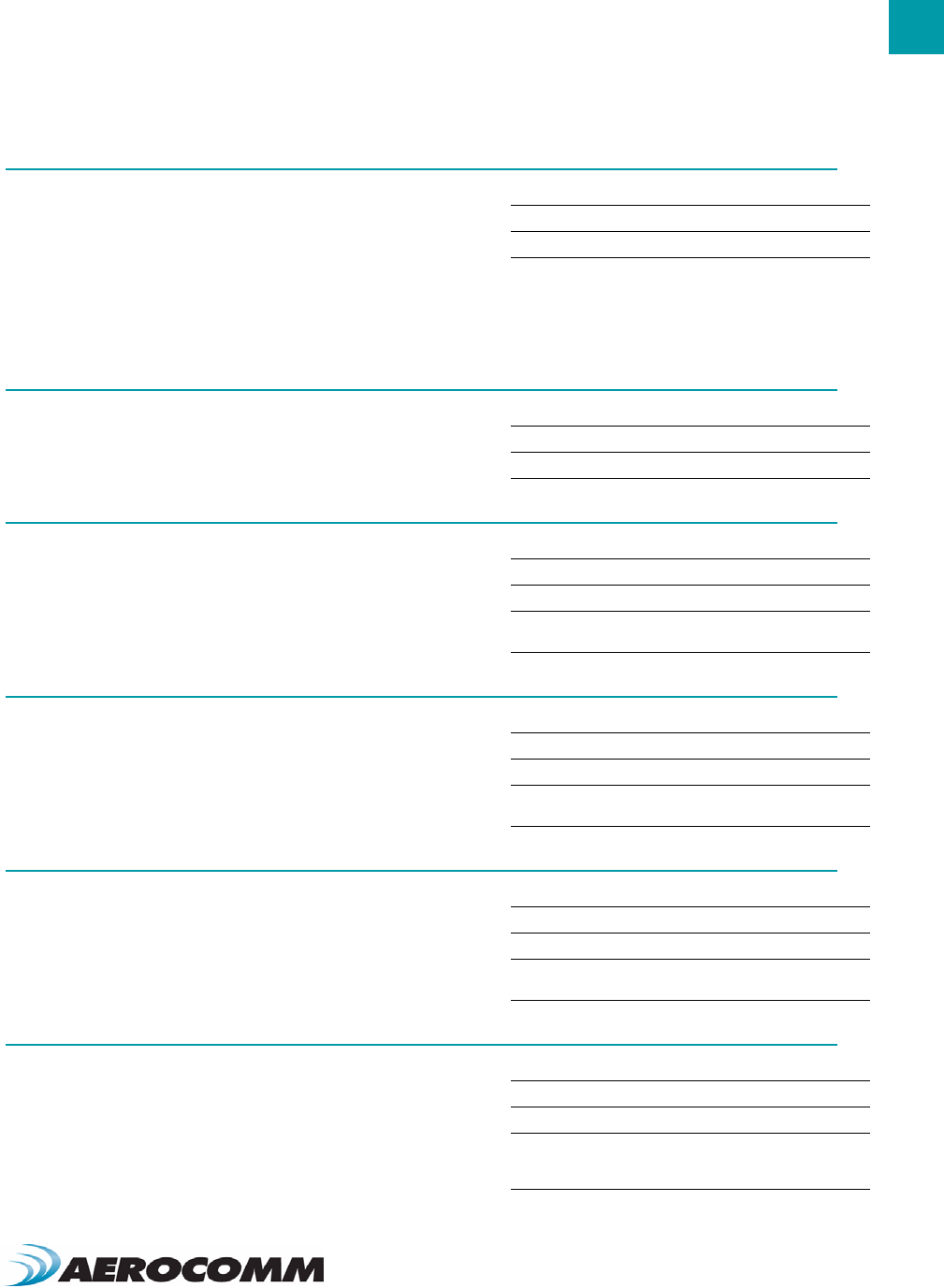
31
CONFIGURING THE AC4490
www.aerocomm.com
Sleep Walk Power-Down
After the Host issues this command, the transceiver will de-assert its
In_Range line after entering power down. A Client in power down will
remain in sync with a Server for a minimum of 2 minutes. To maintain
syncronization with the Server, the Client should re-sync at least once
every 2 minutes. This is done by sending the Power Down wake up
command and waiting for the In_Range line to go active. Once this
occurs, the Client is in sync with the server and can be put back into
power-down mode.
This command is valid only for Client transceivers.
Command: 0xCC 0x06
Number of Bytes Returned: 2
Response: 0xCC <Channel>
Sleep Walk Power-Down Wake Up
The OEM Host issues this command to bring the transceiver out of
Power Down mode.
Command: 0xCC 0x07
Number of Bytes Returned: 2
Response: 0xCC <Channel>
Broadcast Packets
The OEM Host issues this command to change the transceiver
operation between Addressed Packets and Broadcast Packets. If
Addressed Packets are selected, the transceiver will send all packets to
the transceiver designated by the Destination Address programmed in
the transceiver. If Broadcast Packets are selected, the transceiver will
send its packets to all transceivers on that network. Setting bit-7 of API
Control to 1 can also enable Broadcast Packets.
Command: 0xCC 0x08 <Addressing Mode>
Number of Bytes Returned: 2
Response: 0xCC <Addressing Mode>
Parameter Range: Addressing Mode = 0x00 for Addressed,
0x01 for Broadcast
Write Destination Address
The OEM Host issues this command to the transceiver to change the
Destination Address.
Note: Only the three Least Significant Bytes of the MAC Address are
used for packet delivery.
Command: 0xCC 0x10 MAC3 MAC2 MAC1
Number of Bytes Returned: 4
Response: 0xCC MAC3 MAC2 MAC1
Parameter Range: 0x00 - 0xFF corresponding to 3 LSB’s of
destination MAC Address
Read Destination Address
The OEM Host issues this command to the transceiver to read the
destination address.
Note: Only the three Least Significant Bytes of the MAC Address are
used for packet delivery.
Command: 0xCC 0x11
Number of Bytes Returned: 4
Response: 0xCC MAC3 MAC2 MAC1
Parameter Range: 0x00 - 0xFF corresponding to 3 LSB’s of
destination MAC Address
Forced Calibration
The OEM Host issues this command to force a recalibration to occur.
During the recalibration, the radio will assert CTS high. Recalibration
can take up to 3 seonds and the command response will not be sent to
the OEM Host until recalibration is complete.
Command: 0xCC 0x12 0x00 0x00
Number of Bytes Returned: 3
Response: 0xCC <Version> <Radio State>
Parameter Range: Radio State = 0x00 for Server in range,
0x01 for Client in range, 0x02 for Server out of range, 0x03 for
Client out of range

CONFIGURING THE AC4490
32
Auto Destination
The Host issues this command to change the Auto Destination & Auto
Channel settings. When issuing this command, the Auto
Destination/Auto Channel settings will only be changed if the
corresponding enable bit is set (Control1 Parameter, EEPROM address
0x56, bits-4,5)
Command: 0xCC 0x15 <Data1>
Number of Bytes Returned: 2
Response: 0xCC <Data2>
Parameter Range: Data1 = bit-0: Auto Destination, bit-1: Auto
Channel, bit-4: Enable Auto Destination modification, bit-5:
Enable Auto Channel Modification; Data2 = bit-0: New Auto
Destination setting, bit-1: New Auto Channel Setting, bits 2 -
7:0
Read Digital Inputs
The OEM Host issues this command to read the state of both digital
input lines.
Command: 0xCC 0x20
Number of Bytes Returned: 2
Response: 0xCC <Data1>
Parameter Range: Data1 = bit-0: GI0, bit-1: GI1
Read ADC
The OEM Host issues this command to read any of the three onboard
10-bit A/D converters. Because the RF is still active in On-the-Fly
Command Mode, the transceiver will not process the command until
there is no activity on the network. The Read RSSI command is
therefore useful for detecting interfering sources but will not report the
RSSI from a remote transceiver on the network. The equations for
converting these 10 bits into analog values are as follows:
Analog Voltage = (10 bits / 0x3FF) * 3.3V
Temperature (oC) = ((Analog Voltage - 0.3) / 0.01) - 30
RSSI value (dBm) = -105 + (0.22 * (0x3FF - 10 bits))
Command: 0xCC 0x21 <Data1>
Number of Bytes Returned: 3
Response: 0xCC <Data2> <Data3>
Parameter Range: Data1 = 0x00: AD In, 0x01: Temperature,
0x02: RSSI; Data2 = MSB of requested 10-bit ADC value;
Data3 = LSB of requested 10-bit ADC value
Report Last Valid RSSI
Since RSSI values are only valid when the local transceiver is receiving
an RF packet from a remote transceiver, instantaneous RSSI can be
tricky to use. Therefore, the transceiver stores the most recent valid
RSSI value as measured the last time the transceiver received a packet
or beacon. The Host issues this command to retrieve that vale.
Note: This value will default to 0xFF on a Client and 0x00 on a Server if
no valid RSSI measurement has been made since power-up.
Command: 0xCC 0x22
Number of Bytes Returned: 2
Response: 0xCC <Last Valid RSSI>
Table 15: Received Signal Strength
Signal Strength (dBm) RSSI Value (Hex) Signal Strength
(dBm) RSSI Value (Hex)
40x0E -62 0x2B
-2 to 1 0x0D -66 0x40
-12 to -6 0x0C -69 0x55
-36 to -22 0x0B -72 0x62
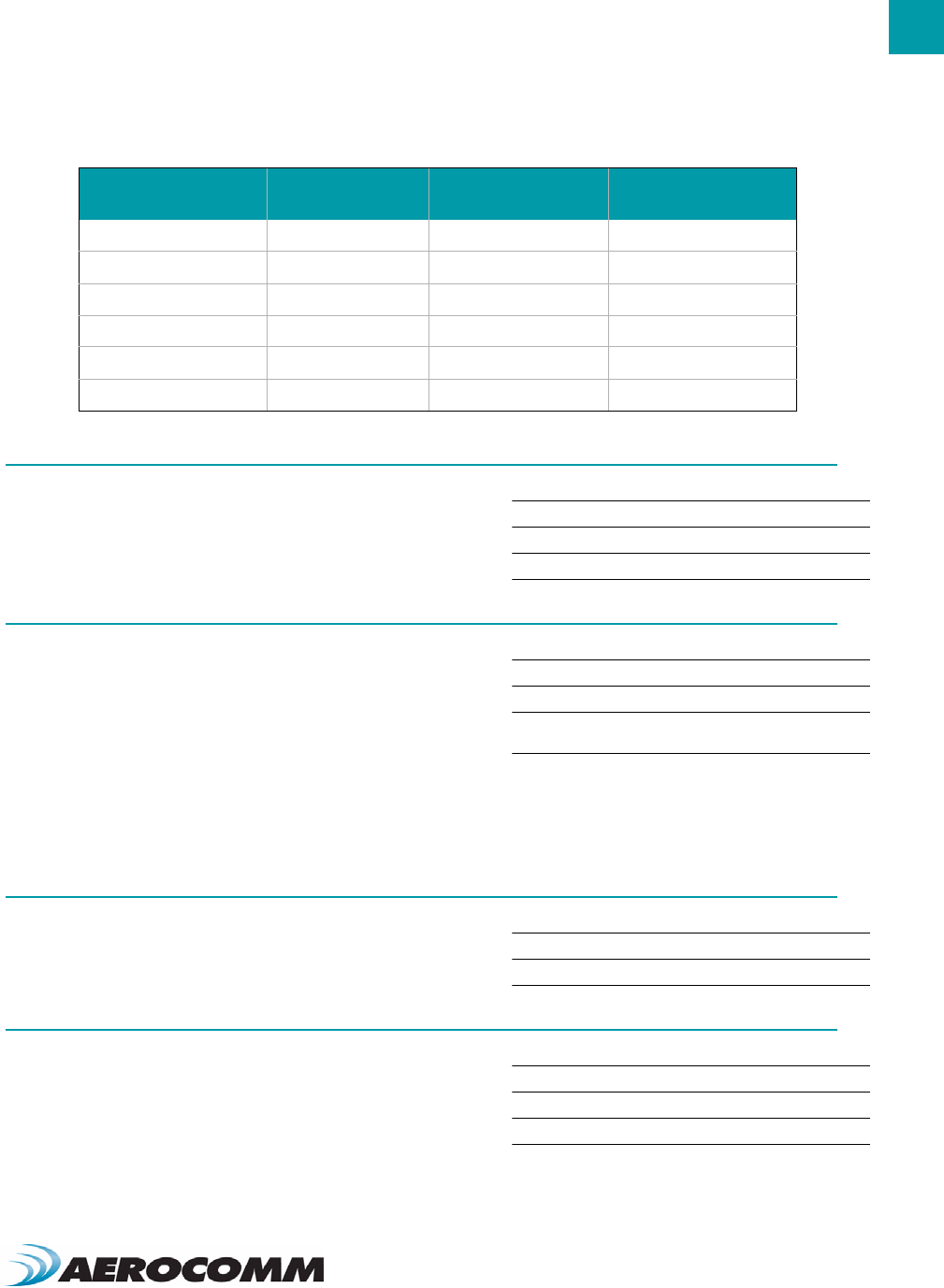
33
CONFIGURING THE AC4490
www.aerocomm.com
-42 to -39 0x0C -76 0x71
-46 0x0D -79 0x78
-49 0x0E -82 0x84
-52 0x11 -86 0x9A
-56 0x17 -89 0xAD
-59 0x1C -92 0xBD
Write Digital Outputs
The OEM Host issues this command to write both digital output lines to
particular states.
Note: This command should only be used when Protocol Status (0xC2)
is not set to 0xE3.
Command: 0xCC 0x23 <Data1>
Number of Bytes Returned: 2
Response: 0xCC <Data1>
Parameter Range: Data1 = bit-0: GO0, bit-1: GO1
Write DAC
The OEM Host issues this command to write DA_Out to a particular
voltage. The transceiver uses a PWM (Pulse Width Modulator) to
generate the analog voltage. The theory behind a PWM is that a binary
pulse is generated with a fixed duty cycle and rate. As such, this pin
toggles between High & Low. This signal is filtered via an on-board R-C
circuit and an analog voltage is generated. Duty cycle specifies the
ratio of time in one cycle that the pulse spends High proportionate to
the amount of time it spends Low. So, with a duty cycle of 50% (0x80),
the pulse is High 50% of the time and Low 50% of the time; therefore the
analog voltage would be half of 3.3V or 1.15V. A broad filter has been
implemented on the transceiver and there is no advantage to using a
slower update period. Generally, a faster update period is preferred.
Command: 0xCC 0x24 <Data1> <Data2>
Number of Bytes Returned: 3
Response: 0xCC <Data1> <Data2>
Parameter Range: Data1 = Update Period; Data2 = Duty
cycle
Set Max Power
The OEM Host issues this command to limit the maximum transmit
power emitted by the transceiver. This can be useful to minimize
current consumption and satisfy certain regulatory requirements. The
radios are shipped at maximum allowable power.
Command: 0xCC 0x25 <Max Power>
Number of Bytes Returned: 2
Response: 0xCC <Max Power>
Long Range Mode
The OEM Host issues this command to temporarily enable or disable
Long Range Mode in the transceiver.
Note: Only available on AC4490LR-200 / AC4490LR-1000 transceivers
with firmware v6.7+.
Command: 0xCC 0x27
Number of Bytes Returned: 2
Response: 0xCC <Data1>
Parameter Range: Data1 = 0x00: Disabled, 0x01: Enabled
Table 15: Received Signal Strength
Signal Strength (dBm) RSSI Value (Hex) Signal Strength
(dBm) RSSI Value (Hex)
Tupdate 255 Data1 1+()×()
14.74566
--------------------------------------------------
=
Vout Data2
0xFF
--------------- 3.3V×=

CONFIGURING THE AC4490
34
Transmit Buffer Empty
The OEM Host issues this command to determine when the RF transmit
buffer is empty. The Host will not receive the transceiver response until
that time.
Command: 0xCC 0x30
Number of Bytes Returned: 2
Response: 0xCC 0x00
Disable Sync-to-Channel
The OEM Host issues this command to disable Sync to Channel mode.
This command is valid only for Servers.
Command: 0xCC 0x85
Number of Bytes Returned: 2
Response: 0xCC <Channel>
Deep Sleep Mode
The OEM Host issues this command to put the transceiver into Deep
Sleep mode. Once in Deep Sleep mode, the transceiver disables all RF
communications and will not respond to any further commands until
being reset or power-cycled.
This command is valid for both Servers and Clients.
Command: 0xCC 0x86
Number of Bytes Returned: 2
Response: 0xCC <Channel>
Read Temperature
The OEM Host issues this command to read the onboard temperature
sensor. The transceiver reports the temperature in oC where 0x00 -
0x80 corresponds to 0 - 80 oC and where 0xD8 - 0x00 corresponds to -
40 - 0 oC.
Command: 0xCC 0xA4
Number of Bytes Returned: 2
Response: 0xCC <Temperature>
Parameter Range: Temperature = 0xD8 - 0x80
Read Temperature at Last Calibration
The OEM Host issues this command to read the temperature of the
radio at the time of its last calibration. The transceiver reports the
temperature in oC where 0x00 - 0x80 corresponds to 0 - 80 oC and
where 0xD8 - 0x00 corresponds to -40 - 0 oC.
Command: 0xCC 0xA5
Number of Bytes Returned: 2
Response: 0xCC <Temperature>
Parameter Range: Temperature = 0xD8 - 0x80
Probe
When the OEM Host issues this command, the transceiver sends out a
query every 500 ms. The transceivers, upon receiving the query,
randomly choose a query to respond to. After responding to a Probe,
the transceiver will wait at least 10 seconds before responding to
another probe.
Note: This command can only be sent from a server radio.
Transceiver’s Response
Upon hearing the remote transceiver’s probe acknowledge, the
transceiver sends a response to the OEM Host.
Command: 0xCC 0x8E <Data1>
Number of Bytes Returned: 2
Response: 0xCC <Data1>
Parameter Range: 0x00 = Disable Probe, 0x01 = Enable
Probe
Command: N/A
Number of Bytes Returned: 5
Response: 0xCC Data1 MAC3 MAC2 MAC1
Parameter Range: Data 1 = bit-7: 0 for Client, bit-7: 1 for
Server; bits 6-0: RF Channel
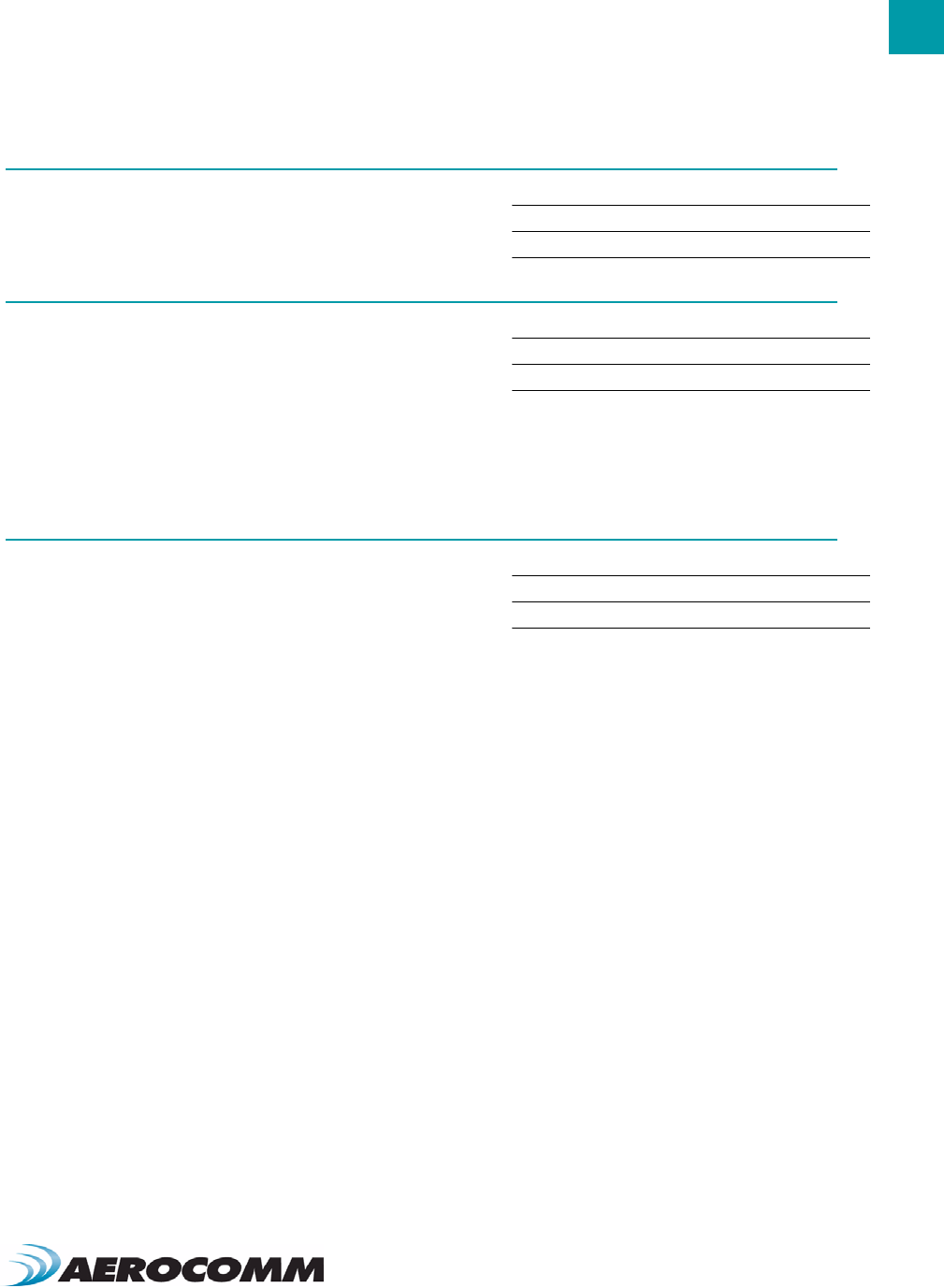
35
CONFIGURING THE AC4490
www.aerocomm.com
EEPROM Byte Read
Upon receiving this command, a transceiver will respond with the
desired data from the addresses requested by the OEM Host.
Command: 0xCC 0xC0 <Address> <Length>
Number of Bytes Returned: 4+
Response: 0xCC <Address> <Length> <Requested Data>
EEPROM Byte Write
Upon receiving this command, a transceiver will write the data byte to
the specified address but will not echo it back to the OEM Host until the
EEPROM write cycle is complete (up to 10 ms).
Multiple byte writes of up to 128 bytes are allowed. An EEPROM
boundary exists between addresses 0x7F and 0x80. No single
EEPROM write command shall write to addresses on both sides of that
EEPROM boundary.
Note: Only the last byte wriiten will be displayed in the command
response.
Command: 0xCC 0xC1 <Address> <Lenght> <Data>
Number of Bytes Returned: 4+
Response: 0xCC <Address> <Lenght> <Data written>
Reset
The OEM Host issues this command to perform a soft reset of the
transceiver. Any transceiver settings modified by CC commands will
revert to the values stored in the EEPROM.
Command: 0xCC 0xFF
Number of Bytes Returned: None
Response: None
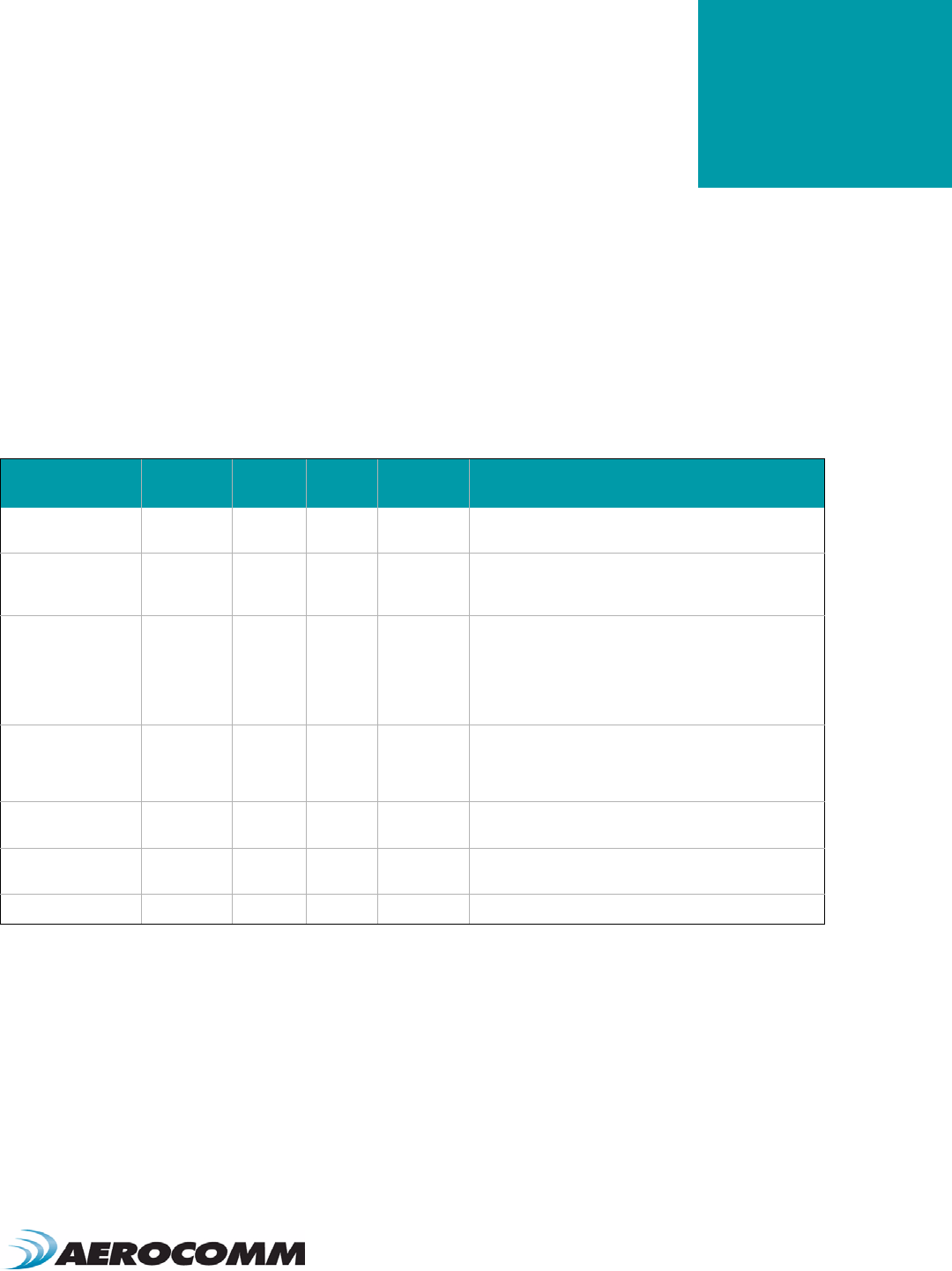
www.aerocomm.com
EEPROM PARAMETERS
9
The OEM Host can program various parameters that are stored in EEPROM which become active after a power-on
reset. The table below gives the locations and descriptions of the parameters that can be read/written by the OEM
Host. Factory default values are also shown. Do not write to any EEPROM addresses other than those listed below.
Do not copy one transceiver’s EEPROM to another transceiver as doing so may cause the transceiver to malfunction.
Table 16: EEPROM Parameters
Parameter EEPROM
Address
Length
(Bytes) Range Default Description
Product ID 0x00 40 40 bytes - Product identifier string. Includes revision
information for software and hardware.
Range Refresh 0x3D 10x01 -
0xFF
0x18 Specifies the maximum amount of time a transceiver will
report In Range without having heard a Server’s beacon
(equal to hop period * value). Do not set to 0x00.
Stop Bit Delay 0x3F 10x00 -
0xFF
0xFF For systems employing the RS-485 interface or Parity, the
serial stop bit might come too early. Stop bit delay controls
the width of the last bit before the stop bit occurs.
0xFF = Disable Stop Bit Delay (12 us)
0x00 = (256 * 1.6 us) + 12 us
0x01 - 0xFE = (value * 1.6 us) + 12 us
Channel Number 0x40 10x00 -
0x37
1x1: 0x00
200: 0x00
1000: 0x10
Set 0 = 0x00 - 0x0F (US/Canada): 1x1/200
Set 1 = 0x10 - 0x2F (US/Canada): 1x1/1000
Set 2 = 0x30 - 0x37 (US/Canada): 1x1/200;
Australia: 1x1/200/1000
Server/Client Mode 0x41 10x01 -
0x02
0x02 0x01 = Server
0x02 = Client
Baud Rate Low 0x42 10x00 -
0xFF
0xFC Low byte of the interface baud rate. Default baud rate is
57,600.
Baud Rate High 0x43 10x00 0x00 High byte of interface baud. Always 0x00

37
EEPROM PARAMETERS
www.aerocomm.com
Control 0 0x45 10x00 -
0xFF
0x14 Settings are:
bit-7: One Beacon Mode
0 = Beacon every hop (disabled)
1 = Beacon once per hop cycle (enabled)
bit-6: DES Enable
0 = Disable Encryption
1 = Enable Encryption
bit-5: Sync to Channel
0 = Disabled
1 = Enabled
bit-4: Aerocomm Use Only
bit-3: Aerocomm Use Only
bit-2: Aerocomm Use Only
bit-1: RF Delivery
0 = Addressed packets
1 = Broadcast packets
bit-0: Aerocomm Use Only
Frequency Offset 0x46 10x00 -
0xFF
0x01 Protocol parameter used in conjunction with Channel
Number to satisfy unique regulations.
CMD/Data RX Disable 0x4B 10xE3,
0xFF
0xFF oxE3 = Enable CMD/Data RX Disable
0xFF = Disable CMD/Data RX Disable
Transmit Retries 0x4C 10x01 -
0xFF
0x10 Maximum number of times a packet is sent out when
Addressed packets are selected.
Broadcast Attempts 0x4D 10x01 -
0xFF
0x04 Maximum number of times a packet is sent out when
Broadcast packets are selected.
API Control 0x56 10x00 -
0xFF
0x43 Settings are:
bit-7: Aerocomm Use Only
bit-6: Aerocomm Use Only
bit-5: Unicast Only
0 = Disabled
1 = Enabled
bit-4: Auto Destination
0 = Use destination address
1 = Use auto destination
bit-3: Client Auto Channel
0 = Disabled
1 = Enabled
bit-2: RTS Enable
0 = Ignore RTS
1 = Transceiver obeys RTS
bit-1: Duplex
0 = Half Duplex
1 = Full Duplex
bit-0: Auto Config
0 = Use EEPROM values
1 = Auto Configure values
Interface Timeout 0x58 10x02 -
0xFF
0x04 Specifies a byte gap timeout, used in conjunction with RF
Packet Size to determine when a packet coming over the
interface is complete (0.5 ms per increment).
Sync Channel 0x5A 10x00 -
0xFF
0x01 Used to synchronize the hopping of collocated systems to
minimize interference.
Table 16: EEPROM Parameters
Parameter EEPROM
Address
Length
(Bytes) Range Default Description
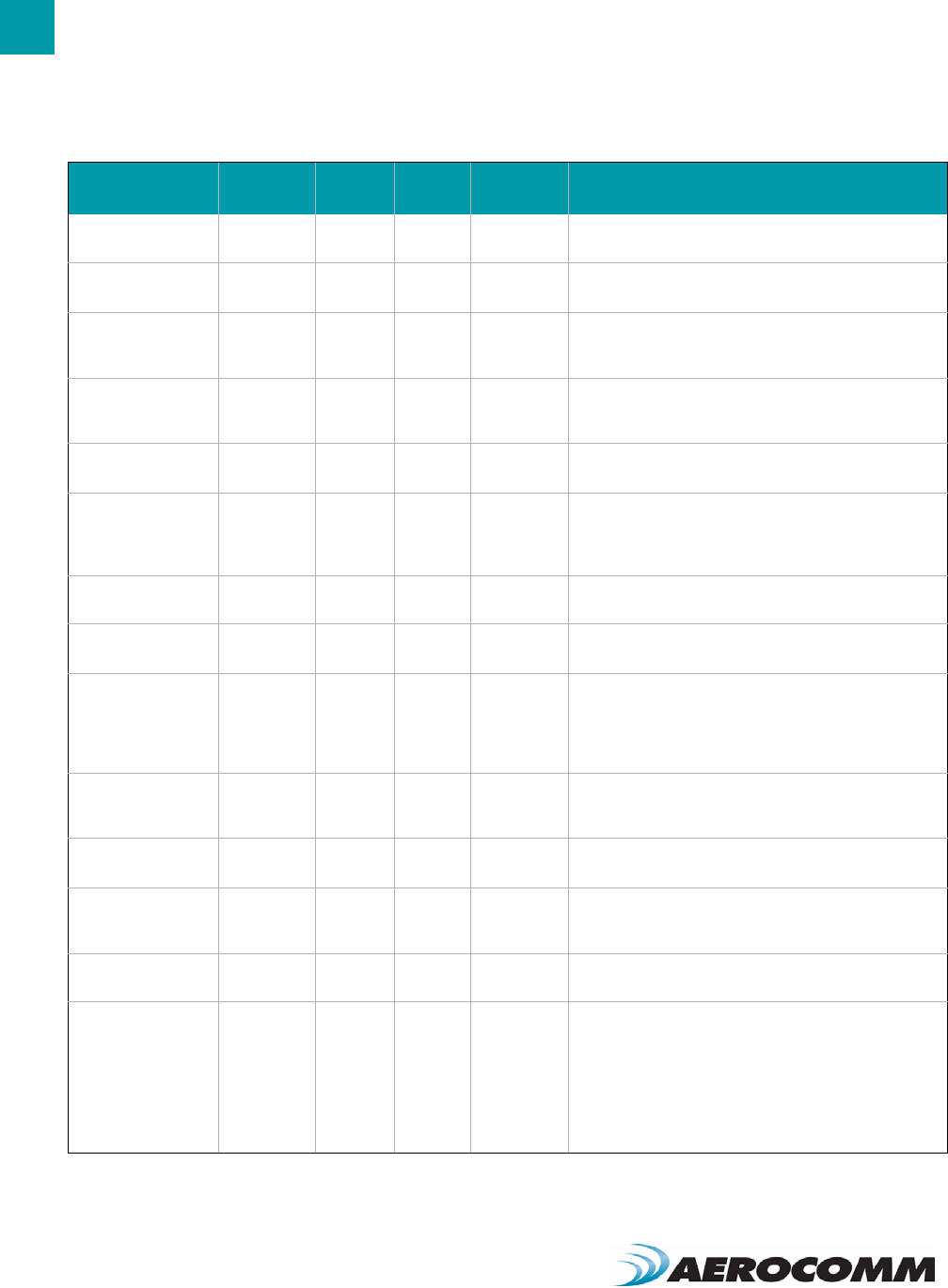
EEPROM PARAMETERS
38
RF Packet Size 0x5B 10x01 -
0x80
0x80 Used in conjunction with Interface Timeout; specifies the
maximum size of an RF packet.
CTS On 0x5C 10x01 -
0xFF
0xD2 CTS will be deasserted (High) when the transmit buffer
contains at least this many characters.
CTS Off 0x5D 10x00 -
0xFE
0xAC Once CTS has been deasserted, CTS will be reasserted
(Low) when the transmit buffer is contains this many or less
characters.
Max Power 0x63 10x00 -
0x60
Set in
Production
& can vary
Used to increase/decrease the output power. The
transceivers are shipped at maximum allowable power.
Modem Mode 0x6E 10xE3,
0xFF
0xFF oxE3 = Enable Modem Mode
0xFF = Disable Modem Mode
Parity 0x6F 10xE3,
0xFF
0xFF 0xE3 = Enable Parity
0xFF = Disable Parity
Note: Enabling parity cuts throughput and the interface buffer
size in half.
Destination ID 0x70 60x00 -
0xFF
0xFF Specifies destination for RF packets
System ID 0x76 10x00 -
0xFF
0x01 Similar to network password. Radios must have the same
system ID to communicate with each other.
Long Range Mode 0x7D 10xE3,
0xFF
0xE3 Used to enable/disable Long Range mode.
0xE3 = Enable Long Range Mode
0xFF = Disable Long Range Mode
Note: Only valid on AC4490LR-200 and AC4490LR-1000
transceivers with firmware v6.7+.
RS-485 DE 0x7F 10xE3,
0xFF
0xFF 0xE3 = GO0 is active Low DE for control of external RS-485
hardware
0xFF = Disable RS-485 DE
MAC ID 0x80 60x00 -
0xFF
Factory programmed unique IEEE MAC address.
Original Max Power 0x8E 1Set in
Production
and can vary
Copy of original max power EEPROM setting. This address
may be referenced but should not be modified.
RS485 Modem Mode 0x8F 10xE3,
0xFF
0xFF oxE3 = Enable RS485 Modem Mode
0xFF = Disable RS485 Modem Mode
Product ID 0x90 15 0x90 - 0x93: Product ID
0x94 - 0x95: Prefix (CL, CN, or AC)
0x96 - 0x99: Power (200M, 200A, 1000, 1x1)
Note: There will be a period in front of the 1x1 to keep the
field at four bytes
0x9A - 0x9C: Interface (232, 485, TTL)
0x9D - 0x9E: Setup script (01 is stock)
0x9F: Reserved for future use; always 0xFF
Table 16: EEPROM Parameters
Parameter EEPROM
Address
Length
(Bytes) Range Default Description
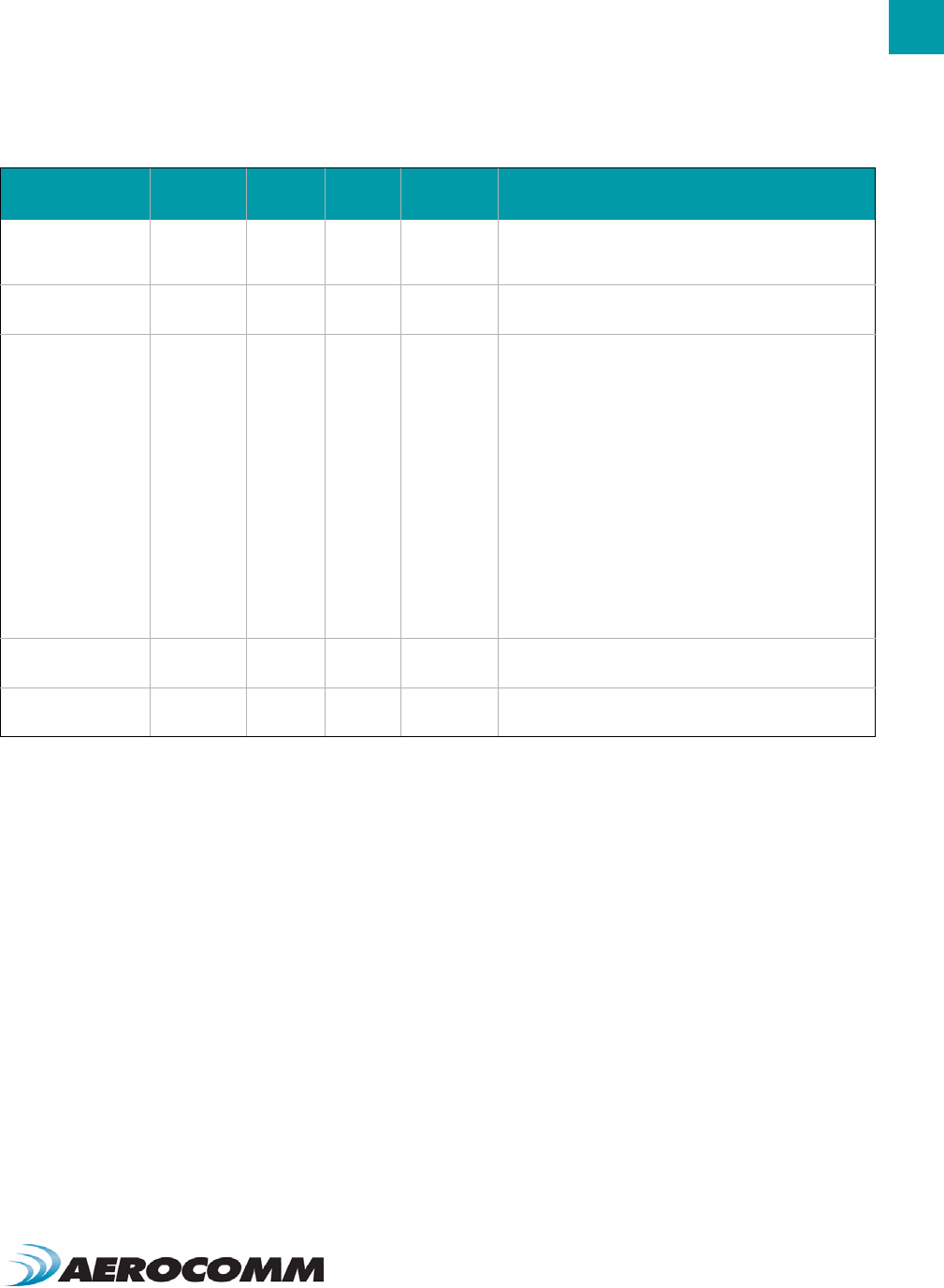
39
EEPROM PARAMETERS
www.aerocomm.com
Protocol Status /
Receive ACK
0xC0 10xE3,
oxFF
oxFF oxE3 = GO0 outputs the Protocol Status and GO1 outputs
the Received Acknowledgement signal
0xFF = Disable Protocol Status / Receive ACK
Receive API 0xC1 10xE3,
0xFF
0xFF 0xE3 = Enabled
0xFF = Disabled
Enhanced API
Control
0xC6 10xF8 Settings are:
bit-7: Enhanced API Control Enable
0 = Enable Enhanced API Control
1 = Disable Enhanced API Control
bit-6: Aerocomm Use Only
bit-5: Aerocomm Use Only
bit-4: Aerocomm Use Only
bit-3: Aerocomm Use Only
bit-2: Send Data Complete Enable
0 = Disable
1 = Enable
bit-1: API Transmit Packet Enable
0 = Disable
1 = Enable
bit-0: Enhanced API Receive Packet Enable
0 = Disable
1 = Enable
Auto Calibrate 0xCC 10xE3,
0xFF
0xFF oxE3 = Enable Auto Calibrate
0xFF = Disable Auto Calibrate
DES Key 0xD0 70x00 -
0xFF
56-bit Data Encryption key
Table 16: EEPROM Parameters
Parameter EEPROM
Address
Length
(Bytes) Range Default Description
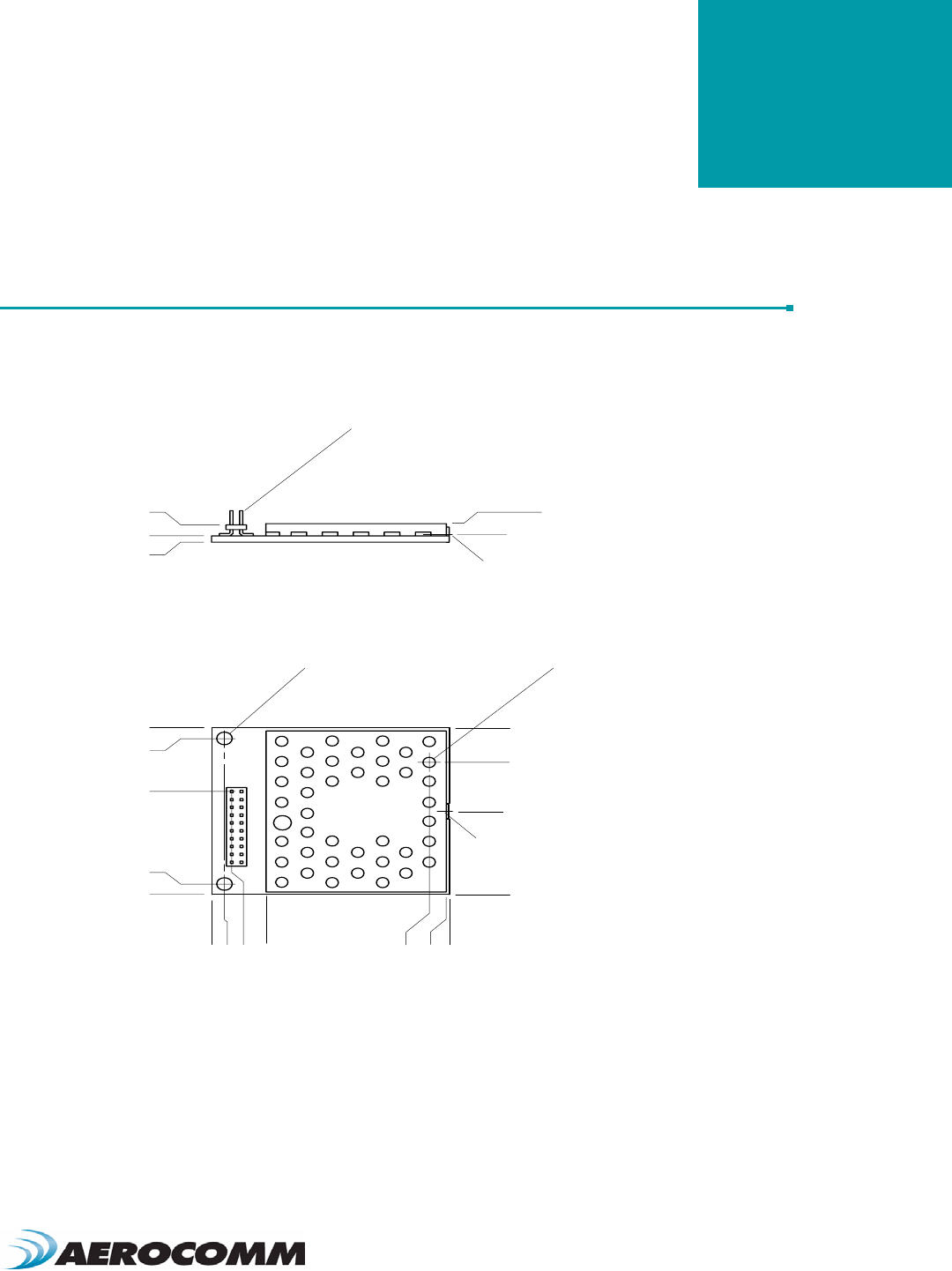
www.aerocomm.com
DIMENSIONS
10
MECHANICAL DRAWINGS
Interface Connector - 20 pin OEM Interface connector (Molex 87759-0030, mates with Samtec SMM-110-02-S-D
MMCX Jack - Antenna Connector (Johnson Components 135-3711-822)
Figure 10: AC4490 (with MMCX connector) Mechanical
0.000
0.100
0.150
0.435
1.900
1.875
0.825
0.125 dia non-plated holes
(2) places
0.000
0.100
1.010
1.650
1.550
pins
1 2
1.650
0.000
0.067
0.000
0.157
0.062
0.180
MMCX jack
J1
20 pin header, 0.020 sq. posts
on 0.079 inch (2mm) centers
1.320
1.760
0.100 dia non-plated hole
(1) place, under shield
MMCX jack 0.145 dia
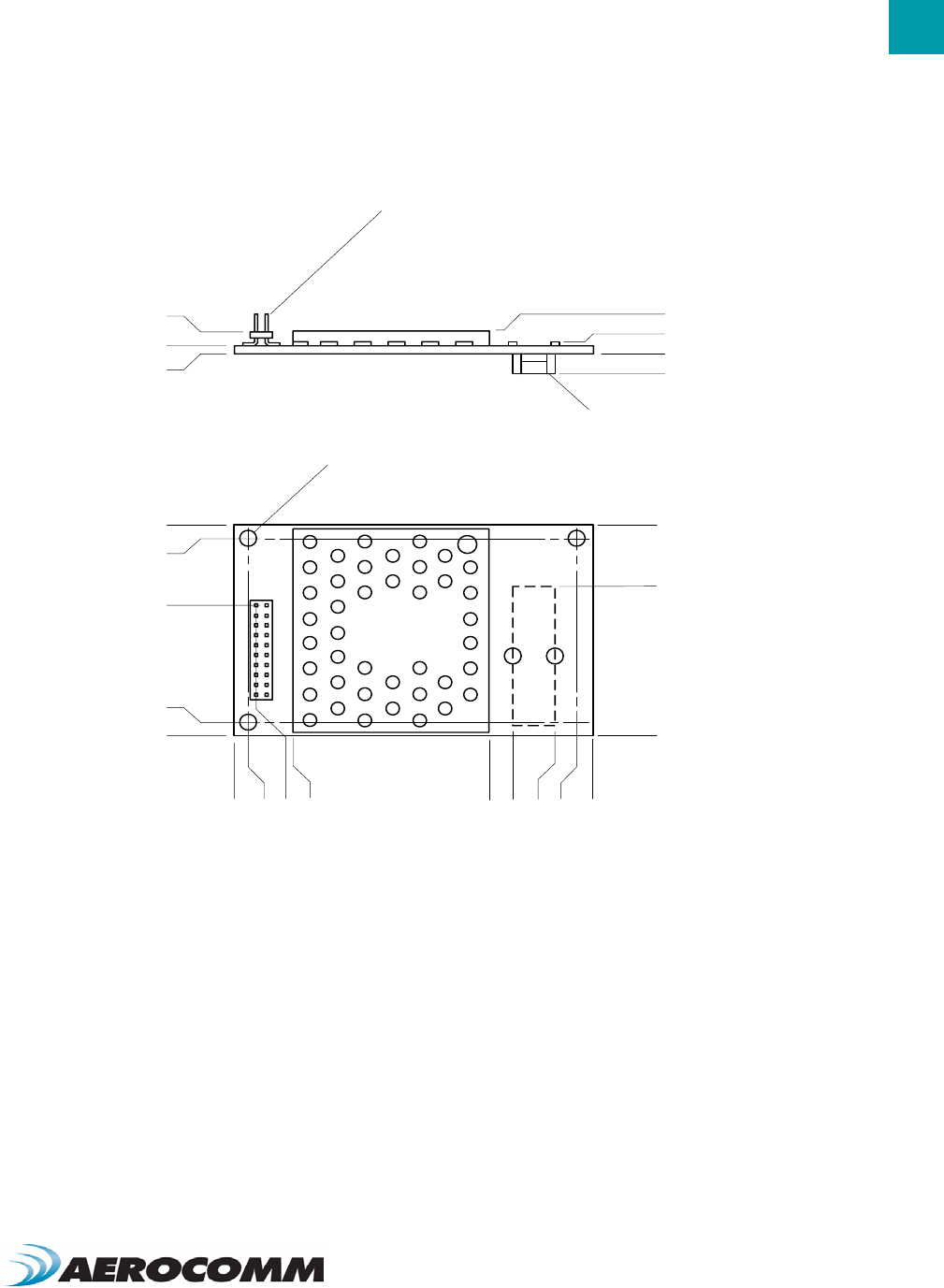
41
DIMENSIONS
www.aerocomm.com
Figure 11: AC4490 with integral gigaAnt Antenna (on bottom) Mechanical
0.000
0.100
0.150
1.875
2.550
2.650
0.435
0.125 dia non-plated holes
(4) places
0.000
0.100
1.010
1.650
1.550
pins
1 2
1.650
0.000
0.000
0.157
0.062
J1
20 pin header, 0.020 sq. posts
on 0.079 inch (2mm) centers
-0.152
0.000
0.180
0.086
1.180
2.030
2.345
GigaAnt Snap-In Antenna
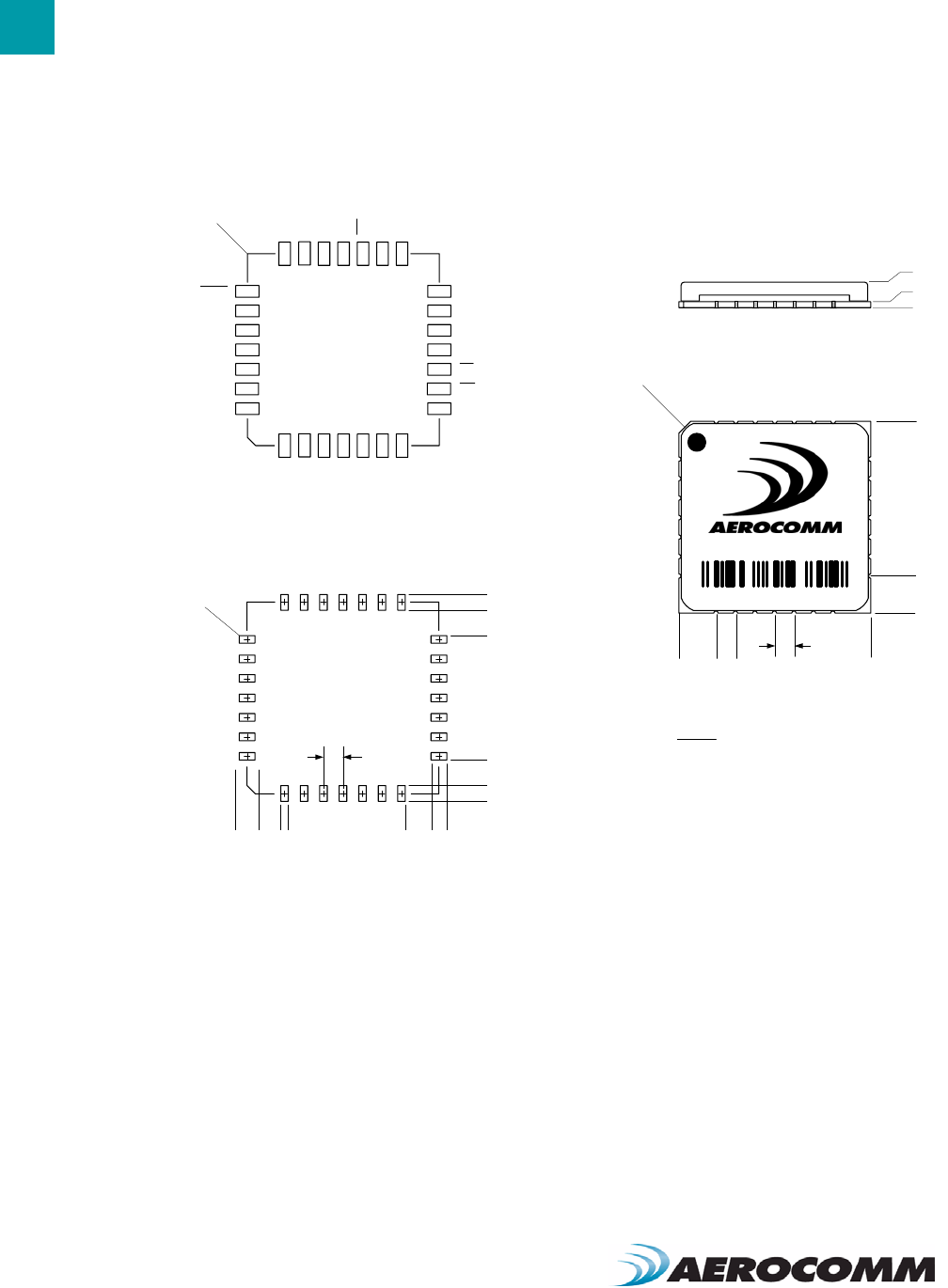
DIMENSIONS
42
Figure 12: AC4490-1x1 Mechanical
0.000
0.200
0.300
0.000
0.080
1.000
1.080
cut corner
indicates pin 1
0
.
0
.
0
.
AC4490-1X1
1
0
0.100 typ.
0
1.000
005068004503
0.220
0.260
0.10 typ.
0.860
0.080 x 0.040 pad
typical
RECOMMENDED PAD PATTERN
(viewed from top)
0.000
0.080
0.220
0.860
1.000
1.080
Module Outline
28
1
27
234567
26
25
24
23
22
21 20 19 18 17 16 15
8
9
10
11
12
13
14
N/C
CTS
RTS
VCC (note 1)
RSSI
GND (note 2)
RF_PORT
AD_IN
UP_RESET
CMD/DATA
IN_RANGE
DO1
DA_OUT
DI1
N/C
N/C
N/C
N/C
N/C
9600_BAUD (TST_MODE)
RESET
RXD
TXD
DI0
DO0
GND
VCC (note 1)
HOP_FRAME
Notes:
1) VCC must not exceed +3.3V DC.
2) This GND pin to be used for RF ground
3) Operating temperature -40C to +80C
3) Storage temperature -60C to +140C

43
DIMENSIONS
www.aerocomm.com
Figure 13: AC4490-1x1 PCB Considerations
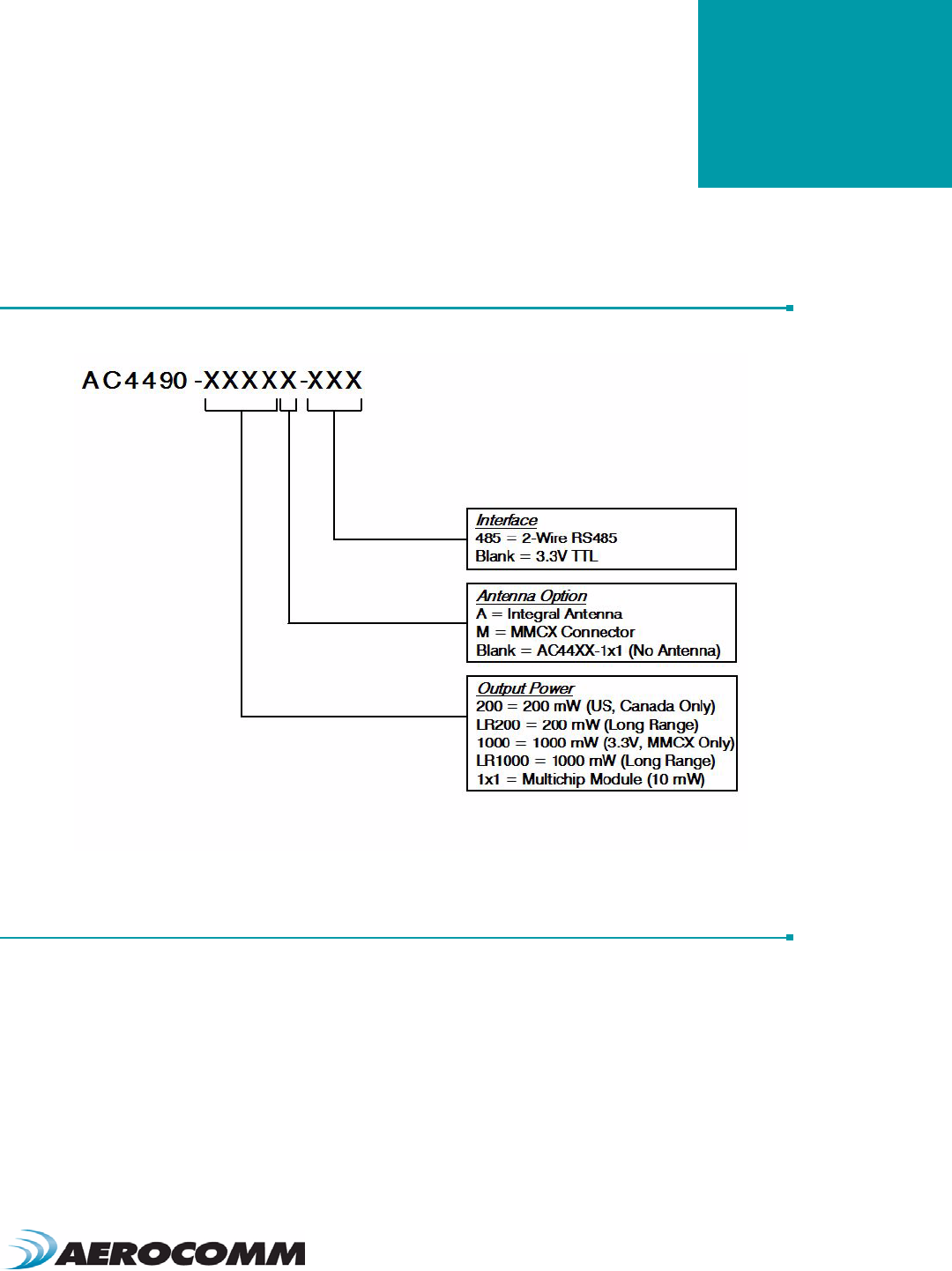
www.aerocomm.com
ORDERING INFORMATION
11
PRODUCT PART NUMBER TREE
DEVELOPER KIT PART NUMBERS
All of the above part numbers can be ordered as a development kit by prefacing the part number with “SDK-”. As an
example, part number AC4490-200A can be ordered as a development kit using the part number: SDK-AC4490-200A.
All developer’s kits include (2) transceivers, (2) development boards, (2) 7.5 VDC unregulated power supplies, (2)
serial cables, (2) USB cables, (2) antennas, configuration/testing software and integration engineering support.
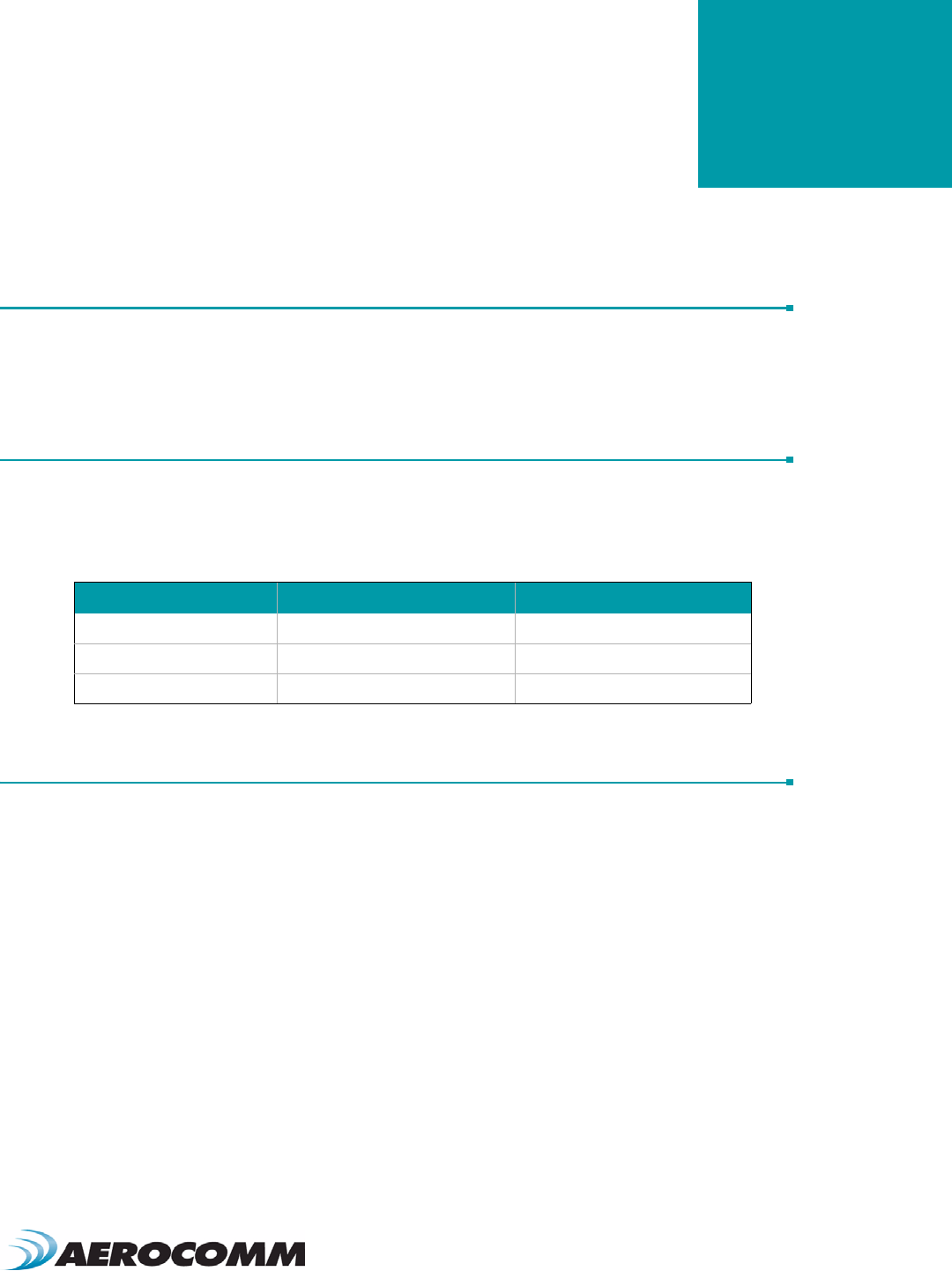
www.aerocomm.com
COMPLIANCY INFORMATION
12
AC4490-1X1
Due to the RF antenna trace residing on the OEM Host PCB, the FCC will not grant modular approval for the AC4490-
1x1 and requires the OEM to submit their completed design for approval. Contact AeroComm for the approval
procedure.
AGENCY IDENTIFICATION NUMBERS
Agency compliancy is a very important requirement for any product development. AeroComm has obtained modular
approval for its products so the OEM only has to meet a few requirements to be eligible to use that approval. The
corresponding agency identification numbers and approved antennas are listed below.
APPROVED ANTENNA LIST
The following antennas are approved for use with the AC4490 as identified. The OEM is free to choose another
vendor’s antenna of like type and equal or lesser gain as a listed antenna and still maintain compliance.
Table 13: Agency Identification Numbers
Part Number US/FCC Canada/IC
AC4490-200AKQLAC4490-100 2268C-AC4490
AC4490-200/AC4490LR-200 KQL-4X90-200 2268C-4X90200
AC4490-1000KQL-AC4490 2268C-AC44901000
To reduce potential radio interference to other users, the antenna type and its gain should be so chosen that the
equivalent isotropically radiated power (e.i.r.p.) is not more than that permitted for successful communication.
This device has been designed to operate with the antennas listed below, and having a maximum gain of 11.0 dBd.
Antennas not included in this list or having a gain greater than 11.0 dBd are strictly prohibited for use with this
device. The required antenna impedance is 50 ohms.
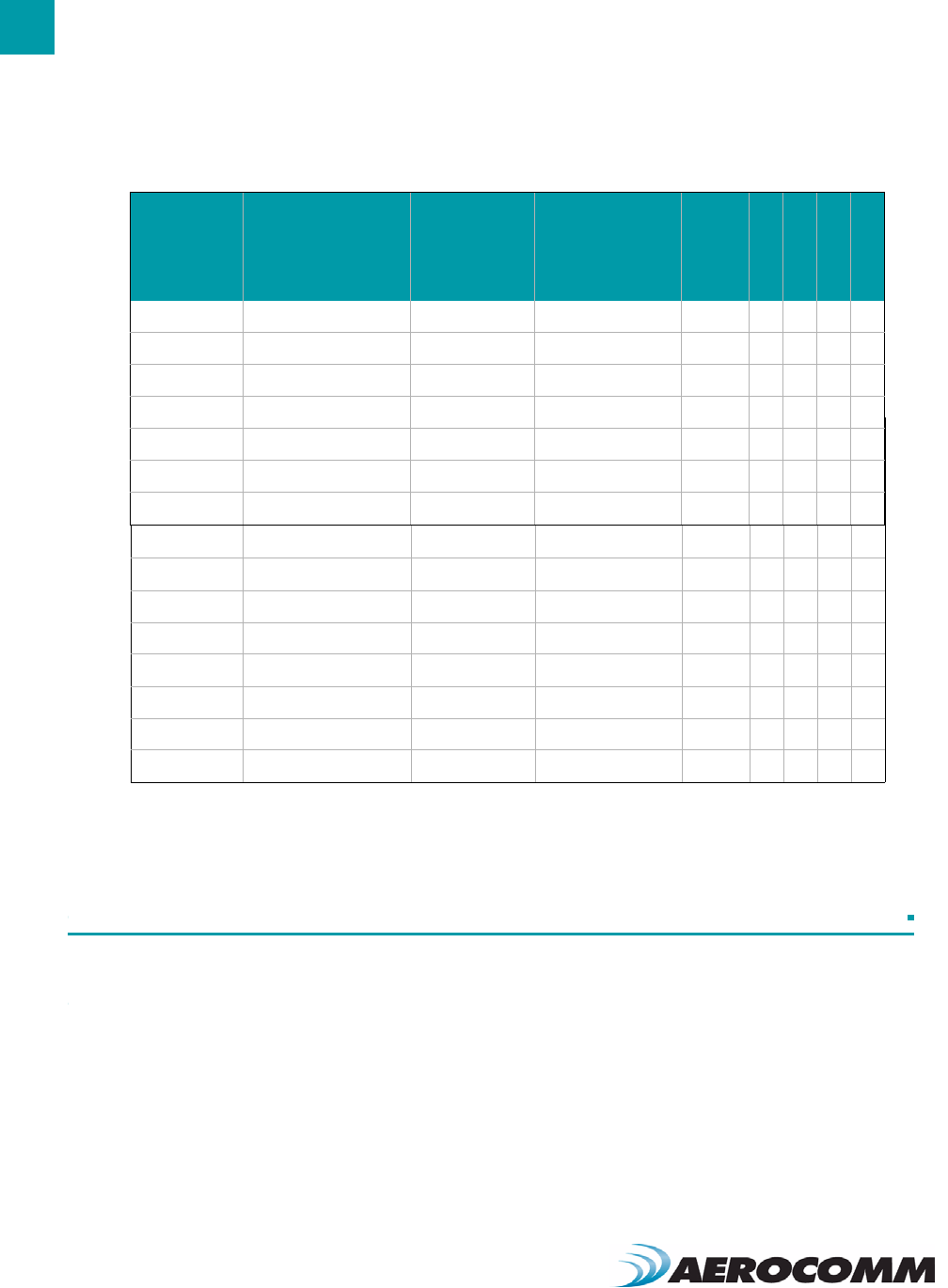
COMPLIANCY INFORMATION
46
FCC / IC REQUIREMENTS FOR MODULAR APPROVAL
In general, there are two agency classifications of wireless applications; portable and mobile.
Portable - Portable is a classification of equipment where the user, in general, will be within 20 cm of the transmitting
antenna. Portable equipment is further broken down into two classes; within 2.5 cm of human contact and beyond
2.5 cm (Note: Ankles, feet, wrists, and hands are permitted to be within 2.5 cm of the antenna even if the equipment is
designated as being greater than 2.5 cm). The AC4790 is not agency approved for portable applications. The OEM is
required to have additional testing performed to receive this classification. Contact AeroComm for more details.
Mobile - Mobile defines equipment where the user will be 20 cm or greater from the transmitting equipment. The
antenna must be mounted in such a way that it cannot be moved closer to the user with respect to the equipment,
although the equipment may be moved. (Note: Ankles, feet, wrists, and hands are permitted to be within 20 cm of
mobile equipment).
-1020B5812-04 Flavus gigaAnt Microstrip -0.5 X - - -
-Y22831Comtelco Yagi 6 dBd - X X X
-Y2283A0915-10RP Comtelco Yagi 6 dBd - X X X
-SG101N9152Nearson Omni 5 - X X X
-SG101NT-915 Nearson Omni 5 - X X X
-GM113 V.Torch Omni 3.5 - X X -
-PC8910NRTN Cushcraft Yagi 11 dBd - - X -
-ANT-DB1-RMS Antenna Factor Monopole 3 - X X -
1. Strictly requires professional installation.
2. Strictly requires professional installation.
Table 18: AC4490 Approved Antennas
AeroComm
Part
Number
Manufacturer Part
Number Manufacturer Type Gain
(dBi)
2
0
0
A
2
0
0
M
2
0
0
L
R
1
0
0
0
M
0600-00019 S467FL-5-RMM-915S Nearson 1/2 Wave Dipole 2 - X X X
0600-00025 S467FL-5-RMM-915 Nearson 1/2 Wave Dipole 2 - X X X
0600-00024 S467AH-915 Nearson 1/2 Wave Dipole 2 - X X X
0600-00027 S467AH-915R Nearson 1/2 Wave Dipole 2 - X X X
0600-00028 S161AH-915R Nearson 1/2 Wave Dipole 2.5 - X X X
0600-00029 S161AH-915 Nearson 1/2 Wave Dipole 2.5 - X X X
0600-00030 S331AH-915 Nearson 1/4 Wave Dipole 1 - X X X
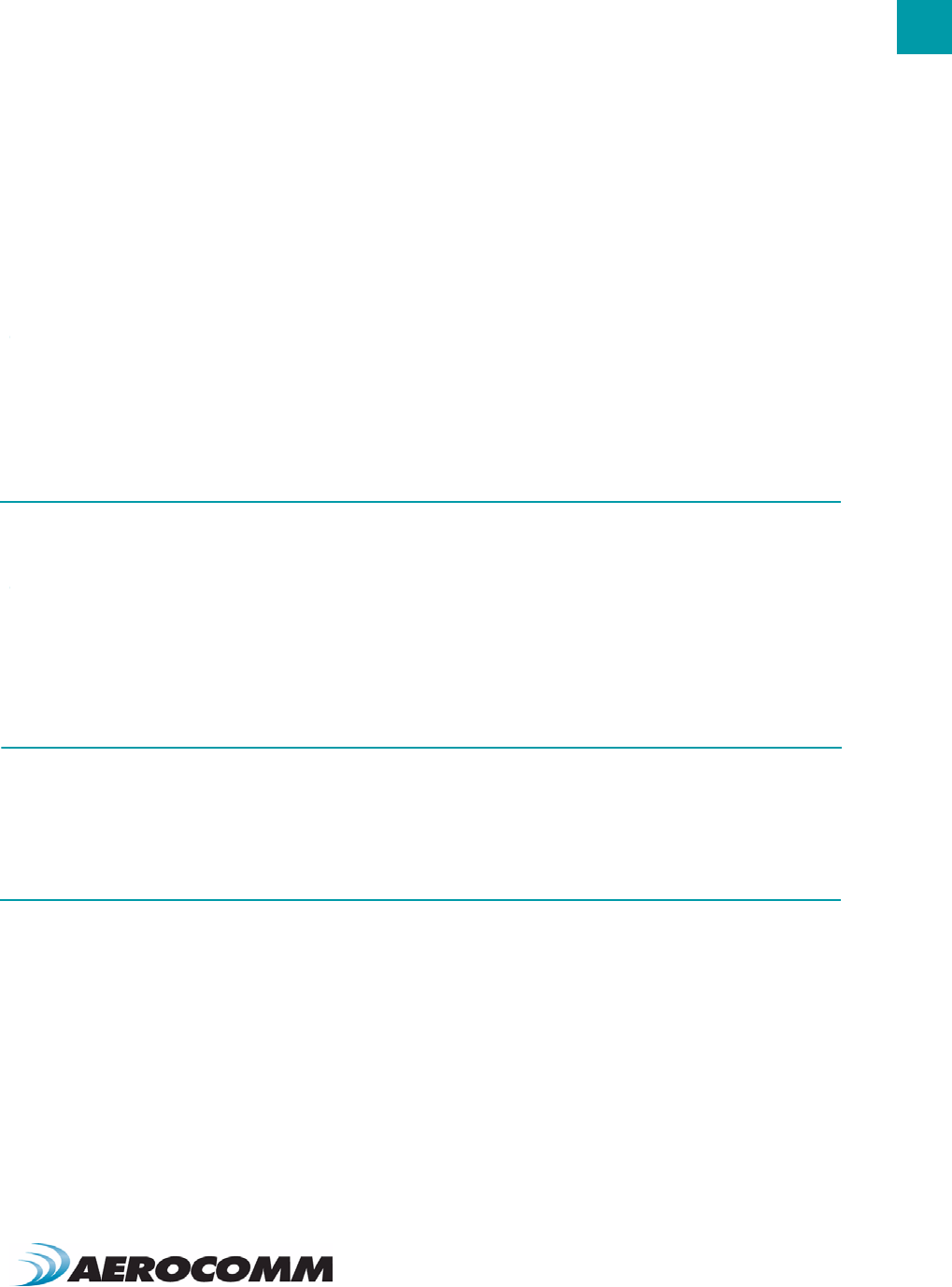
47
COMPLIANCY INFORMATION
www.aerocomm.com
Label and text information should be in a size of type large enough to be readiily legible, consistent with the
dimensions of the equipment and the label. However, the type size for the text is not required to be larger than eight
point.
ANTENNA REQUIREMENTS
WARNING: This device has been tested with an MMCX connector with the above listed antennas. When integrated
into the OEM’s product, these fixed antennas require professional installation preventing end-users from replacing
them with non-approved antennas. Antenna Y2283 & SG101N915 strictly require professional installation. Any
antenna not in the previous table must be tested to comply with FCC Section 15.203 for unique antenna connectors
and Section 15.247 for emissions. Contact AeroComm for assistance.
Caution: Any change or modification not expressly approved by AeroComm could void the user's authority to operate
the equipment.
WARNINGS REQUIRED IN OEM MANUALS
WARNING: This equipment has been approved for mobile applications where the equipment should be used at
distances greater than 20 cm from the human body (with the exception of hands, feet, wrists, and ankles). Operation
at distances of less than 20 cm is strictly prohibited and requires additional SAR testing.
CHANNEL WARNING
The OEM must prevent the end-user from selecting a channel not approved for use by the FCC.
OEM EQUIPMENT LABELING REQUIREMENTS
WARNING: The OEM must ensure that FCC labeling requirements are met. This includes a clearly visible label on the
outside of the OEM enclosure specifying the appropriate AeroComm FCC identifier for this product as well as the FCC
notice below. The FCC identifiers are listed above.
Contains FCC ID: KQLAC4490-100 / KQLAC4490 / KQL-4X90200
Operation is subject to the following two conditions: (1) this device may not cause
interference, and (2) this device must accept any interference, including interference
that may cause undesired operation of the device.
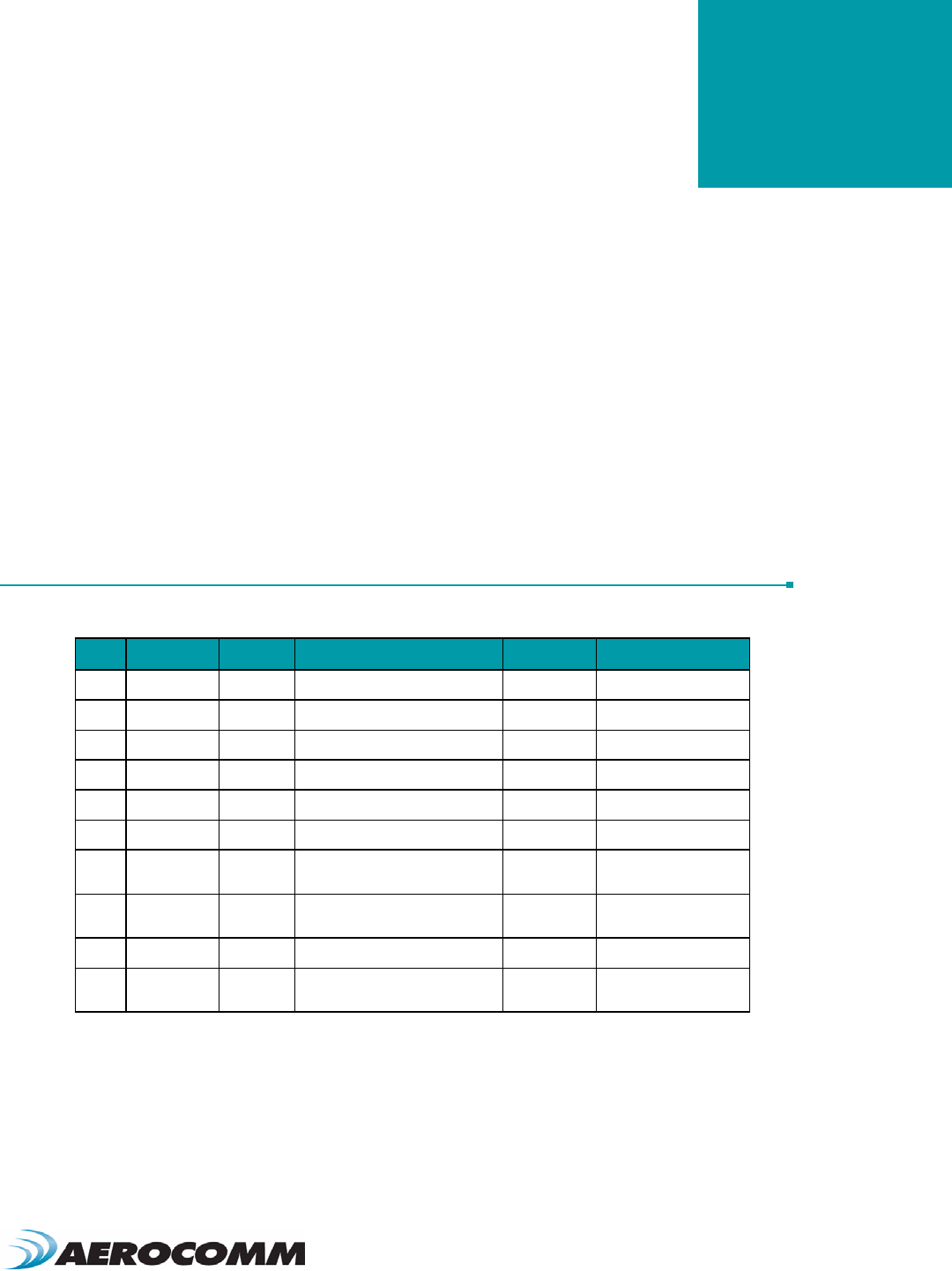
www.aerocomm.com
APPENDIX I - SAMPLE POWER SUPPLY
I
Below is a simple switching power supply that provides enough current to easily power any Aerocomm OEM module.
It utilizes low cost, off the shelf components that fit into a small area. This supply has an input voltage range of +6
volts to +18 volts and will output +3.4 volts at 1.5 amps.
Included is a schematic, bill of materials with manufacture's name and part numbers and a sample PCB layout. It is
important to follow the layout suggestions and use large areas of copper to connect the devices as shown in the
layout. It is also important to hook up the ground traces as shown and use multiple vias to connect input and output
capacitors to the bottom side ground plane.
If the input voltage will be less than 12 volts then C1 and C2 can be replaced with a single 100uF 20 volt capacitor
(same part number as C7). This will reduce board space and lower costs further. If you are powering an AC5124
module, R1 can be changed to a 373 ohm 1% resistor. This will change the output to +5 volts at 1.0 amps.
BILL OF MATERIALS
Table 19: Power Supply Bill of Materials
Qty Reference Value Description Mfg. Mfg. part number
1 R1 210 Res, 0603, 210, 1/16W, 1% KOA RK73H1JT2100F
1 R2 127 Res, 0603, 127, 1/16W, 1% KOA RK73H1JT1270F
2 C1 C2 47uF Cap, Tant, 7343, 47uF, 35V AVX TPSE476M035R0200
3 C3 C4 C5 0.1uF Cap, Cer, 0603, 0.1uF, Y5V, 25V Murata GRM39Y5V104Z025AD
1 C6 3300pF Cap, Cer, 0603, 3300pF, X7R, 50V Murata GRM39X7R332K050AD
1 C7 100uF Cap, Tant, 7343, 100uF, 20V Kemet T491X107K020A5
1 D1 B230/A Diode, SMB, B230/A, 2A, Schott-
key
Diodes, Inc. B230/A
1 D2 LL4148 Diode, MELF, LL4148, Switch
Diode
Diodes, Inc. LL4148
1 L1 15uH Xfmr, 2P, SMT, 15uH, 2A Coiltronics UP2.8B150
1 U1 CS51413 IC, CS51413, 8P, SO, Switch Reg
Ctrl.
On-Semi-
cond.
CS51413
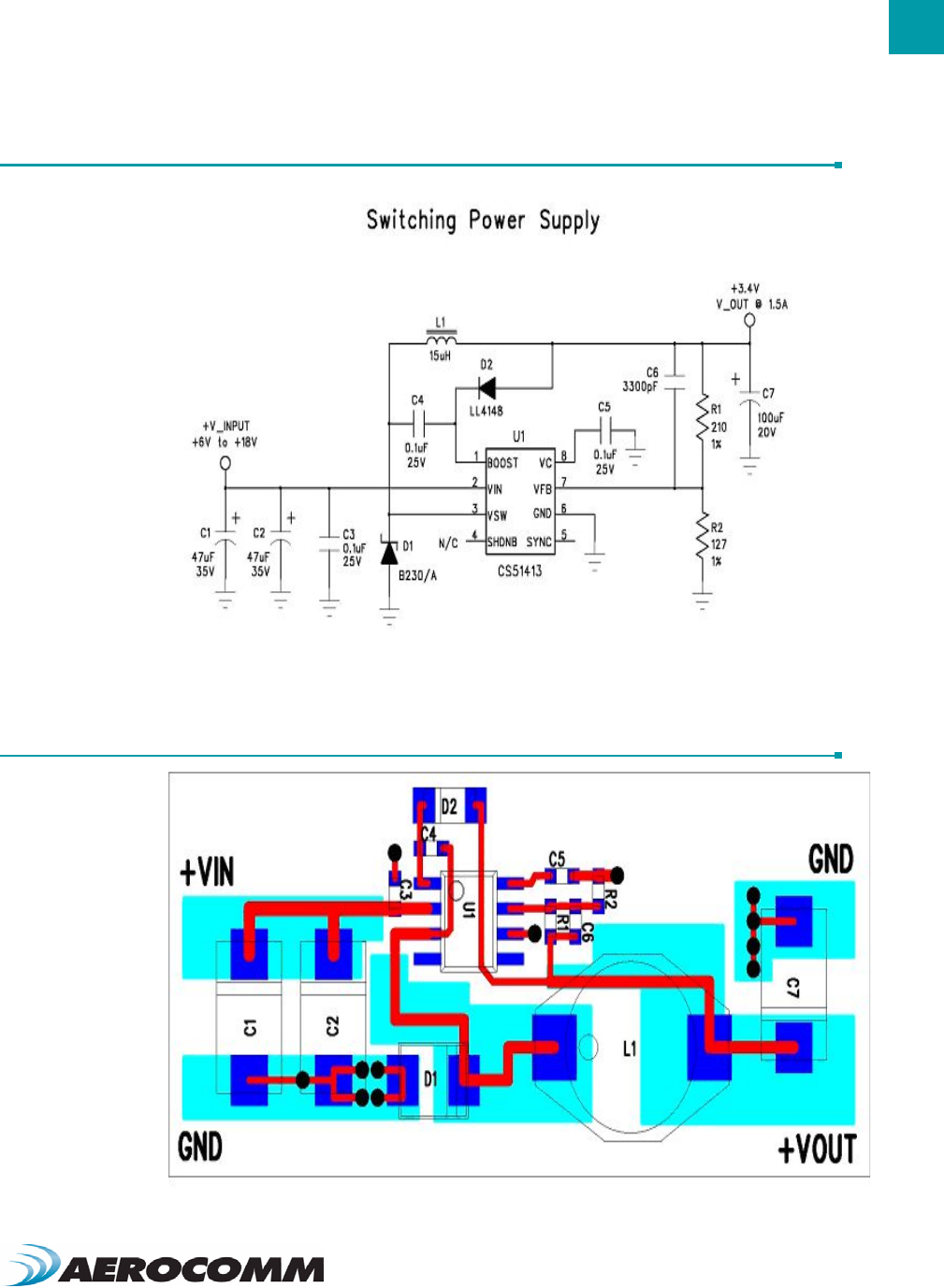
49
APPENDIX I - SAMPLE POWER SUPPLY
www.aerocomm.com
SCHEMATIC
PCB LAYOUT

APPENDIX I - SAMPLE POWER SUPPLY
50
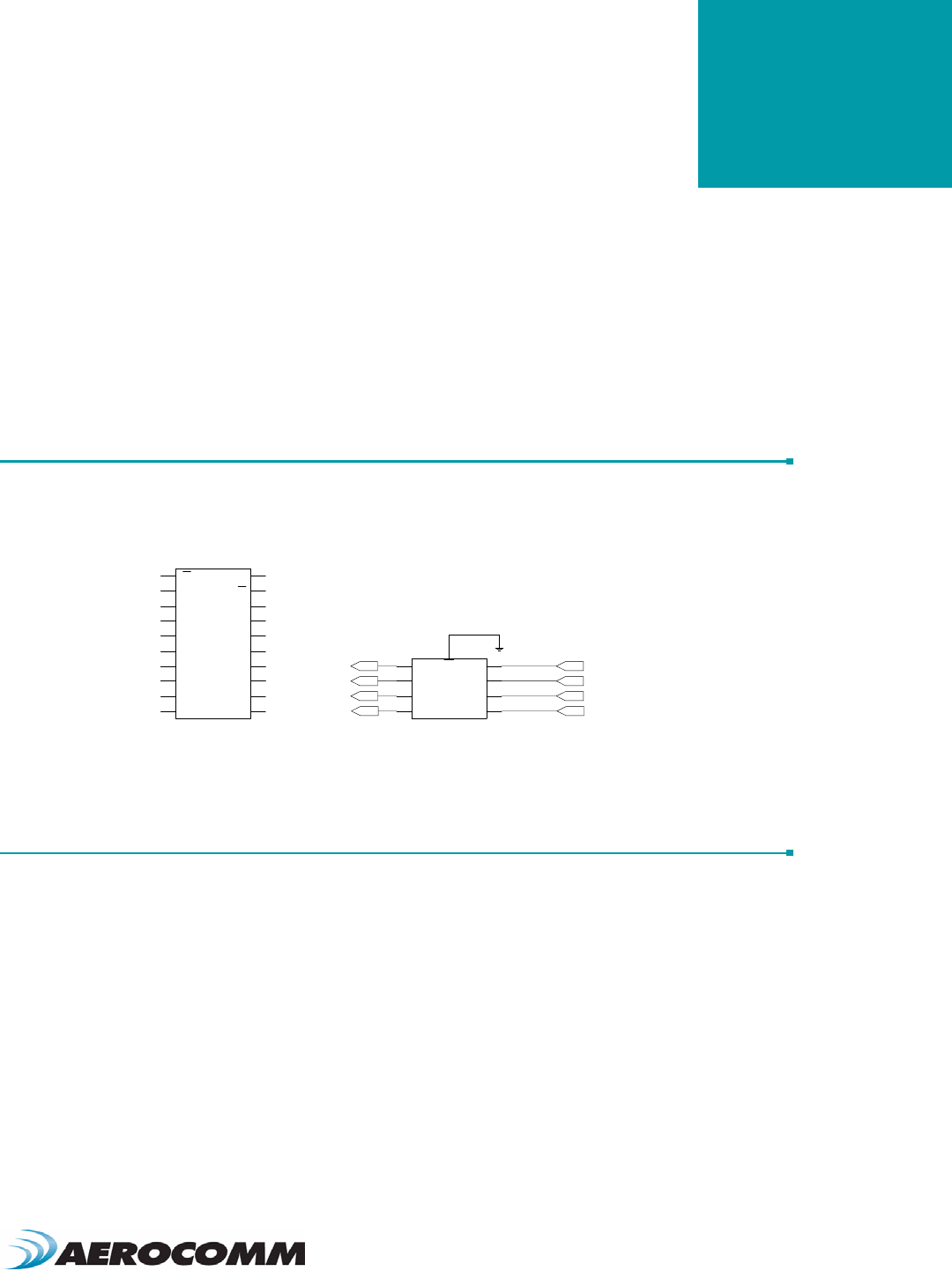
www.aerocomm.com
APPENDIX II - 5V TO 3.3V LEVELS
II
All inputs on the AC4490-200 & AC4490-1000 are weakly pulled high via 10 kohm resistors. The AC4490-200 has 5V
inputs while the AC4490-1000 & AC4490-1x1 have 3.3V inputs. The AC4490-200 uses an octal buffer to drop the 5V to
the required 3.3V level; the -1000 and -1x1 leave this to the OEM.
Some of the most common voltage conversion methods are described below.
VOLTAGE LEVEL CONVERSION IC’S
This is the easiest and most efficient method. Aerocomm recommends the TI SN74LVC244A Octal Buffer/Driver.
Inputs can be driven from either 3.3 or 5V systems, allowing the device to be used in a mixed 3.3/5V system.
PASSIVE RESISTOR VOLTAGE DIVIDER
While a resistor voltage divider can successfully drop the 5V to the required 3.3V, it will draw static current all of the
time. Typically this method is only suitable for one-way 5V to 3.3V conversion. When choosing the resistor values,
one needs to include the radio’s internal 10 kohm resistors on the input signals.
74LVC244
2Y0
GND
92Y0
10 GND
1Y3
2A0
1Y3
2A0
12
11
1OE
1
1A0
2
32Y3
41A1
VCC
2OE
1Y0
2A3
20
19
18
17
2Y2
5
1A2
6
72Y1
81A3
1Y1
2A2
1Y2
2A1
16
15
14
13
Y0
18
Y1
16
14 Y2
12 Y3
A0
A1
A2
A3
2
4
6
8
OE
1
Input A
Input B
Input C
Input D
74LVC244
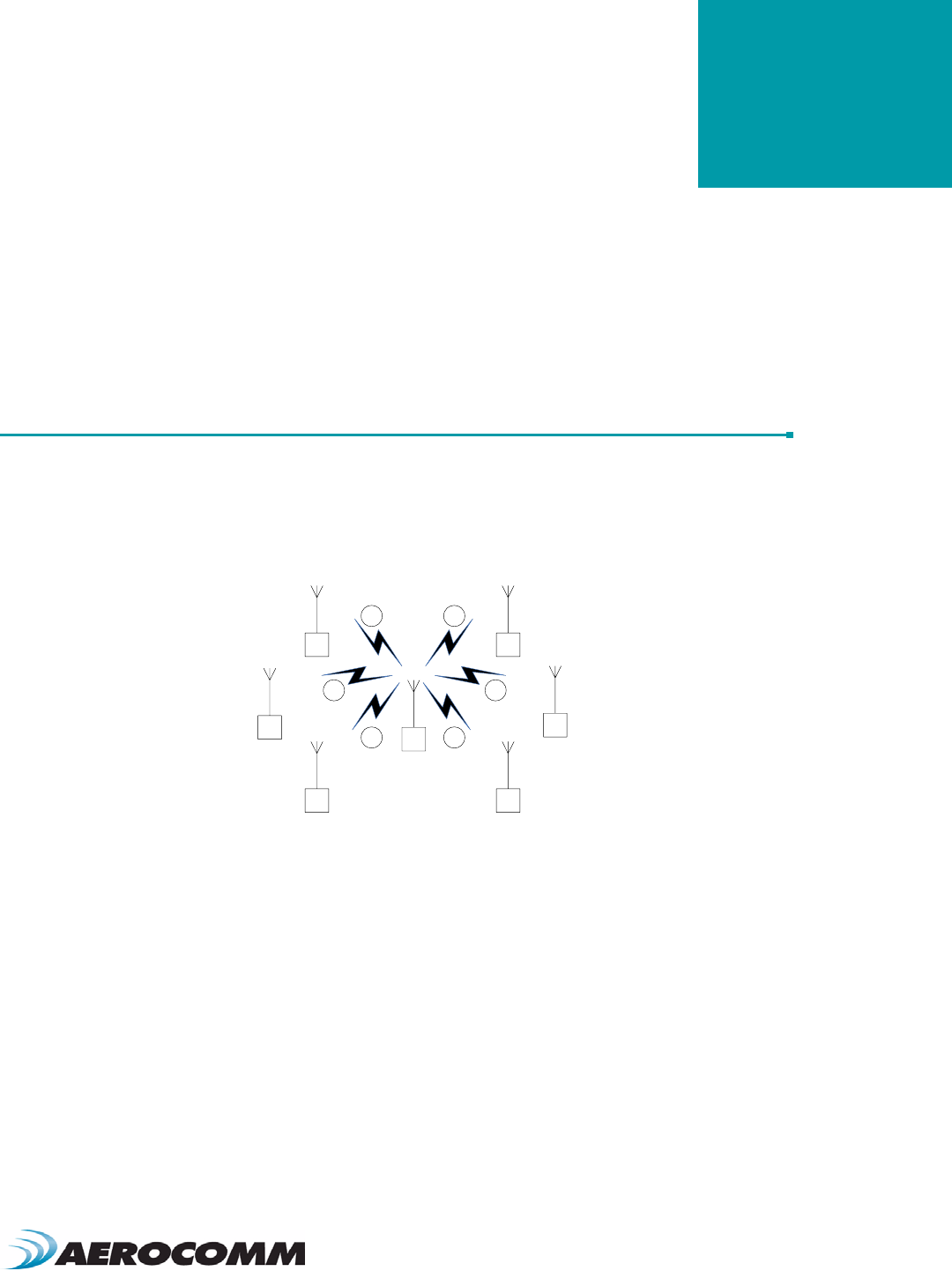
www.aerocomm.com
APPENDIX III - API
III
The API feature set of the AC4490 provides powerful packet routing capabilities to the OEM Host. The number of API
configurations is endless as individual radios can all be configured differently to suit the OEM Host’s varying needs.
Some of the most common implementations are described in the following pages.
POLLING NETWORK
Many applications require multiple locations to report back to a single access point. One solution would be to enter
Command mode, change the transceiver’s destination address and then exit Command mode to resume normal
operation. When it is time to communicate with another transceiver, the process would be repeated; costing time and
inevitably reduction in throughput as unnecessary commands are issued. As an alternative, the Transmit API
command can be used to control packet routing on a packet-by-packet basis.
The simplest implementation consists of a smart Shared Access Point (SAP) with a microcontroller or processor of
some type which has transmit API enabled. The SAP controls which transceiver(s) each packet is routed to.
Broadcast packets should be used when all remotes are to receive the same message and addressed packets when
communication with a single remote only is desired. An example of each is shown in the following pages.
MAC 12 34 56
Shared Access Point
MAC 12 34 A3
MAC 12 34 A2MAC 12 34 A1
MAC 12 34 A6
MAC 12 34 A4
MAC 12 34 A5
Channel: 0x10
System ID: 0x01
1 2
3
45
6
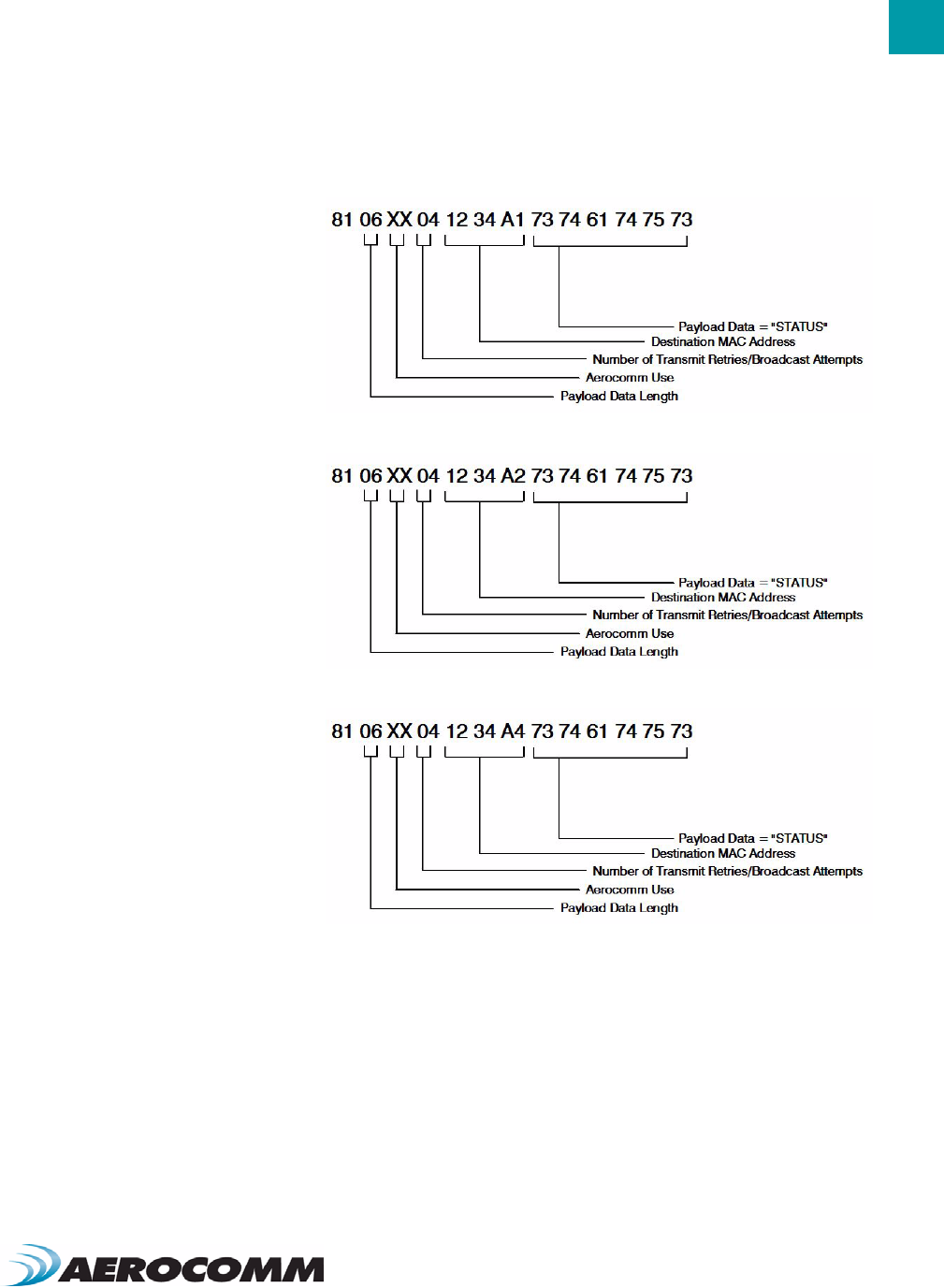
53
APPENDIX III - API
www.aerocomm.com
Addressed Transmit API
1To poll radio 1, the SAP transmits the packet using the following format:
2To poll radio 2, the SAP transmits the packet using the following format:
3To poll radio 2, the SAP transmits the packet using the following format:
4This continues until all radios have successfully been polled by the SAP.
Broadcast Transmit API
To send out a universal poll request or data packet, the OEM may wish to utilize the broadcast portion of the Transmit
API command. The Broadcast command is similar to the addressed command; only with the Destination MAC
Address set to all 0xFF.
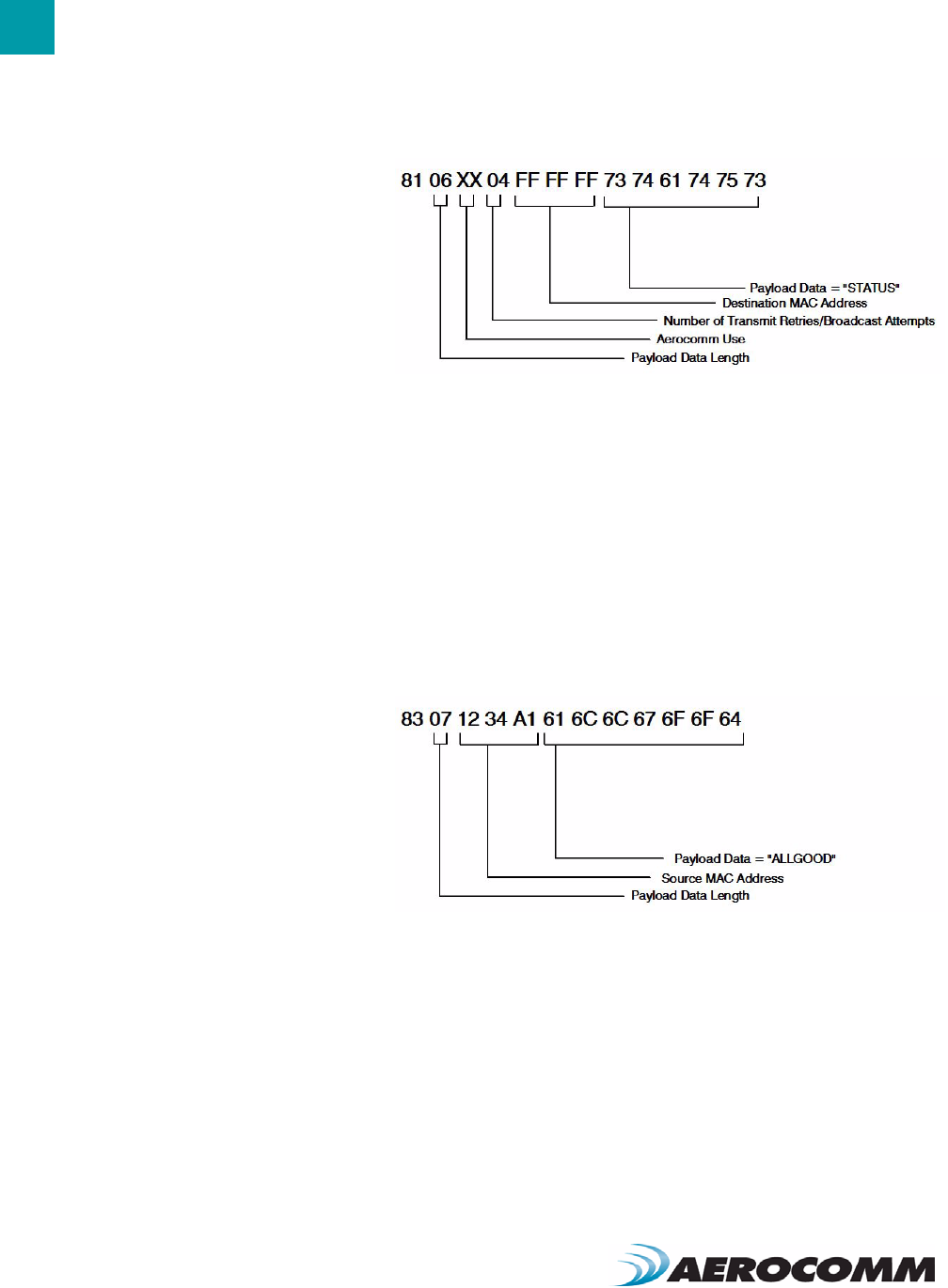
APPENDIX III - API
54
The remote response is dependent on the OEM’s specific needs and equipment. In many cases, remote radios are
connected to dumb devices without the intelligence to filter out or append specific portions of a packet that is
transmitted or received. Since the 7 bytes of overhead in the Transmit API command are not sent over the RF, the
remotes will receive only the payload data, “STATUS”. If auto destination is enabled on the remote radio, the
transceiver will automatically change its destination address to that of the radio it last received a packet from. When
the remote device sends its response, it will therefore automatically be routed back to the SAP.
Depending on the API configuration of the SAP, the packet will be received in one of two formats:
Receive API
When Receive API is enabled, the transceiver will receive the reply data + the MAC address of the source radio.
When Receive API is enabled, every packet received by the transceiver will be sent to the Host in the following format.
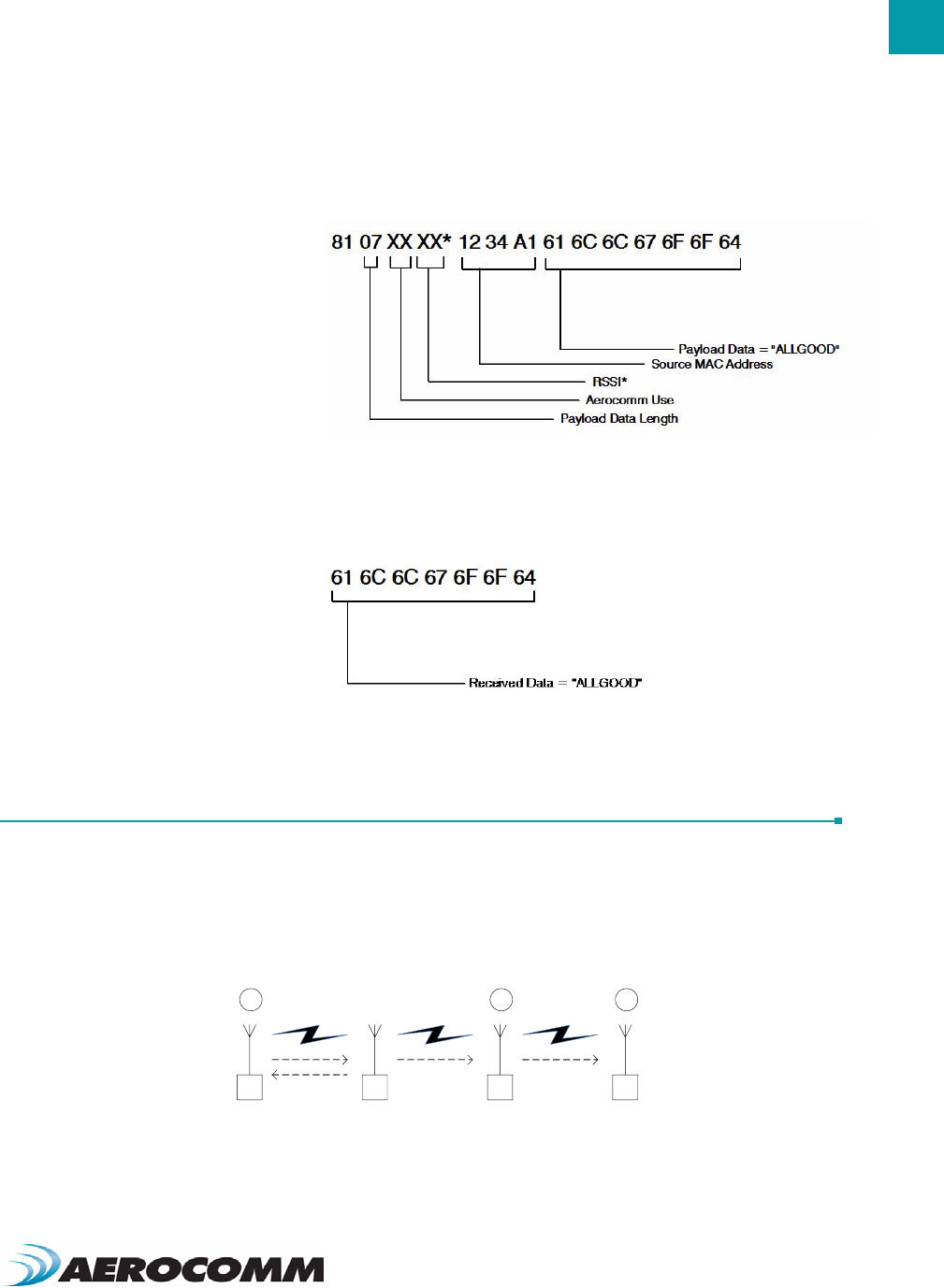
55
APPENDIX III - API
www.aerocomm.com
Enhanced Receive API
When Enhanced Receive API is enabled, the transceiver will receive the reply data + the MAC address of the source
radio and one RSSI value; RSSI* is how strong the local heard the remote transceiver.
It may be useful to the OEM Host to determine which radio each packet originated from. When Enhanced Receive API
is enabled, every packet received by the transceiver will be received in the above format.
Normal Receive Mode (non-API)
If Receive API is not enabled, the transceiver will receive the reply data only (i.e. “ALLGOOD”) from each transceiver.
LOOPBACK REPEATER
The simplest repeater to implement is a loopback repeater. A loopback repeater can be created by connecting the
transceiver’s RXD and TXD lines together. When the radio receives data, it will retransmit the data to all available
transceivers on the network. It is important not to have two loopback repeaters in range of each other as they will
continuously transmit data back and forth.
If radios B & C in the above picture are not within range of radio A, they will not be able to receive or respond to
communications from radio A. A loopback repeater can be added between the three such that it is in range of both
radio A and radios B & C. When the repeater receives a packet from radio A, it will transmit the packet out to radios B
MAC 12 34 56 MAC 12 34 A3MAC 12 34 A2MAC 12 34 A1
Loopback Repeater
A B C
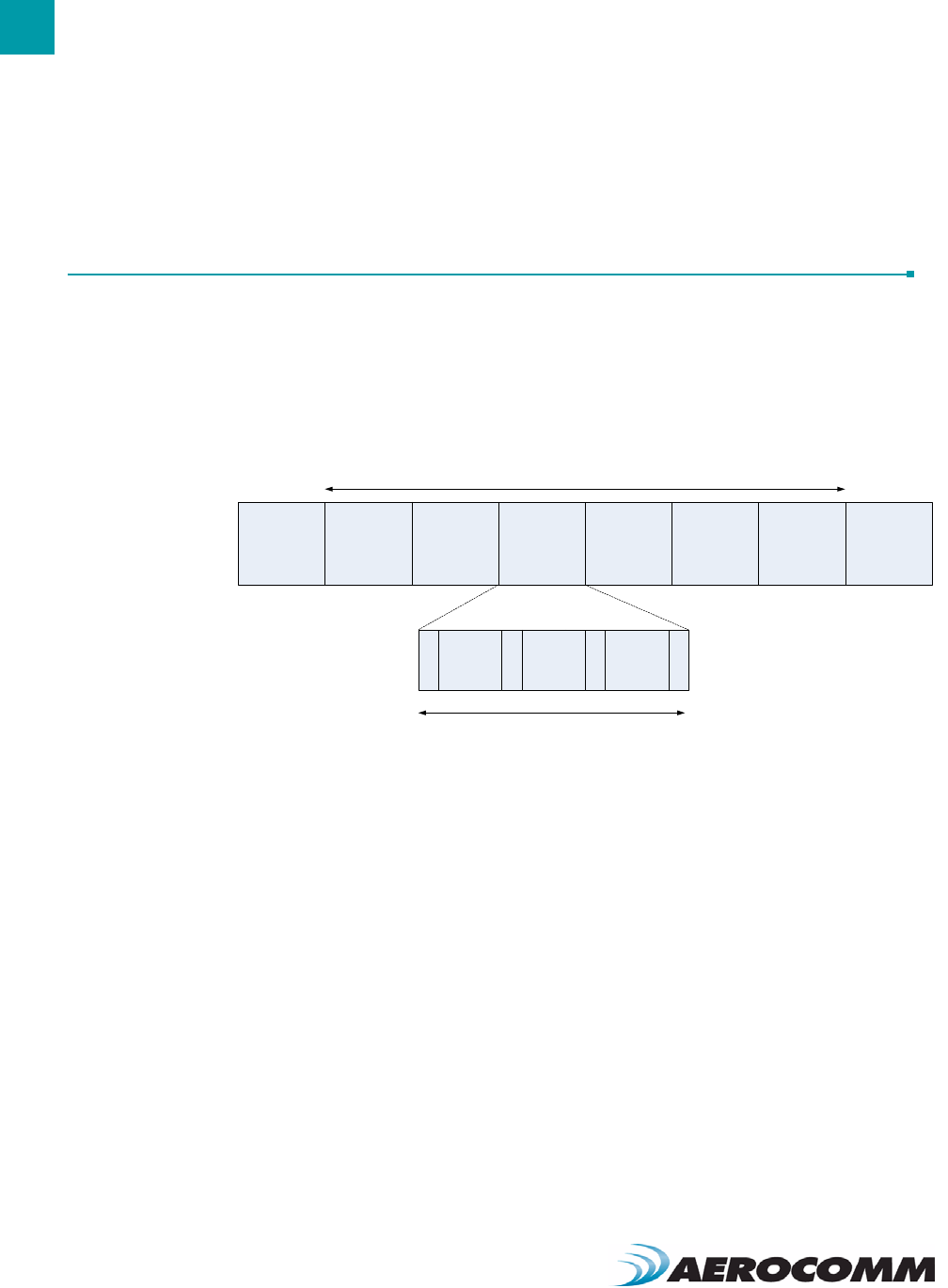
APPENDIX III - API
56
& C. If the repeater is set to Broadcast mode, radio A will receive a copy of each packet that it sends. If the repeater
has a specific destination address (i.e. 12 34 A2), then radio A will not receive the packet as its MAC address will not
match the specified destination address.
TIME DIVISION MULTIPLE ACCESS NETWORK
For a more intelligent network, a TDMA system can be implemented. In this system various radios transmit data to a
Shared Access Point (SAP) during an assigned time interval. The system is synchronous so that only one radio is
transmitting at a time and has full access to the SAP’s bandwidth. In a TDMA network, each radio must store its data
for the amount of time between its transmissions or bursts. A typical format for data passing through a SAP is shown
below. A frame consists of arriving bursts from remote radios and each frame is then divided into multiple time slots.
The bursts can be of varying lengths and can be longer for heavy-traffic stations. To prevent overlaps, guard intervals
can be inserted to absorb small timing errors in burst arrivals.
Example:
•Shared Access Point (SAP) sends broadcast packet which includes a sync pulse
•Remote radios hear the sync pulse and join the session
•Radio A transmits during time interval t = 1
•Radio B transmits during time interval t = 2
•Radio N transmits during time interval t = N - 1
This type of implementation requires careful planning and should allow enough time for retries if necessary. When full
duplex is enabled, the radio which initiated the Session (SAP) will transmit during the even numbered hops and the
remote radios will transmit only during odd numbered hops.
123456
GB1 Radio A Data GB2
Radio B Data
GB3
GB4
Radio C Data
6
1
TDMA Frame
1 Timeslot
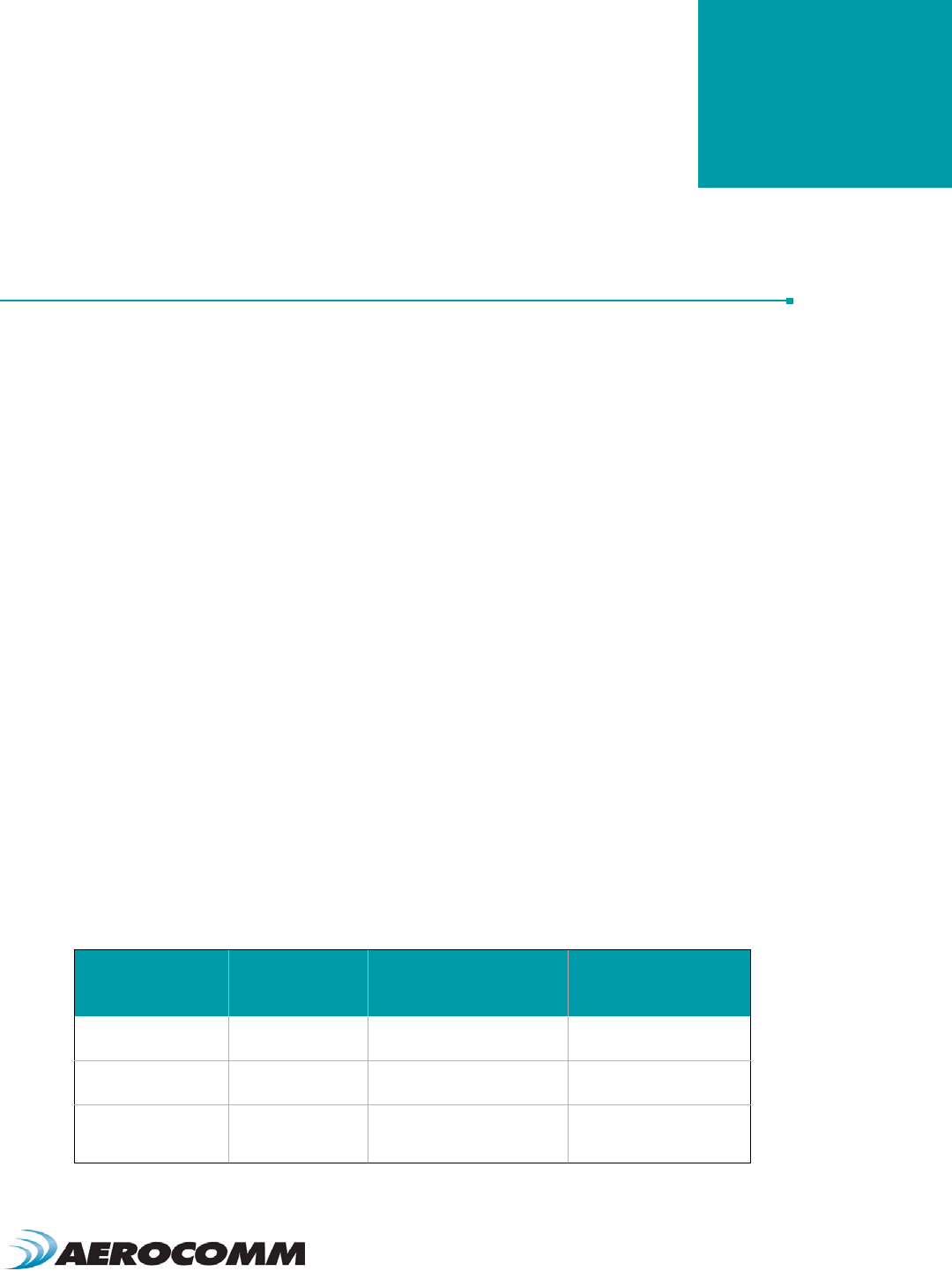
www.aerocomm.com
APPENDIX IV - SYNC TO CHANNEL
IV
SYNC TO CHANNEL
What is it and do I need it?
AeroComm uses frequency hopping protocol with a fixed pseudo-random hopping sequence on our transceivers.
This protocol yields superior interference rejection and multipath immunity. The Server radio sends timing beacons
out on a regular interval and the Clients hear these beacons and synchronize their frequency hopping to the Server.
Though Servers cannot send packets to each other, they can hear the timing beacons sent out by other Servers.
Normally, they simply ignore the beacons sent out by the other Servers. However, when Sync-to-Channel is enabled,
they will listen for the beacons sent out by another Server and then synchronize their hop timing to that Server.
Why is this important? If two Servers (and their Clients) are operating in the same area and their frequency hopping is
not synchronized to each other it's possible that they might try to occupy the same frequency at the same time. In
severe cases, they could interfere with each other on every frequency, causing very sluggish communications.
To avoid this kind of interference, collocated Servers can use Sync-to-Channel. Sync-to-Channel synchronizes the
frequency hop timing between these Servers so that they never occupy the same frequency at the same time.
To use Sync-to-Channel, you should select one Server (preferably the most centrally located Server) to be the "Hop
Master." This Server should be programmed to a numerically low Channel Number and should have Sync-to-Channel
disabled. All other Servers in the area should have Sync-to-Channel enabled. These other Servers should have Sync-
Channel set to the Channel of another Server in the area that they are in range of. Preferably, if all Servers are in
range of the Hop Master, they should all have their Sync-Channel set to the Channel Number of the Hop Master. The
following rules apply to Sync-to-Channel:
One Server should perform the function of Hop Master. It should have its Channel Number set to a numerically low
value and should have Sync-to-Channel disabled. It's preferable that it be centrally located. All other Servers in the
area should have Sync-to-Channel enabled. They should have their Sync-Channel set to a value lower than their
Channel Number. If they are in range of the Hop Master, its preferable that they have the Sync-Channel set to the
Channel Number of the Hop Master.
All collocated Servers must be programmed to the same Channel Set. There are 56 available channels for the
AC4490, shown in Table 19 below.
Table 20: RF Channels for AC4490
Channel Set1
1. All collocated Servers must operate in the same Channel Set.
RF Channel
Number Range
(0x40)
Frequency Details &
Regulatory requirements Countries
0 (AC4490 - 1x1
AC4490 - 200)
0x00 - 0x0F 902 - 928 MHz (26 hop bins) US / Canada
1 (AC4490 - 1x1
AC4490 - 1000)
0x10 - 0x2F 902 - 928 MHz (50 hop bins) US / Canada
2 (AC4490 - 1x1
AC4490 - 200
AC4490 - 1000)
0x30 - 0x37 915 - 928 MHz (22 hop bins) US / Canada (-1x1 / -200)
Australia(-1x1/-200/-1000)
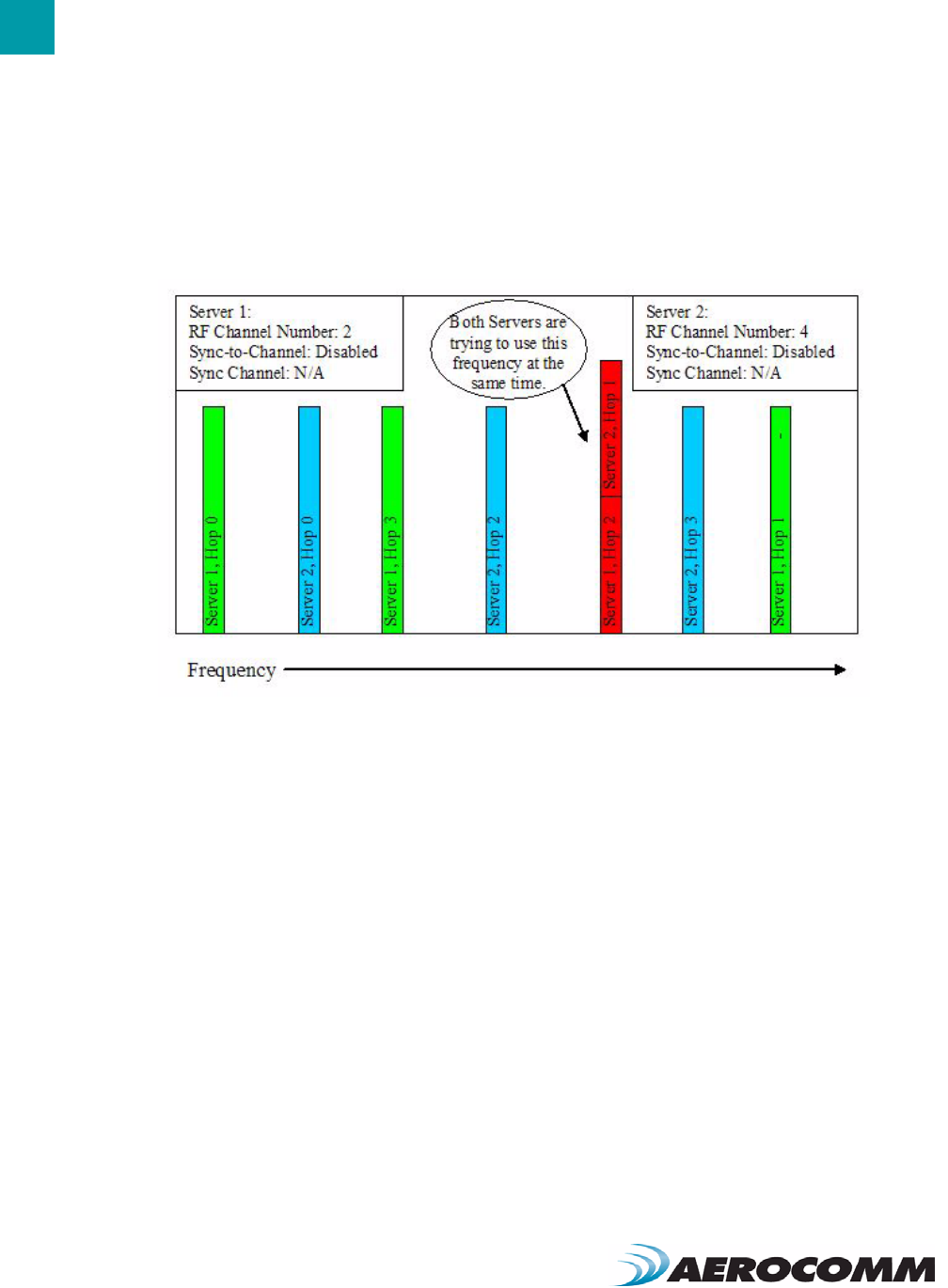
APPENDIX IV - SYNC TO CHANNEL
58
What happens if you don't enable Sync-to-Channel and you have collocated Servers? You have good odds that you
will see a decrease in throughput due to the systems trying to occupy the same frequency at the same time. In severe
cases, you could lose communications all together depending on how much bandwidth your system requires. Due to
crystal differences between the Servers, you could see the interference come and go.
Figure 14: Servers without Sync-to-Channel Enabled
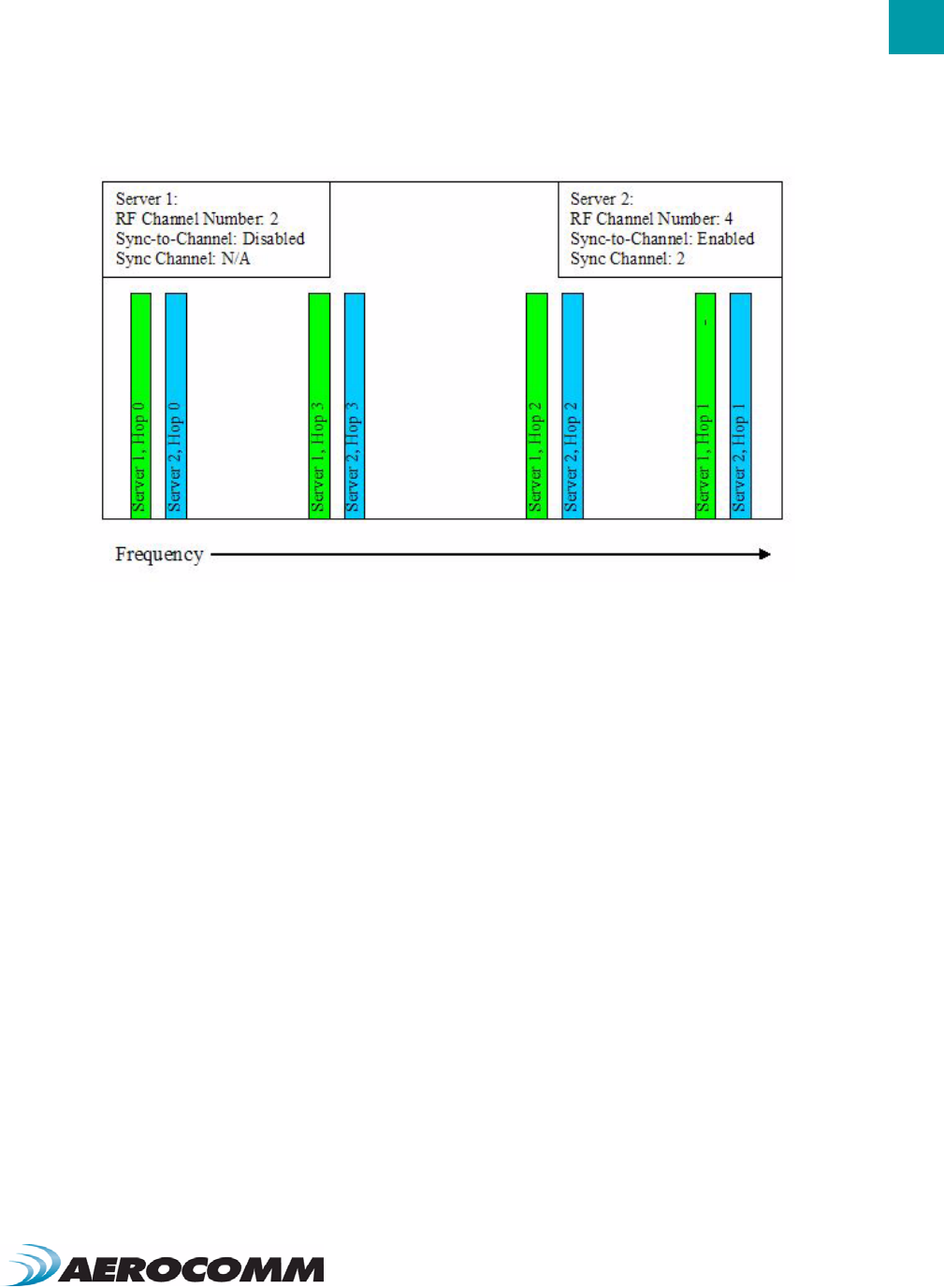
59
APPENDIX IV - SYNC TO CHANNEL
www.aerocomm.com
Figure 15: Servers with Sync-to-Channel Enabled
How do I configure Sync to Channel?
To configure sync to channel, you must use our OEM configuration software. This can be downloaded from our
website http://www.aerocomm.com by clicking the software link at the top of the screen and selecting the Developer
Kit Software.
You will be prompted to install the software on your PC. Once the install is completed, you can open the software
from Start -> All Programs -> Aerocomm Wireless -> Aerocomm OEM.exe
1. The software will open and prompt you to select a product. Select AC4490 as the product on the PC settings page
(Figure 16).
2. Verify that the Read/Write with AT commands box is checked.
3. Select the COM Port that your radio is connected to. If you are unsure, press the Find Ports button and the drop
down list will be updated with available COM ports.
4. Select the baud rate that matches the baud rate that the radio is programmed to.

APPENDIX IV - SYNC TO CHANNEL
60
Figure 16: PC Settings Page
5. Go to the Configure page and click the read radio button at the bottom right of the screen. A message stating
"Read Successful" should appear after a successful read (Figure 17).
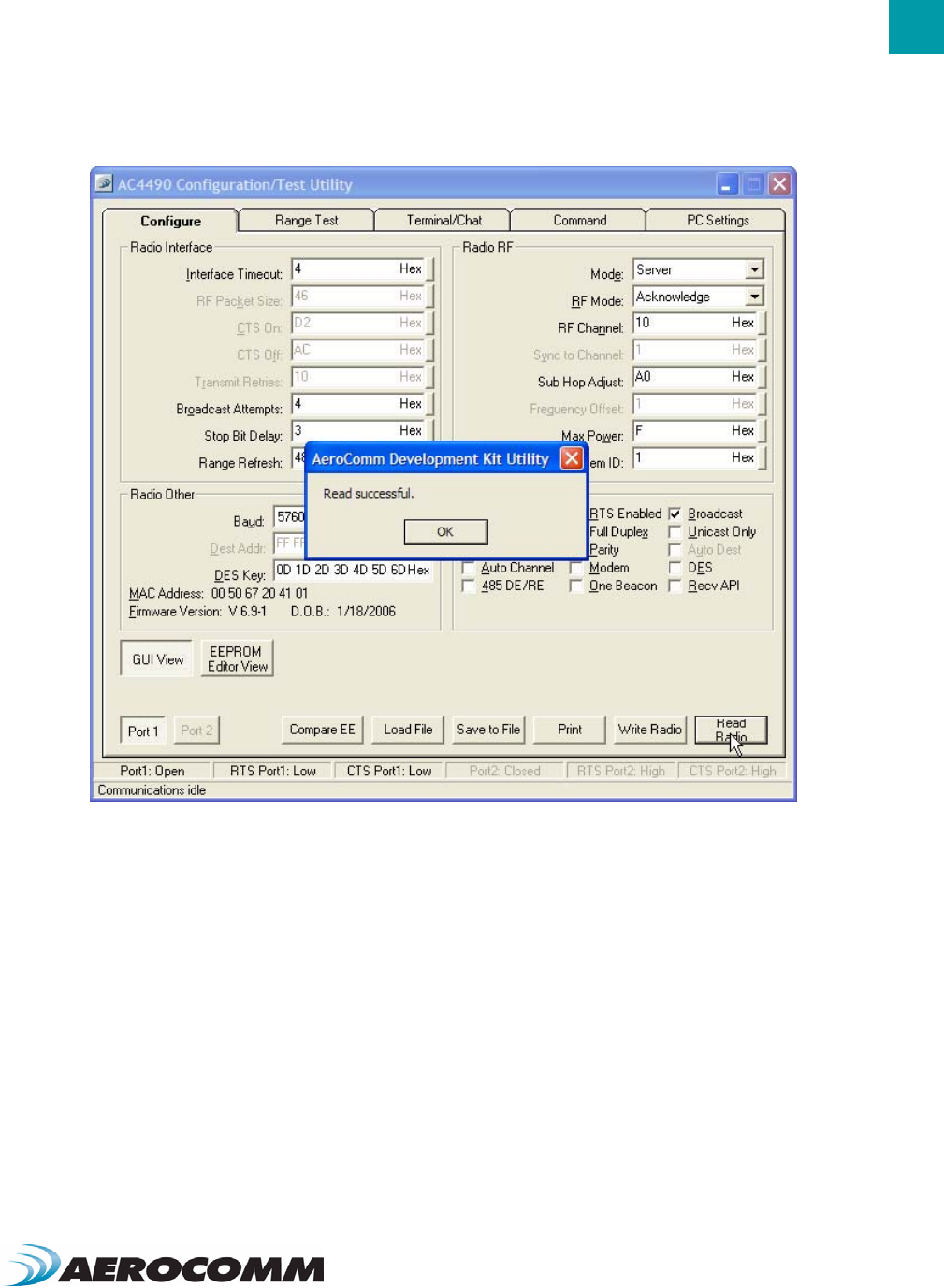
61
APPENDIX IV - SYNC TO CHANNEL
www.aerocomm.com
Figure 17: Configure Page - Read Successful
6. To configure the hop master, change the Mode to Server and select Broadcast. Make note of the RF Channel
(Figure 18). Once the appropriate changes have been made, press the Write Radio button. A Write Successful
prompt will appear after a successful write.
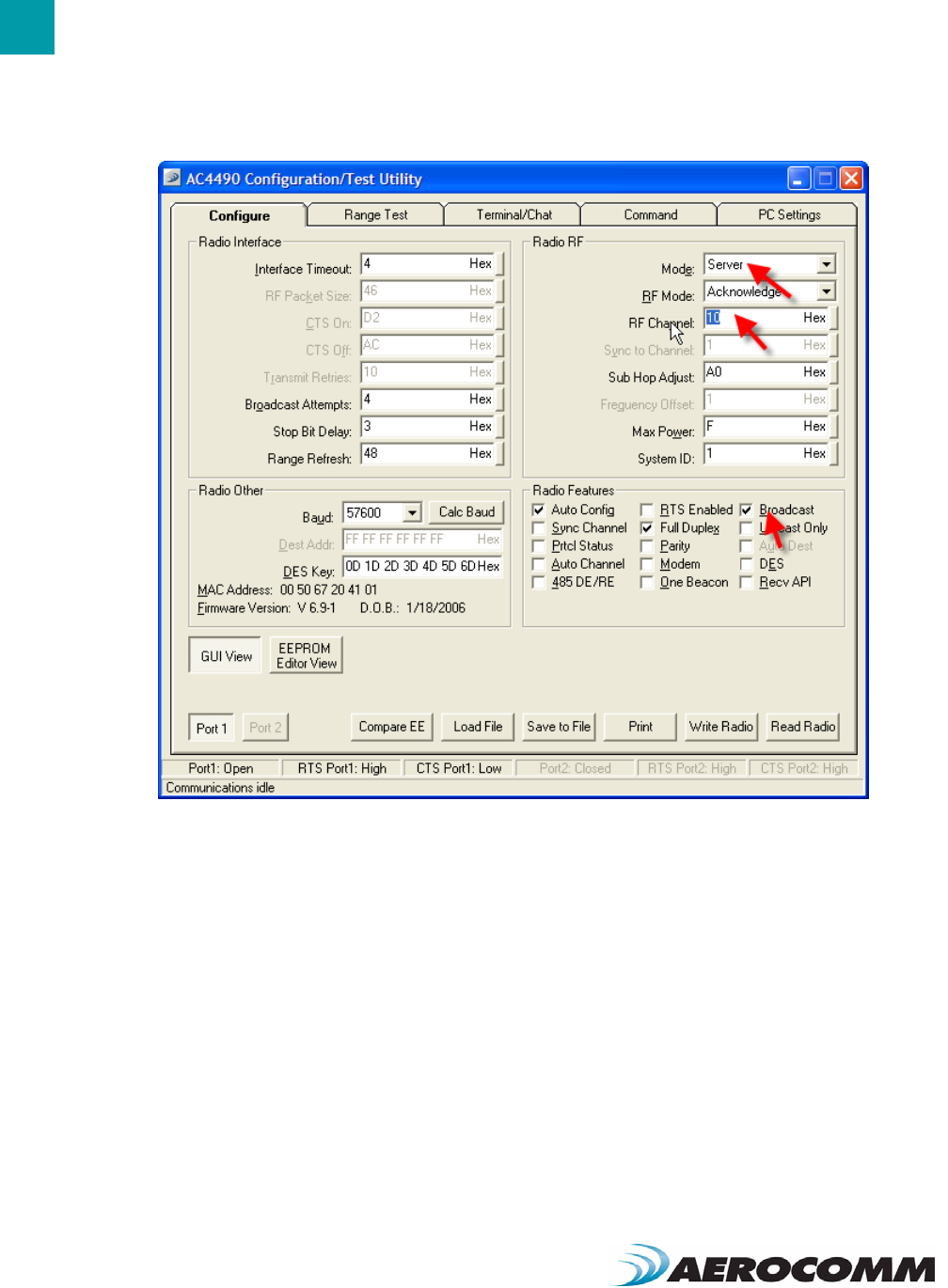
APPENDIX IV - SYNC TO CHANNEL
62
Figure 18: Hop Master Settings
7. Configure all clients that will communicate with the hop master as Clients in Auto Destination and with the same RF
channel as the hop master (Figure 19) and press the Write Radio button.
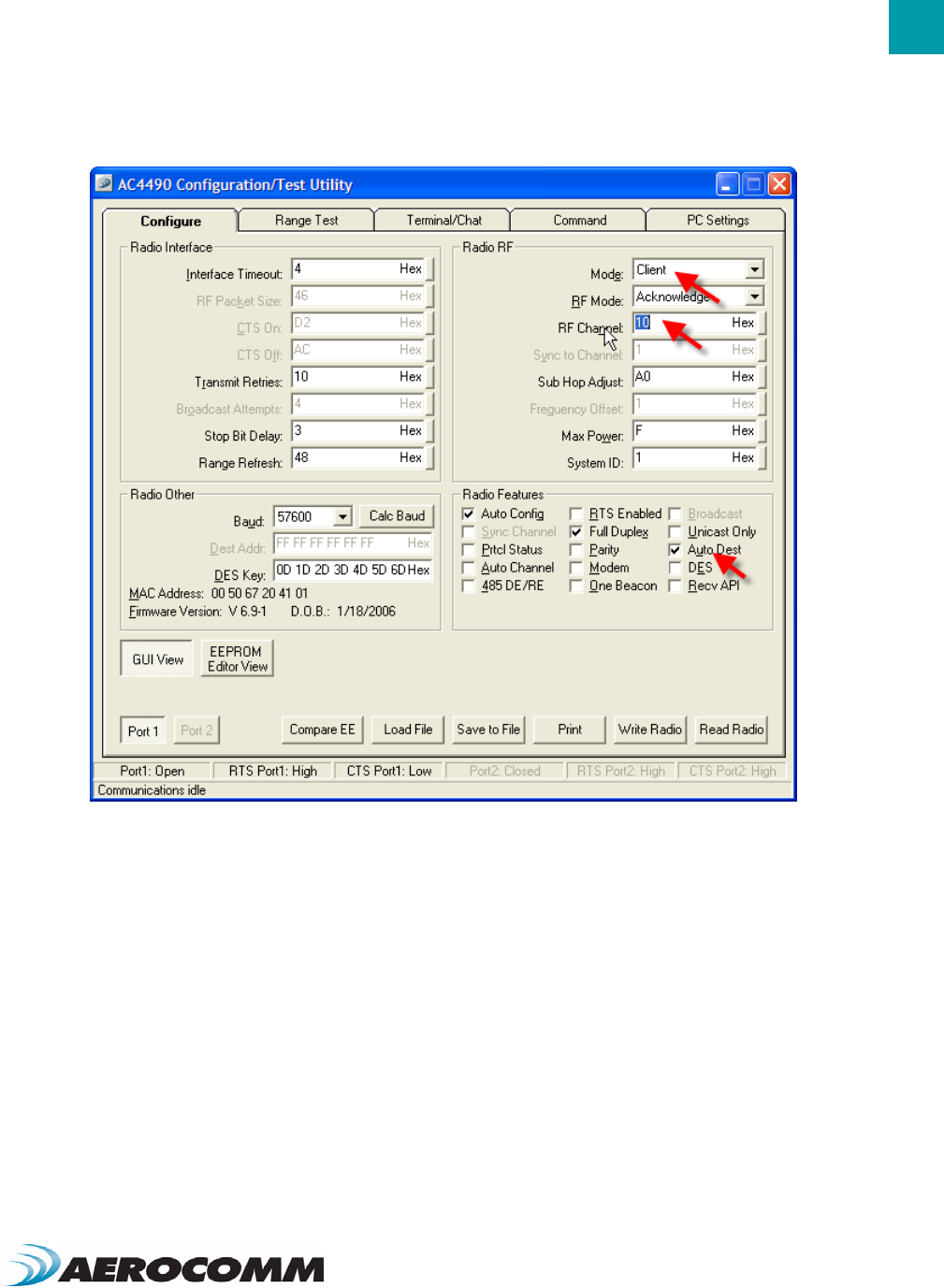
63
APPENDIX IV - SYNC TO CHANNEL
www.aerocomm.com
Figure 19: Client Settings
8. Set the second server as a server in broadcast mode with an RF channel at least 2-5 steps above the RF channel of
the hop master. Under the radio features section, select the Sync Channel box and in the Radio RF section, set the
Sync to Channel to the RF channel of the hopmaster (Figure 20). Press the Write Radio button to write the changes to
the radios EEPROM.

APPENDIX IV - SYNC TO CHANNEL
64
Figure 20: Server #2 Settings
9. Configure the Clients that will communicate with Server #2 as Clients in Auto Destination and with the same RF
channel as Server #2 (Figure 21). Press the Write Radio to write the changes to the radios EEPROM.
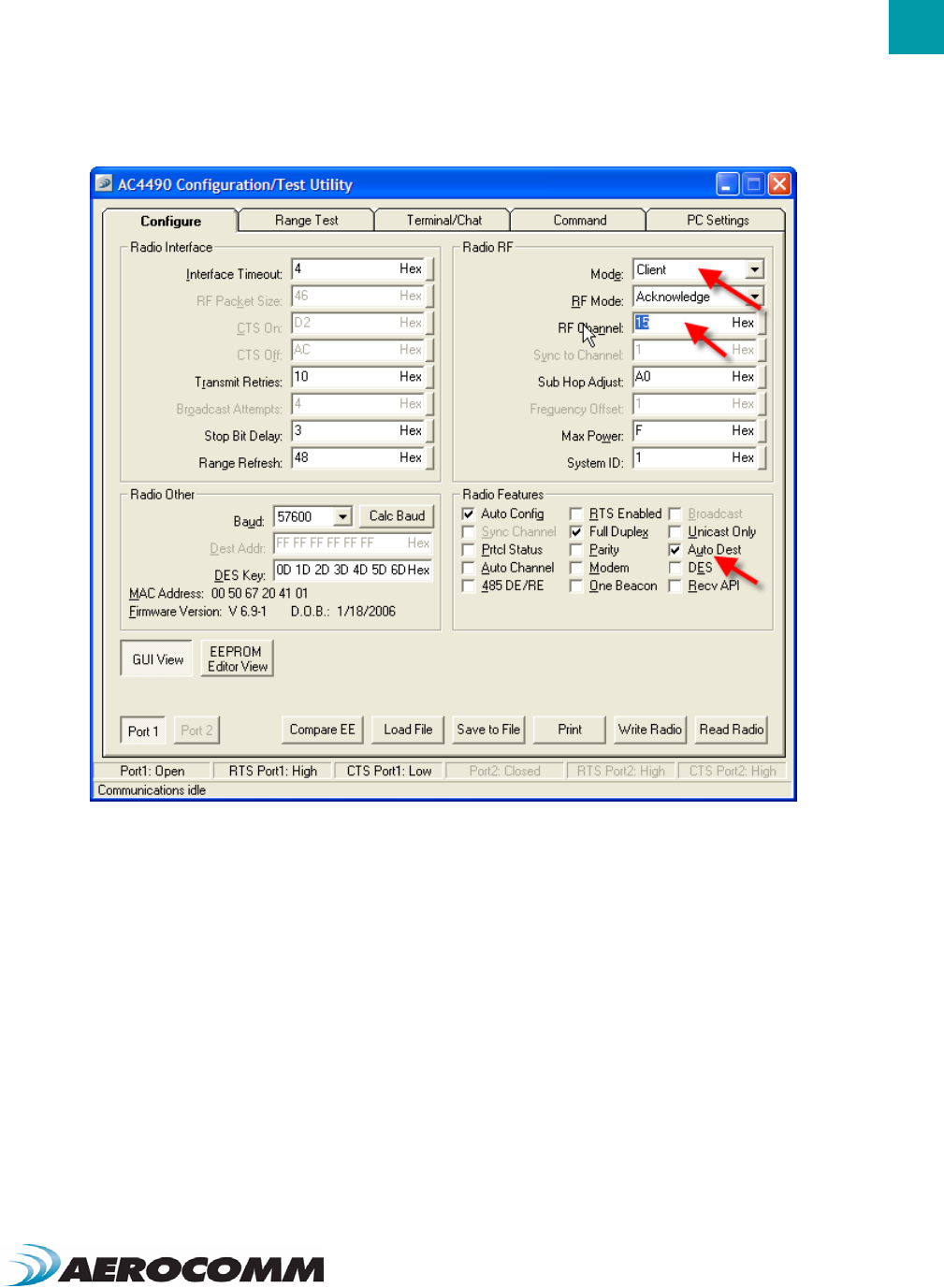
65
APPENDIX IV - SYNC TO CHANNEL
www.aerocomm.com
Figure 21: Client Settings
I've configured my radios, what's next?
Once you have configured all radios, your network should be setup similar to the one shown in Figure 22 below. The
main server or hop master will need to be powered on anytime that the other servers are connected or they will never
synchronize and will not be able to communicate with their clients. If a centralized network will not work and all
servers will not be in range of the hop master, a daisy chain network can be utilized as shown in Figure 23.
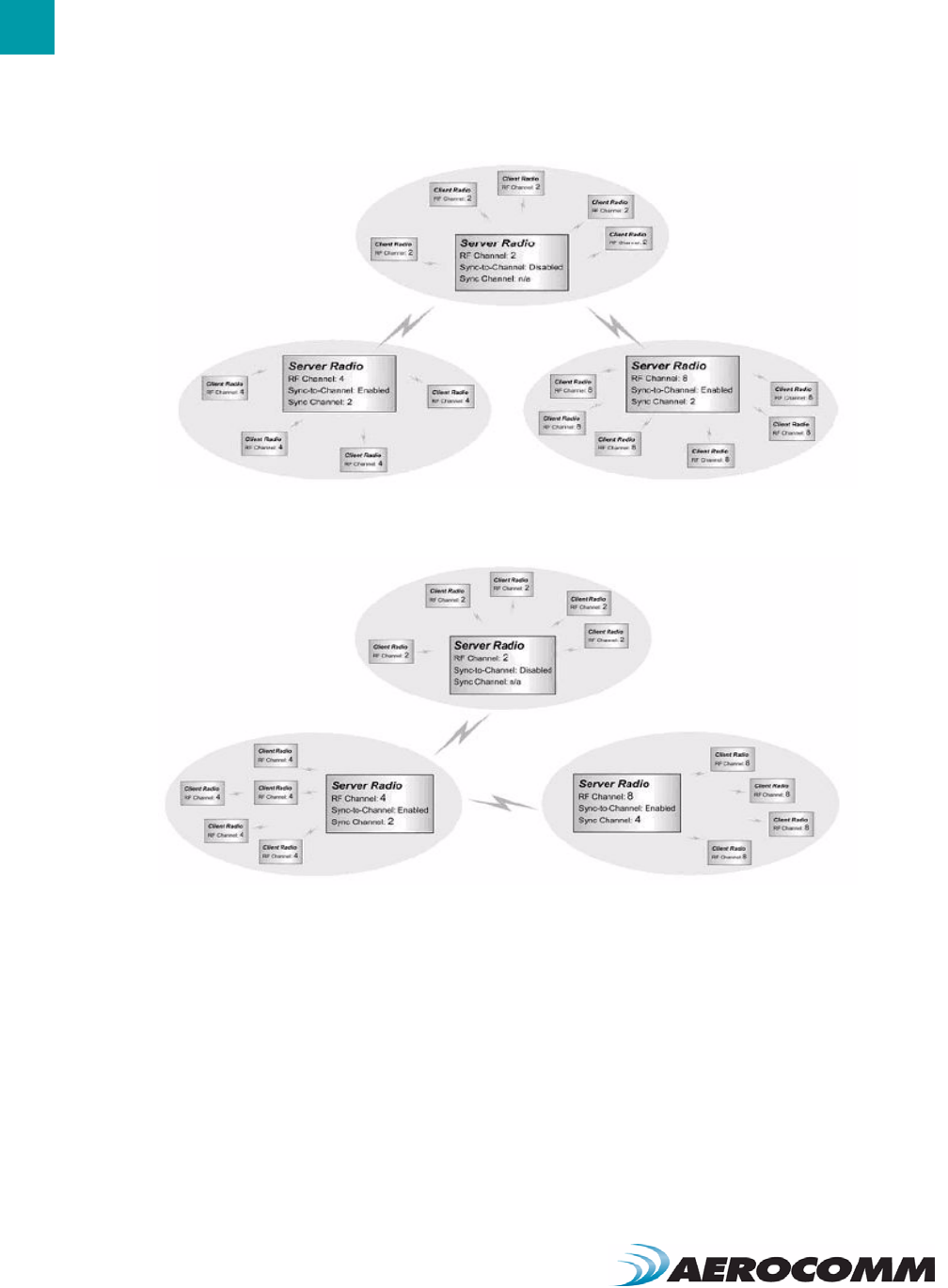
APPENDIX IV - SYNC TO CHANNEL
66
Figure 22: Centralized Sync-to-Channel Configuration
Figure 23: Daisy Chain Sync-to-Channel Configuration
